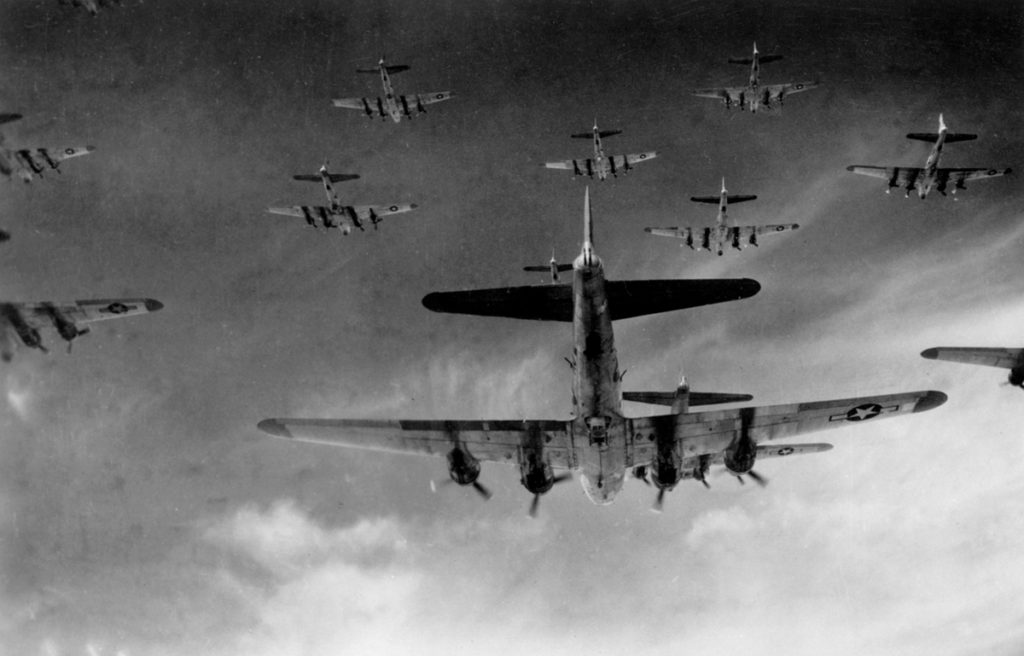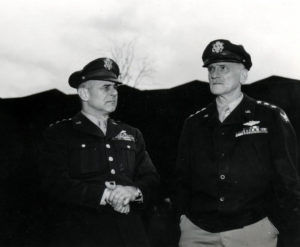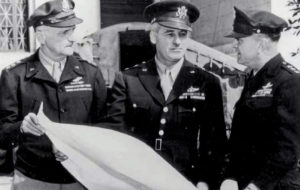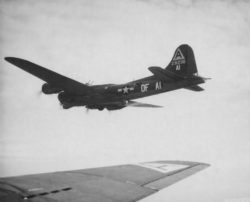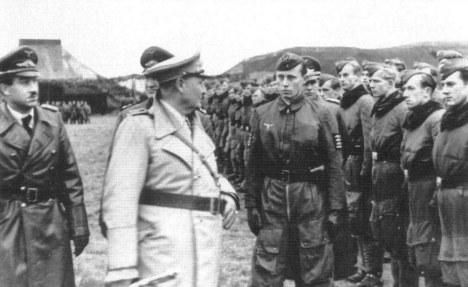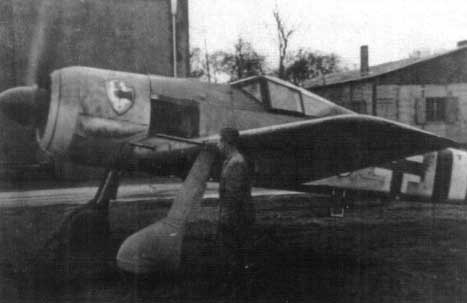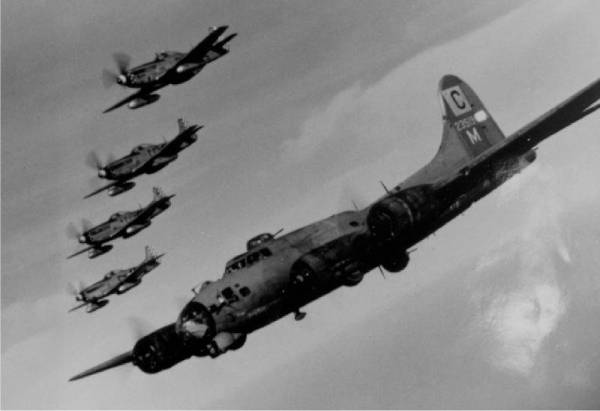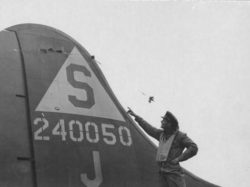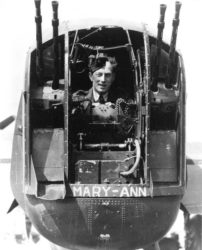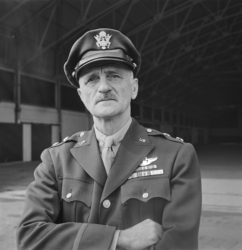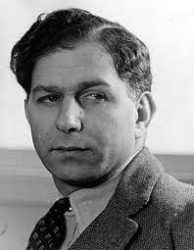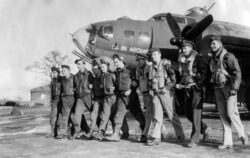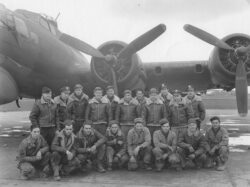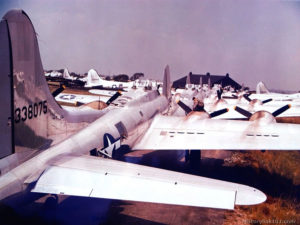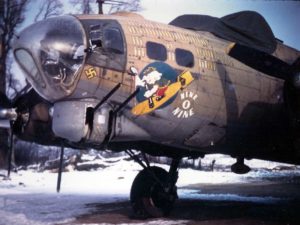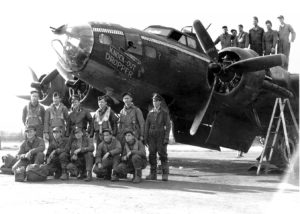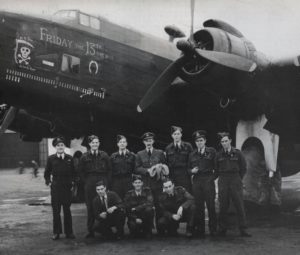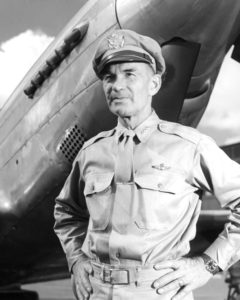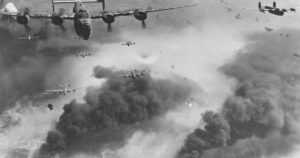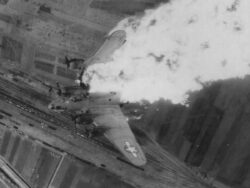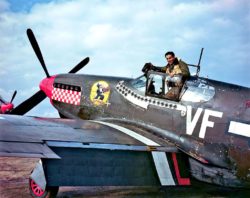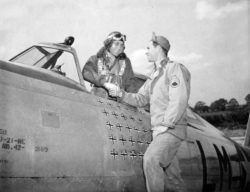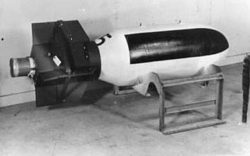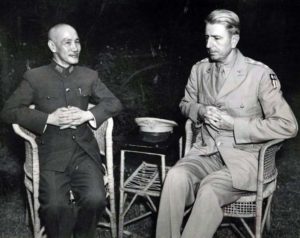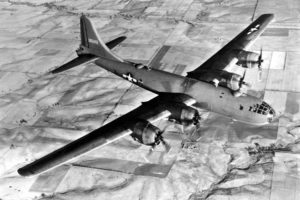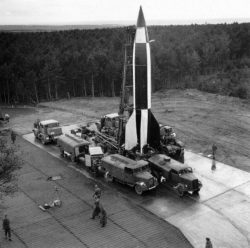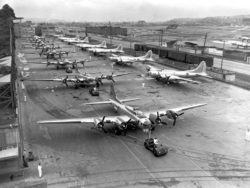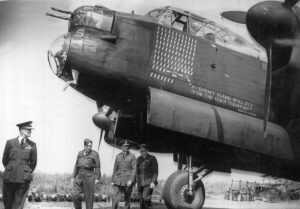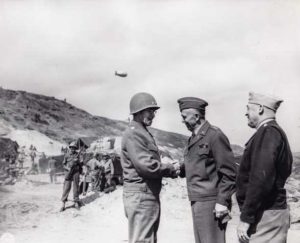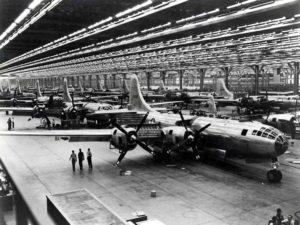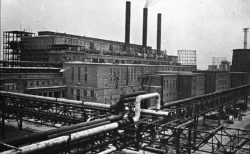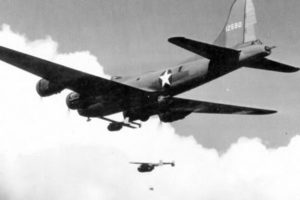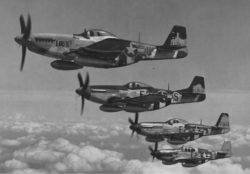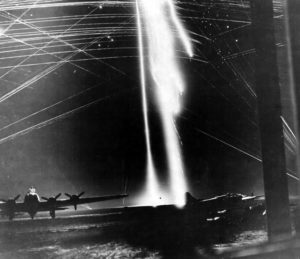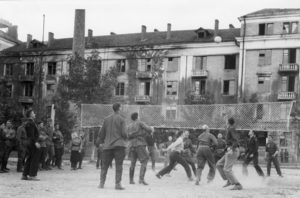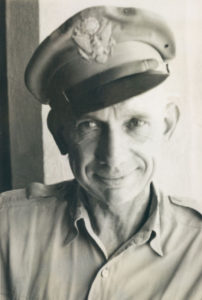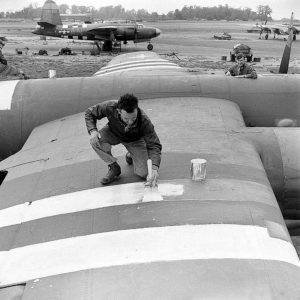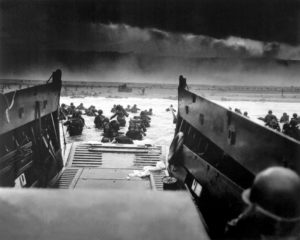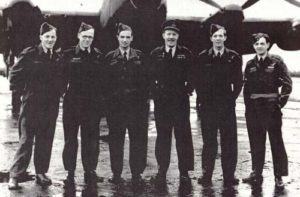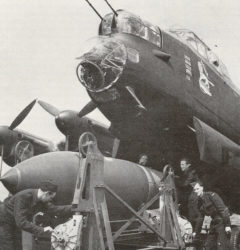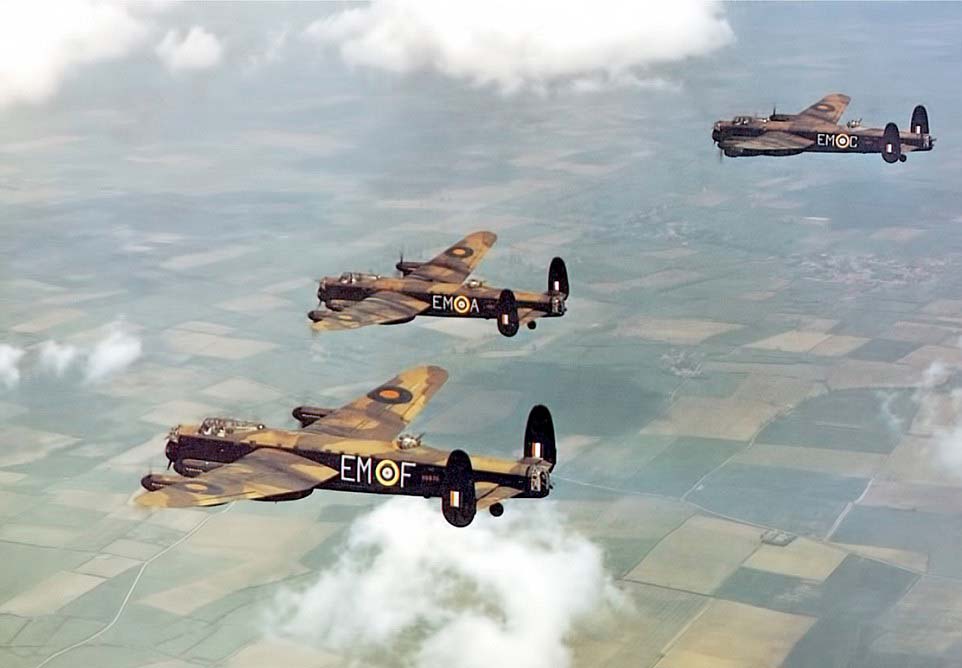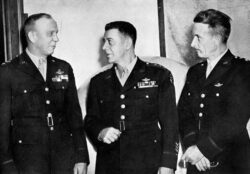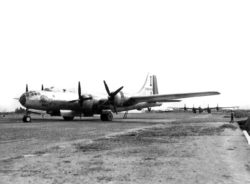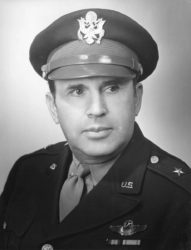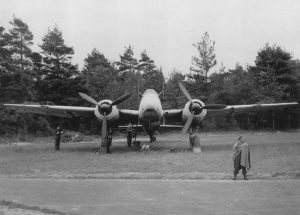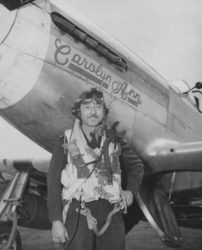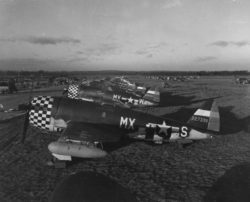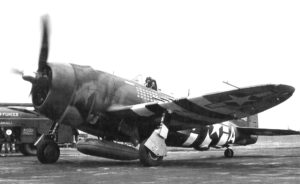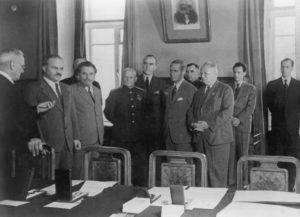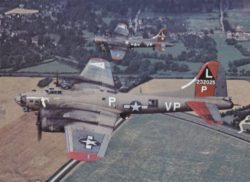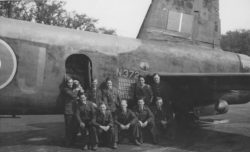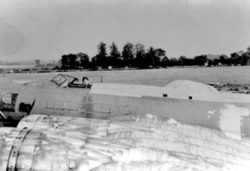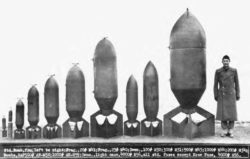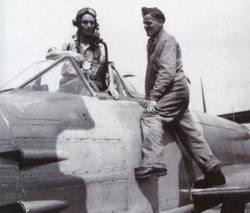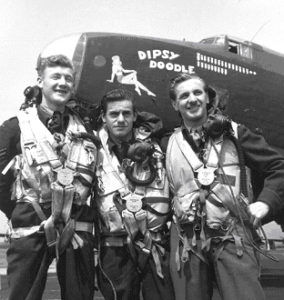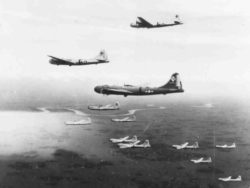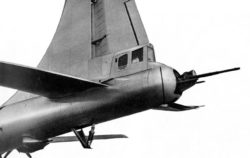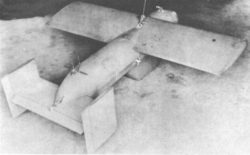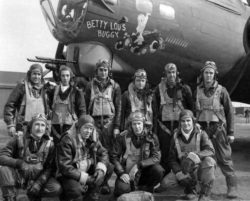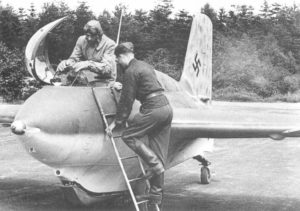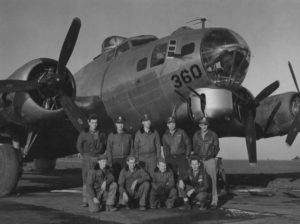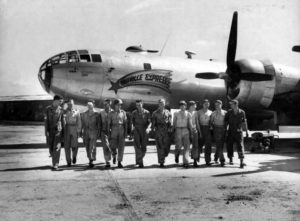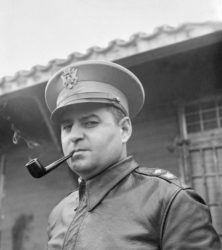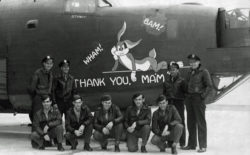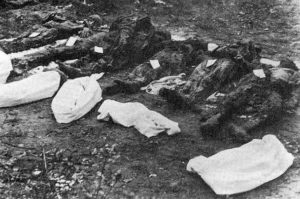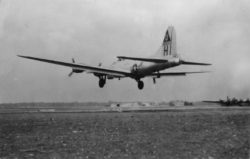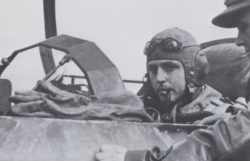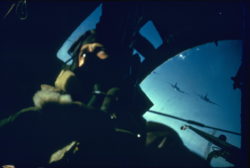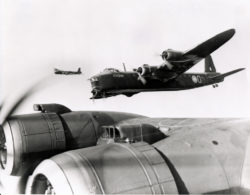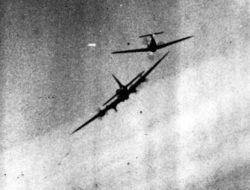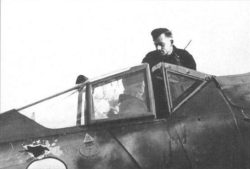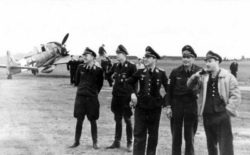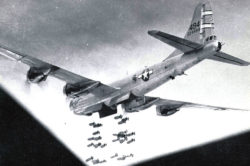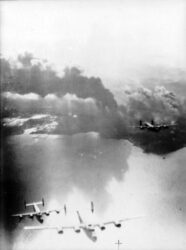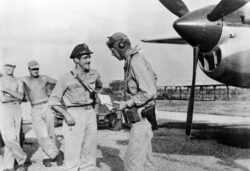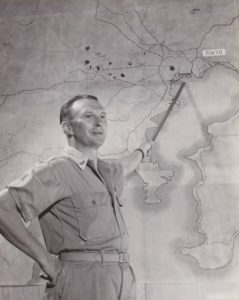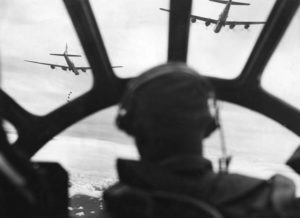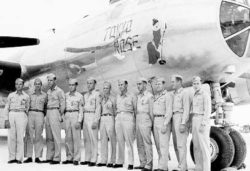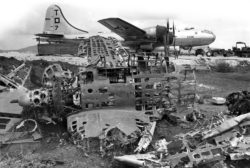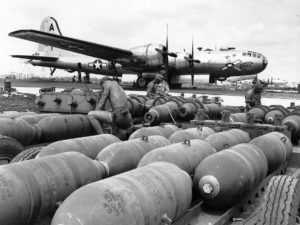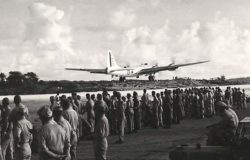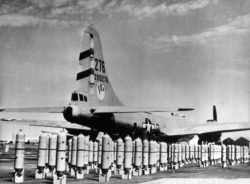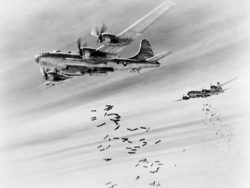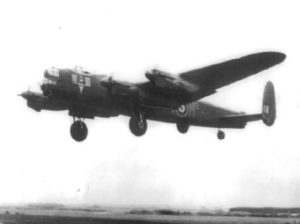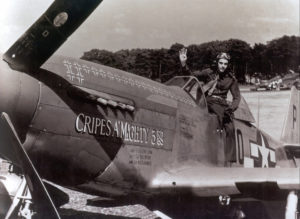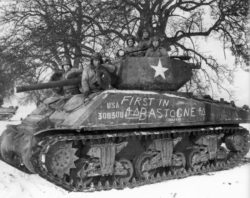Timeline of Strategic Aviation
Second World War
1944
6 JANUARY 1944
The US Strategic Air Forces in Europe (USSTAF) is created, LTG Carl A. Spaatz commanding. A product of SEXTANT, USSTAF has operational control of the 8AF (MG Jimmy H. Doolittle) and 15AF (MG Nathan F. Twining), both now dedicated strategic forces. Similarly, the 9AF (MG Lewis H. Brereton) and 12AF (MG John K. Cannon) are now dedicated tactical air forces, reporting to AVM Trafford Leigh-Mallory. As such, the air forces no longer have independent bomber and fighter commands, but rather, become commands themselves. LTG Ira C. Eaker, till then CG 8AF, is promoted to CG Mediterranean Allied Air Forces (MAAF), becoming the senior airman in Italy under CINC FM Sir Henry M. Wilson.
Upon Doolittle’s first meeting with CG VIII FC MG William E. Kepner, Doolittle makes perhaps his most drastic decision as CG 8AF. Seeing a sign in Kepner’s office reading “THE FIRST DUTY OF THE EIGHTH AIR FORCE FIGHTERS IS TO BRING THE BOMBERS BACK ALIVE,” Doolittle orders him to remove the sign and replace it with one that reads “THE FIRST DUTY OF THE EIGHTH AIR FORCE FIGHTERS IS TO DESTROY THE GERMAN FIGHTERS.” In essence, Doolittle is ordering escort fighters to no longer be tied to their bomber wards: rather than wait for the German fighters to come to them, American fighter pilots are to seek out German fighters – in the air and on the ground. Bomber crews naturally contest this order, particularly after German interceptors begin using decoys to lead away American fighters so as to attack the bombers unopposed. Doolittle’s anecdote over this sign is an object of historical question as, not only do records show his superiors discussing this prior, but so far no photographs have come forward to prove the sign’s existence.
Click here to see the US Eighth Air Force order-of-battle (1944-1945).
Click here to see the US Fifteenth Air Force order-of-battle (1944-1945).
11 January 1944
The US 8AF launches 525 Boeing B-17s and 138 Consolidated B-24s, escorted by 49 Lockheed P-38s, 499 Republic P-47s, and 44 North American P-51s, against the Mühlenbau und Industrie (Construction Mills and Industries) of Braunschweig, the Junkers Flugzeugwerke (Junkers Aircraft Works) of Halberstadt, and the AGO Flugzeugwerke (Aviator Gustav Otto Aircraft Works) of Oschersleben, Germany. This is the first major operation launched under the command CG 8AF MG Jimmy H. Doolittle.
The strike is divided into two forces, with the 1AD led by XO 91BG LTC T. Ross Milton aboard Hell's Halo (42-5804), and the 2AD and 3AD led by XO 94BG LTC Louis G. Thorup. Shortly after reaching the IP, Doolittle issues a recall order due to poor weather. Weather, ever the bane of US operations over Europe, prevents the majority of the assigned escorts from rendezvousing with their wards, and many of the bombers release their loads over targets of opportunity. Doolittle does this again on 24 January, prompting a reprimand from CG USSTAF LTG Carl A. Spaatz.
| Bombers Launched: | 663 |
| Bombers Effective: | 551 |
| Fighters Launched: | 592 |
| Bombers MIA: | 60 |
| Bombers DBR: | 5 |
| Bombers Abort: | 112 |
| Fighters MIA: | 5 |
| Fighters DBR: | 3 |
| Abort Rate: | 17% |
| Loss Rate: | 10% |
| E/A Destroyed: | 58 |
| Aircraft Type | Serial No. | Name | Code | Unit | MACR |
| Boeing B-17F-20-DL | 42-3057 | Blonde Bomber | LG-N | 322BS/91BG | 1918 |
| Boeing B-17G-1-BO | 42-31076 | Chief Sly's Son | LG-X | 322BS/91BG | 1919 |
| Boeing B-17G-15-BO | 42-31372 | Harass Dragon | OR-P | 323BS/91BG | 1917 |
| Boeing B-17G-5-BO | 42-31230 | Little Jean | DF-A1 | 324BS/91BG | 1916 |
| Boeing B-17F-55-BO | 42-29487 | Ritzy Blitz | DF-K | 324BS/91BG | 1915 |
| Boeing B-17G-1-VE | 42-39758 | Sky Scrapper | NV-K | 325BS/92BG | 1921 |
| Boeing B-17G-5-BO | 42-31175 | Trudy's Ship | JW-N | 326BS/92BG | 1920 |
| Boeing B-17G-5-BO | 42-31216 | Patches | QE-L | 331BS/94BG | 1884 |
| Boeing B-17F-80-BO | 42-29961 | Passionate Witch | QE-V | 331BS/94BG | 1882 |
| Boeing B-17G-10-DL | 42-37798 | Big Stoop | QE-X | 331BS/94BG | 1883 |
| Boeing B-17F-75-DL | 42-3530 | XM-H | 332BS/94BG | 1885 |
| Boeing B-17G-1-VE | 42-39767 | XM-unk | 332BS/94BG | 1886 |
| Boeing B-17G-1-VE | 42-39775 | Frenesi | TS-A | 333BS/94BG | 12969 |
| Boeing B-17F-100-BO | 42-30425 | Roger Dodg'-Her | TS-J | 333BS/94BG | 1888 |
| Boeing B-17G-1-VE | 42-39822 | Miserable Bitch | TS-O | 333BS/94BG | 1887 |
| Boeing B-17F-95-BO | 42-30248 | Lassie Come Home | GL-X | 410BS/94BG | 1889 |
| Boeing B-17F-35-VE | 42-5918 | Heavenly Daze | ET-J | 336BS/95BG | 2010 |
| Boeing B-17F-75-DL | 42-3504 | Lady Jean | QJ-F | 339BS/96BG | 2376 |
| Boeing B-17F-25-BO | 41-24562 | Sky Wolf | VK-A | 358BS/303BG | 1925 |
| Boeing B-17G-1-VE | 42-39794 | VK-F | 358BS/303BG | 1929 |
| Boeing B-17F-125-BO | 42-30865 | VK-G | 358BS/303BG | 1927 |
| Boeing B-17F-50-BO | 42-5360 | War Bride | VK-N | 358BS/303BG | 1926 |
| Boeing B-17F-55-BO | 42-29524 | Meat Hound | VK-Q | 358BS/303BG | 4269 |
| Boeing B-17F-60-DL | 42-3448 | BN-W | 359BS/303BG | 1924 |
| Boeing B-17F-75-BO | 42-29894 | Baltimore Bounce | BN-X | 359BS/303BG | 1928 |
| Boeing B-17G-20-DL | 42-37896 | PU-B | 360BS/303BG | 1930 |
| Boeing B-17F-27-BO | 41-24587 | Bad Check | GN-P | 427BS/303BG | 1922 |
| Boeing B-17F-27-BO | 41-24619 | GN-S | 427BS/303BG | 1923 |
| Boeing B-17F-25-DL | 42-3131 | Flak Wolf | GN-U | 427BS/303BG | 1966 |
| Boeing B-17G-10-BO | 42-31236 | Arch Bishop | GY-F | 367BS/306BG | 1933 |
| Boeing B-17G-20-BO | 42-31451 | BIOYA | GY-G | 367BS/306BG | 1934 |
| Boeing B-17G-20-BO | 42-31538 | Norah | GY-V | 367BS/306BG | 1932 |
| Boeing B-17F-120-BO | 42-30782 | Rationed Passion | BO-O | 368BS/306BG | 1931 |
| Boeing B-17F-80-BO | 42-29993 | Carol June | WW-K | 369BS/306BG | 1935 |
| Boeing B-17G-5-VE | 42-39905 | YB-C | 508BS/351BG | 1937 |
| Boeing B-17F-120-BO | 42-30780 | Eager Eagle II | RQ-T | 509BS/351BG | 1938 |
| Boeing B-17F-75-BO | 42-29861 | Buck Shot | RQ-X | 509BS/351BG | 1936 |
| Boeing B-17G-20-BO | 42-31481 | TU-B | 510BS/351BG | 1941 |
| Boeing B-17F-75-DL | 42-3523 | April Girl | TU-M | 510BS/351BG | 1940 |
| Boeing B-17G-1-VE | 42-39761 | Fireball II | DS-D | 511BS/351BG | 1939 |
| Boeing B-17G-10-DL | 42-37768 | LF-J | 526BS/379BG | 1943 |
| Boeing B-17G-20-DL | 42-37962 | Betty Lou | VE-L | 532BS/381BG | 1876 |
| Boeing B-17F-30-VE | 42-5878 | Yankee Eagle | VP-Q | 533BS/381BG | 1874 |
| Boeing B-17G-15-BO | 42-31417 | Patches | VP-R | 533BS/381BG | 1879 |
| Boeing B-17G-10-DL | 42-37730 | VP-U | 533BS/381BG | 1877 |
| Boeing B-17F-75-DL | 42-3514 | Doll Baby | VP-V | 533BS/381BG | 1978 |
| Boeing B-17F-80-DL | 42-37719 | Hellcat | VP-X | 533BS/381BG | 1881 |
| Boeing B-17F-80-BO | 42-29999 | Fertile Myrle | VP-Z | 533BS/381BG | 1880 |
| Boeing B-17F-25-DL | 42-3118 | Green Hornet | GD-N | 534BS/381BG | 1875 |
| Boeing B-17F-90-BO | 42-30215 | Slightly Dangerous II | A | 560BS/388BG | 3127 |
| Boeing B-17G-15-DL | 42-37867 | Berlin Ambassador | unk | 561BS/388BG | 3140 |
| Boeing B-17G-5-VE | 42-39879 | CC-A | 569BS/390BG | 2023 |
| Boeing B-17G-1-BO | 42-31033 | Pee-Tay-Kun | IN-B | 613BS/401BG | 2507 |
| Boeing B-17G-15-DL | 42-37809 | Carolina Queen | IY-G | 615BS/401BG | 2506 |
| Boeing B-17G-5-VE | 42-39893 | IY-J | 615BS/401BG | 2505 |
| Boeing B-17G-1-BO | 42-31107 | Lady Jane | CQ-unk | 708BS/447BG | 2513 |
| Boeing B-17G-1-BO | 42-31082 | Hick's Hack | IJ-unk | 710BS/447BG | 2512 |
| Boeing B-17F-70-DL | 42-3486 | Invictus | MI-D | 812BS/482BG | 2522 |
| Consolidated B-24H-1-DT | 41-28593 | Prodigal Son | CT-unk | 712BS/448BG | 2519 |
| Consolidated B-24H-10-FO | 42-52123 | Thirty Day Furlough | IG-unk | 713BS/448BG | 2518 |
| Aircraft Type | Serial No. | Pilot | Code | Unit | MACR |
| Lockheed P-38H-5-LO | 42-67100 | 1LT William E. Harbert | CL-unk | 338FS/55FG | 1954 |
| Republic P-47D-1-RE | 42-7904 | 1LT Victor L. Vogel | SX-F | 352FS/353FG | 2007 |
| Republic P-47D-2-RA | 42-22525 | 1LT Rolland W. Racine | QI-V | 361FS/356FG | 1742 |
| Republic P-47D-5-RE | 42-8542 | 2LT Edward J. Hyland | CV-E | 368FS/359FG | 1857 |
| Republic P-47D-10-RE | 42-75108 | CPT James E. Buckley | CR-T | 370FS/359FG | 1964 |
This day also sees the first usage of Luftwaffe Sturmgruppen (Storm Groups). The brainchild of Maj Hans-Günter von Kornatzki, the Sturmgruppen are in many ways aerial versions of Great War 'stromtroopers,' having specially-trained airmen break apart bomber formations for other interceptors. Approved by Gen d JgFl Adolf J. F. Galland on 19 October 1943, the Sturmgruppen are intended to replace the Ju-88 and Bf-110 Zerstörer aircraft used so effectively throughout 1943. These converted night-fighters proved little match against day-fighters, and the arrival of long-range P-38s and P-51s that winter had effectively destroyed Zerstörer effectiveness. It is hoped that, using special FW-190s, the Sturmgruppen can take-over the bomber-interception role. The fighters are altered to carry four MG 151/20 20 mm autocannon, with their two MG 131 .51 calibers being removed and fared over. Likewise, the canopy is reinforced with 30 mm armored glass and the cockpit with 5 mm plate armor. The pilots are trained to approach the bombers from behind in line-abreast, using escorts to protect them from US fighters. Such tactics require great dedication, and to ensure they do their duty, the airmen are sworn to a loyalty oath:
I have volunteered for the Storm Squadrons of my own free will. I fully understand the fundamental principles of the Squadron.
1. All attacks will, without exception, be carried out in formation and to within the closest possible range of the enemy.
2. Losses suffered during the approach will be compensated for by immediately closing up on the formation leader.
3. The enemy under attack is to be shot down from the shortest range possible or, if this is unsuccessful, destroyed by ramming.
4. The Storm pilot will remain in contact with the stricken enemy until the point of impact with the ground has been established.
I voluntarily accept the obligation to abide by these principles, and will not return to base without having destroyed my enemy. Should I violate these principles, I am prepared to face court martial or dismissal from the Squadron.
While a serious threat to US bombers, the Sturmgruppen concept is ultimately a failure. The need forGefechtsverband (Battle Group) formations of Bf-109 escorts means that the unwieldy Sturmgruppen must queue ahead of Allied bomber formations – where they can be easily intercepted by US escorts if caught. Likewise, VIII FC’s new rules of engagement encourage fighter pilots to strafe German airfields when returning from escort duty (even recognizing ground targets as aerial victories). As such, Sturmgruppen rarely get the opportunity to engage US bombers unmolested.
Sometime around the beginning of February, a well-recorded incident involving Boops (44-83259), Spaatz’s personal aircraft, occurs where the bomber is forced to land in a cow pasture after poor weather obscures its runway. This incident is believed to be the impetus for approving weather Scouting Forces later that summer.
20 FEBRUARY 1944
The US 8AF launches 731 Boeing B-17s and 272 Consolidated B-24s, escorted by 94 Lockheed P-38s, 668 Republic P-47s, and 73 North American P-51s, against the Junkers Flugzeugwerke (Junker Aircraft Works) of Bernburg, the Mühlenbau und Industrie (Construction Mills and Industries) of Braunschweig, the Gothaer Waggonfabrik (Gotha Wagon Factory) of Gotha, and the Erla Maschinenwerk (Erla Machine Works) of Leipzig, Germany. A strike against the Focke-Wulf Flugzeugwerke of Poznań, Poland is abandoned due to weather, and instead Rostock is bombed via radar as a target-of-opportunity. This is the first phase of Operation ARGUMENT (known amongst bomber crews as the “Big Week”) and is the first 8AF raid to encompass more than a thousand bombers.
In reality a continuation of Operation JUGGLER, ARGUMENT is conceived by CG USSTAF LTG Carl A. Spaatz as a concentrated, all-out assault upon the German aircraft industry. Intended to fulfill the POINTBLANK directive prior to the invasion of France, the object of ARGUMENT is not so much the destruction of Germany’s industry per se but of Germany’s fighter force itself. Spaatz explained it thusly on 9 January:
It is my belief that we do not get sufficient attrition by hitting fighter factories, therefore we must place emphasis on airdromes and knocking them down in the air. Our mission is destroying the German Air Force, and that we will hit primary objectives when weather permits, but at other times we will choose targets as stated above, which will bring fighters into the air. [Emphasis added]
In essence, ARGUMENT uses the bombers of the 8AF and 15AF as bait so US fighters can intercept and destroy German fighters. In fact, diversionary operations are hereby brought to an end, the idea now being to actively encourage Luftwaffe interception. By the end of ARGUMENT, some 338 Luftwaffe interceptors are destroyed at the cost of some 257 bombers and 38 fighters.
| 20-Feb-44 |
|
| Targets: | Bernburg, Germany (Junkers Aircraft) |
| Braunschweig, Germany (Construction Mills & Industries) | |
| Gotha, Germany (Gotha Aircraft) | |
| Leipzig, Germany (Erla Machine) | |
| Poznań, Poland (Focke-Wulf Aircraft) | |
| 8AF Bombers Launched: | 1,003 |
| 8AF Bombers Effective: | 880 |
| 8AF Fighters Launched: | 835 |
| 8AF Bombers MIA: | 21 |
| 8AF Bombers DBR: | 5 |
| 8AF Bombers Abort: | 123 |
| 8AF Fighters MIA: | 4 |
| 8AF Fighters DBR: | 2 |
| 8AF Abort Rate: | 12% |
| 8AF Loss Rate: | 3% |
| E/A Destroyed: | 79 |
| Note: | Due to poor weather, the Poznań force bombs a target-of-opportunity. |
| 21-Feb-44 |
|
| Targets: | Bramsche, Diepholz, Handorf, Gütersloh, Lippstadt, and Werl, Germany (Airfields) |
| 8AF Bombers Launched: | 861 |
| 8AF Bombers Effective: | 762 |
| 8AF Fighters Launched: | 679 |
| 8AF Bombers MIA: | 16 |
| 8AF Bombers DBR: | 7 |
| 8AF Bombers Abort: | 99 |
| 8AF Fighters MIA: | 5 |
| 8AF Fighters DBR: | 3 |
| 8AF Abort Rate: | 11% |
| 8AF Loss Rate: | 3% |
| E/A Destroyed: | 38 |
| Note: | Due to poor weather, only Diepholz is bombed as briefed. |
| 22-Feb-44 |
|
| Targets: | Aalborg, Denmark (Airfield) |
| Aschersleben, Bernburg, and Halberstadt, Germany (Junkers Aircraft) | |
| Schweinfurt, Germany (Ball-Bearings) | |
| Regensburg, Germany (Messerschmitt Aircraft) *15AF* | |
| 8AF Bombers Launched: | 799 |
| 8AF Bombers Effective: | 255 |
| 8AF Fighters Launched: | 659 |
| 8AF Bombers MIA: | 41 |
| 8AF Bombers DBR: | 4 |
| 8AF Bombers Abort: | 544 |
| 8AF Fighters MIA: | 10 |
| 8AF Fighters DBR: | 1 |
| 8AF Abort Rate: | 68% |
| 8AF Loss Rate: | 6% |
| E/A Destroyed: | 54 |
| 15AF Bombers Launched: | 306 |
| 15AF Bombers Effective: | 209 |
| 15AF Fighters Launched: | 169 |
| 15AF Fighters Effective: | 152 |
| 15AF Bombers MIA: | 16 |
| 15AF Bombers Abort: | 97 |
| 15AF Fighters MIA: | 2 |
| 15AF Fighters Abort: | 17 |
| 15AF Abort Rate: | 32% |
| 15AF Loss Rate: | 5% |
| E/A Destroyed: | 15 |
| Note: | Due to poor weather, the Schweinfurt and Aalborg strikes are recalled. |
| This is the first 15AF strike against Germany. | |
| 23-Feb-44 |
|
| Target: | Steyr, Austria (Ball-Bearings) |
| 15AF Bombers Launched: | 303 |
| 15AF Bombers Effective: | 86 |
| 15AF Fighters Launched: | 161 |
| 15AF Fighters Effective: | 99 |
| 15AF Bombers MIA: | 17 |
| 15AF Bombers Abort: | 217 |
| 15AF Fighters MIA: | 1 |
| 15AF Fighters Abort: | 62 |
| 15AF Abort Rate: | 69% |
| 15AF Loss Rate: | 6% |
| E/A Destroyed: | 11 |
| 24-Feb-44 |
|
| Targets: | Gotha, Germany (Gotha Aircraft) |
| Poznań, Poland (Focke-Wulf Aircraft) | |
| Schweinfurt, Germany (Ball-Bearings) | |
| Steyr, Austria (Steyr-Daimler-Puch Engines) *15AF* | |
| 8AF Bombers Launched: | 809 |
| 8AF Bombers Effective: | 746 |
| 8AF Fighters Launched: | 767 |
| 8AF Bombers MIA: | 49 |
| 8AF Bombers DBR: | 2 |
| 8AF Bombers Abort: | 63 |
| 8AF Fighters MIA: | 10 |
| 8AF Abort Rate: | 8% |
| 8AF Loss Rate: | 6% |
| E/A Destroyed: | 62 |
| 15AF Bombers Launched: | 151 |
| 15AF Bombers Effective: | 114 |
| 15AF Fighters Launched: | 173 |
| 15AF Fighters Effective: | 146 |
| 15AF Bombers MIA: | 17 |
| 15AF Bombers Abort: | 37 |
| 15AF Fighters MIA: | 2 |
| 15AF Fighters Abort: | 27 |
| 15AF Abort Rate: | 25% |
| 15AF Loss Rate: | 11% |
| E/A Destroyed: | 19 |
| 25-Feb-44 | |
| Targets: | Augsburg and Regensburg, Germany (Messerschmitt Aircraft) |
| Fürth, Germany (Junkers Aircraft) | |
| Stuttgart, Germany (Robert Bosch Engines) | |
| Regensburg, Germany (Messerschmitt Aircraft) *15AF* | |
| Klagenfurt, Austria (Messerschmitt Aircraft) *15AF* | |
| 8AF Bombers Launched: | 754 |
| 8AF Bombers Effective: | 685 |
| 8AF Fighters Launched: | 899 |
| 8AF Bombers MIA: | 30 |
| 8AF Bombers DBR: | 3 |
| 8AF Bombers Abort: | 69 |
| 8AF Fighters MIA: | 3 |
| 8AF Fighters DBR: | 2 |
| 8AF Abort Rate: | 9% |
| 8AF Loss Rate: | 4% |
| E/A Destroyed: | 24 |
| 15AF Bombers Launched: | 283 |
| 15AF Bombers Effective: | 187 |
| 15AF Fighters Launched: | 145 |
| 15AF Fighters Effective: | 121 |
| 15AF Bombers MIA: | 39 |
| 15AF Bombers Abort: | 96 |
| 15AF Fighters MIA: | 4 |
| 15AF Fighters Abort: | 24 |
| 15AF Abort Rate: | 34% |
| 15AF Loss Rate: | 14% |
| E/A Destroyed: | 36 |
20-Feb-44
| Aircraft Type | Serial No. | Name | Code | Unit | MACR |
| Boeing B-17F-65-BO | 42-29656 | Skunk Face | LG-S | 322BS/91BG | 2460 |
| Boeing B-17G-1-VE | 42-39770 | Suzy-Q | JW-Q | 326BS/92BG | 2756 |
| Boeing B-17G-1-VE | 42-39792 | Half & Half | LN-X | 350BS/100BG | 2427 |
| Boeing B-17G-10-DL | 42-37790 | Ain't Miss Behavin' | LD-Y | 418BS/100BG | 2426 |
| Boeing B-17G-15-BO | 42-31430 | WF-unk | 364BS/305BG | 2428 |
| Boeing B-17G-15-VE | 42-97500 | WF-unk | 364BS/305BG | 2429 |
| Boeing B-17G-15-VE | 42-97463 | RD-unk | 423BS/306BG | 2430 |
| Boeing B-17F-75-DL | 42-3562 | AH-HA-HA | VE-N | 532BS/381BG | 2929 |
| Boeing B-17G-5-VE | 42-39894 | Boomerang Barbara | G | 561BS/388BG | 2432 |
| Boeing B-17G-1-BO | 42-31126 | R | 560BS/388BG | 2433 |
| Boeing B-17F-95-BO | 42-30246 | Spot Remover | DI-H | 570BS/390BG | 2436 |
| Boeing B-17G-20-BO | 42-31518 | Doolittle's Doughboys | IY-G | 615BS/401BG | 2437 |
| Boeing B-17G-15-DL | 42-37951 | Mavoureen | 9Z-E | 728BS/452BG | 2779 |
| Consolidated B-24J-5-CF | 42-64166 | Big Fat Butterfly | QK-A | 66BS/44BG | 2449 |
| Consolidated B-24J-95-CO | 42-100373 | GJ-Y | 506BS/44BG | 2421 |
| Consolidated B-24J-65-CO | 42-100085 | Stinky | YO-I | 564BS/389BG | 2434 |
| Consolidated B-24J-95-CO | 42-100352 | Connie | EE-O | 565BS/389BG | 2435 |
| Consolidated B-24H-1-CF | 42-64434 | IS-B | 700BS/445BG | 2440 |
| Consolidated B-24H-1-FO | 42-7569 | Sky Wolf | MK-W | 701BS/445BG | 2439 |
| Consolidated B-24H-1-CF | 42-64439 | Bullet Serenade | RN-L | 703BS/445BG | 2438 |
| Consolidated B-24H-10-FO | 42-52139 | Briney Marlin | F8-B | 734BS/453BG | 2780 |
21-Feb-44
| Boeing B-17F-20-DL | 42-3040 | Miss Ouachita | OR-Q | 323BS/91BG | 2457 |
| Boeing B-17F-115-BO | 42-30712 | Miss Minookie | OR-R | 323BS/91BG | 2461 |
| Boeing B-17F-20-DL | 42-3073 | Lightning Strikes | LL-A | 401BS/91BG | 2463 |
| Boeing B-17G-20-BO | 42-31572 | My Beloved, Too | LL-Y | 401BS/91BG | 2462 |
| Boeing B-17G-15-BO | 42-31411 | Wilder-N-Hell | UX-R | 327BS/92BG | 2757 |
| Boeing B-17G-30-BO | 42-31860 | PY-L | 407BS/92BG | 2855 |
| Boeing B-17F-65-DL | 42-3462 | San Antonio Rose | ET-B | 336BS/95BG | 2424 |
| Boeing B-17F-115-BO | 42-30634 | Liberty Belle | QW-O | 412BS/95BG | 2423 |
| Boeing B-17G-1-VE | 42-39814 | AW-S | 337BS/96BG | 2425 |
| Boeing B-17G-10-DL | 42-37796 | Fletcher's Castoria III | LN-T | 350BS/100BG | 2761 |
| Boeing B-17F-125-BO | 42-30866 | Pistol Packin' Mama | YB-S | 508BS/351BG | 6063 |
| Boeing B-17G-20-BO | 42-31596 | Tail End Charlie | unk | 750BS/457BG | 3004 |
| Boeing B-17F-95-BO | 42-30280 | Crazy Horse | MI-L | 812BS/482BG | 2470 |
| Consolidated B-24H-1-CF | 42-64435 | CI-unk | 576BS/392BG | 2563 |
| Consolidated B-24H-5-FO | 42-7768 | Proud Wanderlust | EI-unk | 714BS/448BG | 2469 |
| Consolidated B-24J-75-CO | 42-100178 | Carry Me Back | IO-unk | 715BS/448BG | 2468 |
22-Feb-44
| Boeing B-17G-5-VE | 42-39898 | Boston Bombshell | LG-L | 322BS/91BG | 2642 |
| Boeing B-17G-1-VE | 42-39815 | Emeigh | OR-N | 323BS/91BG | 2641 |
| Boeing B-17G-10-DL | 42-37746 | Paper Dollie | OR-T | 323BS/91BG | 2643 |
| Boeing B-17G-75-BO | 42-37939 | Sugar Blues | OR-unk | 323BS/91BG |
| Boeing B-17F-15-BO | 41-24490 | Jack The Ripper | DF-C | 324BS/91BG | 2640 |
| Boeing B-17G-15-VE | 42-97494 | Hot Rock | NV-N | 325BS/92BG | 2758 |
| Boeing B-17G-15-BO | 42-31377 | Pot O' Gold | UX-U | 327BS/92BG | 2750 |
| Boeing B-17F-30-BO | 42-5052 | Mizpah | VK-E | 358BS/303BG | 2646 |
| Boeing B-17G-15-BO | 42-31399 | PU-F | 360BS/303BG | 2645 |
| Boeing B-17F-20-VE | 42-5788 | Pluto's Avenger | PU-H | 360BS/303BG | 2647 |
| Boeing B-17F-75-BO | 42-29931 | Satan's Workshop | PU-L | 360BS/303BG | 3564 |
| Boeing B-17G-15-BO | 42-31409 | Liberty Run | WF-unk | 364BS/305BG | 2648 |
| Boeing B-17G-25-BO | 42-31670 | GY-F | 367BS/306BG | 2654 |
| Boeing B-17G-20-BO | 42-31500 | Duchess | GY-L | 367BS/306BG | 2653 |
| Boeing B-17G-15-BO | 42-31428 | GY-N | 367BS/306BG | 2655 |
| Boeing B-17G-15-BO | 42-31406 | Alexander | BO-O | 368BS/306BG | 2650 |
| Boeing B-17G-25-BO | 42-31695 | WW-D | 369BS/306BG | 2652 |
| Boeing B-17G-5-VE | 42-39935 | WW-Y | 369BS/306BG | 2651 |
| Boeing B-17G-5-VE | 42-39945 | Holy Hellcat | RD-S | 423BS/306BG | 2649 |
| Boeing B-17G-20-BO | 42-31612 | TU-B | 510BS/351BG | 2657 |
| Boeing B-17G-1-VE | 42-39857 | Belle of the Ball | DS-H | 511BS/351BG | 2656 |
| Boeing B-17F-130-BO | 42-31028 | Mojo | WA-C | 524BS/379BG | 2872 |
| Boeing B-17G-20-BO | 42-31510 | Paper Doll | WA-D | 524BS/379BG | 2875 |
| Boeing B-17F-25-VE | 42-5828 | Sweater Girl | WA-O | 524BS/379BG | 2868 |
| Boeing B-17G-15-VE | 42-97520 | Peg-O-My Heart | FR-R | 525BS/379BG | 2881 |
| Boeing B-17F-70-BO | 42-29829 | Sons o' Satan | FO-P | 527BS/379BG | 2870 |
| Boeing B-17G-20-BO | 42-31443 | Friday the 13th | VE-M | 532BS/381BG | 2930 |
| Boeing B-17G-15-VE | 42-97474 | Homing Pigeon | VP-Z | 533BS/381BG | 2934 |
| Boeing B-17G-5-VE | 42-39946 | VP-unk | 533BS/381BG | 2936 |
| Boeing B-17G-5-VE | 42-39895 | Bermondsay Battler | MS-S | 535BS/381BG | 2935 |
| Boeing B-17G-20-BO | 42-31533 | MS-U | 535BS/381BG | 2931 |
| Boeing B-17G-25-BO | 42-31696 | MS-unk | 535BS/381BG | 2932 |
| Boeing B-17G-15-VE | 42-97450 | BK-M | 546BS/384BG | 2464 |
| Boeing B-17G-15-VE | 42-97488 | SO-D | 547BS/384BG | 2465 |
| Boeing B-17G-1-VE | 42-39809 | Kayo | SO-M | 547BS/384BG | 2467 |
| Boeing B-17F-25-DL | 42-3087 | Clean Cut | SO-O | 547BS/384BG | 2466 |
| Boeing B-17G-30-BO | 42-31930 | IN-M | 613BS/401BG | 2660 |
| Boeing B-17G-25-DL | 42-38002 | IW-Q | 614BS/401BG | 2661 |
| Consolidated B-24D-165-CO | 42-72865 | F for Freddie | NB-F | 67BS/44BG | 2420 |
| Consolidated B-24J-100-CO | 42-100402 | NB-M | 67BS/44BG | 2422 |
| Consolidated B-24H-1-DT | 41-28615 | Ginnie | E8-unk | 733BS/453BG | 2895 |
24-Feb-44
| Boeing B-17G-10-VE | 42-40047 | PY-Q | 407BS/92BG | 2753 |
| Boeing B-17G-5-BO | 42-31180 | PY-U | 407BS/92BG | 2854 |
| Boeing B-17G-35-BO | 42-32034 | PY-W | 407BS/92BG | 2759 |
| Boeing B-17G-20-BO | 42-31561 | Just Elmer's Tune | OE-Z | 335BS/95BG | 2644 |
| Boeing B-17G-20-BO | 42-31562 | VK-A | 358BS/303BG | 2762 |
| Boeing B-17G-10-BO | 42-31239 | VK-N | 358BS/303BG | 2763 |
| Boeing B-17G-10-BO | 42-31308 | WF-unk | 364BS/305BG | 2766 |
| Boeing B-17G-25-DL | 42-38074 | GY-Q | 367BS/306BG | 2770 |
| Boeing B-17G-5-BO | 42-31139 | RD-L | 423BS/306BG | 2771 |
| Boeing B-17F-75-DL | 42-3517 | Happy Warrior | YB-O | 508BS/351BG | 2773 |
| Boeing B-17F-25-DL | 42-3136 | No Balls At All | DS-P | 511BS/351BG | 2772 |
| Boeing B-17G-15-BO | 42-31349 | Stars & Stripes, 2nd Ed. | SG-B | 550BS/385BG | 2777 |
| Boeing B-17F-115-BO | 42-30662 | Clarissa Jean | SG-K | 550BS/385BG | 2778 |
| Boeing B-17F-115-BO | 42-30661 | Veni, Vidi, Vici | M | 562BS/388BG | 3080 |
| Boeing B-17G-5-VE | 42-39917 | Pretty Baby | 9Z-unk | 728BS/452BG | 2894 |
| Boeing B-17G-25-DL | 42-38060 | Texas Blue Bonnet | K | 750BS/457BG | 2917 |
| Consolidated B-24H-1-CF | 41-29148 | QK-B | 66BS/44BG | 2923 |
| Consolidated B-24D-25-CO | 41-24225 | Flak Alley | WQ-T | 68BS/44BG | 2922 |
| Consolidated B-24J-85-CO | 42-100236 | YM-unk | 409BS/93BG | 2906 |
| Consolidated B-24J-85-CO | 42-100280 | Li'l Aubrey | EE-unk | 565BS/389BG | 2942 |
| Consolidated B-24D-100-CO | 42-40807 | RR-U | 566BS/389BG | 2940 |
| Consolidated B-24J-105-CO | 42-109828 | RR-unk | 566BS/389BG | 2927 |
| Consolidated B-24D-80-CO | 42-40619 | HP-N | 567BS/389BG | 2938 |
| Consolidated B-24D-90-CO | 42-40733 | HP-V | 567BS/389BG | 2939 |
| Consolidated B-24J-50-CO | 42-73504 | HP-unk | 567BS/389BG | 2941 |
| Consolidated B-24J-95-CO | 42-100338 | HP-unk | 567BS/389BG | 2943 |
| Consolidated B-24H-1-FO | 42-7527 | Black Widow | CI-F | 576BS/392BG | 2948 |
| Consolidated B-24J-70-CO | 42-100102 | Texas Refugees | CI-H | 576BS/392BG | 2950 |
| Consolidated B-24H-1-FO | 42-7511 | CI-L | 576BS/392BG | 2947 |
| Consolidated B-24H-1-FO | 42-7658 | Poco Loco | DC-O | 577BS/392BG | 2949 |
| Consolidated B-24H-1-FO | 42-7496 | Jinx | DC-U | 577BS/392BG | 2946 |
| Consolidated B-24J-95-CO | 42-100344 | DC-W | 577BS/392BG | 2951 |
| Consolidated B-24H-5-CF | 41-29192 | Sky Shark | DC-X | 577BS/392BG | 2945 |
| Consolidated B-24J-95-CO | 42-100374 | IS-C | 700BS/445BG | 2562 |
| Consolidated B-24H-1-FO | 42-7567 | Black Dog | IS-E | 700BS/445BG | 2553 |
| Consolidated B-24H-1-CF | 41-29149 | 4-Q-2 | IS-F | 700BS/445BG | 2557 |
| Consolidated B-24H-15-FO | 42-52364 | MK-Q | 701BS/445BG | 2558 |
| Consolidated B-24H-1-FO | 42-7515 | Green Gremlin | MK-S | 701BS/445BG | 2550 |
| Consolidated B-24H-1-CF | 42-64440 | Dusty Demons | MK-X | 701BS/445BG | 2559 |
| Consolidated B-24H-1-CF | 41-29130 | MK-Y | 701BS/445BG | 2556 |
| Consolidated B-24H-1-CF | 41-29117 | Lady Marie | WV-O | 702BS/445BG | 2555 |
| Consolidated B-24H-1-FO | 42-7517 | Too Tired | WV-S | 702BS/445BG | 2551 |
| Consolidated B-24H-1-FO | 42-7566 | Little Bill | WV-Z | 702BS/445BG | 2552 |
| Consolidated B-24J-90-CO | 42-100335 | RN-A | 703BS/445BG | 2561 |
| Consolidated B-24H-1-FO | 42-7579 | Paper Doll | RN-O | 703BS/445BG | 2554 |
| Consolidated B-24J-90-CO | 42-100312 | Maisie the Mauler | RN-V | 703BS/445BG | 2560 |
| Consolidated B-24J-85-CO | 42-100282 | FL-unk | 704BS/446BG | 2954 |
| Consolidated B-24J-25-CF | 42-99978 | Lady Barbara | RT-unk | 706BS/446BG | 2953 |
| Consolidated B-24H-1-FO | 42-7606 | Abie's Irish Rose | EI-unk | 714BS/448BG | 2955 |
25-Feb-44
| Boeing B-17G-10-DL | 42-37755 | Dottie G | NV-A | 325BS/92BG | 2755 |
| Boeing B-17F-115-BO | 42-30623 | Vassar's Virgin | JW-L | 326BS/92BG | 2754 |
| Boeing B-17G-1-VE | 42-39841 | Wacky Woody | AW-G | 337BS/96BG | 2862 |
| Boeing B-17F-85-BO | 42-30123 | Big Dick | BX-W | 338BS/96BG | 2859 |
| Boeing B-17G-5-BO | 42-31142 | QJ-U | 339BS/96BG | 2860 |
| Boeing B-17G-25-DL | 42-38043 | MZ-unk | 413BS/96BG | 2861 |
| Boeing B-17F-120-BO | 42-30788 | Miss Ma Lovin' | LN-R | 350BS/100BG | 2760 |
| Boeing B-17G-30-BO | 42-31820 | WF-E | 364BS/305BG | 2541 |
| Boeing B-17F-115-BO | 42-30678 | KY-B | 366BS/305BG | 2765 |
| Boeing B-17G-10-BO | 42-31328 | KY-unk | 366BS/305BG | 2764 |
| Boeing B-17G-10-BO | 42-31245 | Top Hat | BO-K | 368BS/306BG | 2768 |
| Boeing B-17F-115-BO | 42-30728 | BO-S | 368BS/306BG | 2769 |
| Boeing B-17G-35-BO | 42-31979 | BO-U | 368BS/306BG | 2767 |
| Boeing B-17G-10-DL | 42-37732 | Celestial Siren | LF-R | 526BS/379BG | 2879 |
| Boeing B-17G-10-DL | 42-37786 | VE-N | 532BS/381BG | 2933 |
| Boeing B-17F-65-BO | 42-29717 | Mr. Five By Five | SU-M | 544BS/384BG | 2774 |
| Boeing B-17F-120-BO | 42-30822 | Foolish Virgin | HR-R | 551BS/385BG | 2776 |
| Boeing B-17F-55-DL | 42-3422 | Winnie the Pooh | HR-Y | 551BS/385BG | 2775 |
| Boeing B-17F-105-BO | 42-30434 | Pistol Packin' Mama | DI-A | 570BS/390BG | 2659 |
| Boeing B-17G-15-DL | 42-37880 | Liberty Belle | DI-T | 570BS/390BG | 2658 |
| Boeing B-17G-15-BO | 42-31431 | IJ-unk | 710BS/447BG | 2891 |
| Boeing B-17G-20-BO | 42-31563 | IJ-unk | 710BS/447BG | 2892 |
| Boeing B-17G-20-BO | 42-31517 | A | 748BS/457BG | 3003 |
| Boeing B-17G-15-VE | 42-97457 | N | 749BS/457BG | 2918 |
| Consolidated B-24D-20-CO | 41-24147 | Duchess | AG-A | 330BS/93BG | 2924 |
| Consolidated B-24J-90-CO | 42-100323 | AG-unk | 330BS/93BG | 2926 |
| Consolidated B-24J-95-CO | 42-100368 | EE-unk | 565BS/389BG | 2944 |
| Consolidated B-24H-1-FO | 42-7589 | HN-V | 705BS/446BG | 2952 |
| Consolidated B-24H-5-FO | 42-52100 | Lady From Bristol | EI-F | 714BS/448BG | 2956 |
| Consolidated B-24H-10-FO | 42-52302 | Ken O Kay II | E8-C | 733BS/453BG | 2802 |
20-Feb-44
| Aircraft Type | Serial No. | Pilot | Code | Unit | MACR |
| Lockheed P-38J-10-LO | 42-67988 | CPT Carl E. Jackson | MC-J | 79FS/20FG | 2338 |
| Republic P-47D-10-RE | 42-75051 | 1LT Richard Reed | WD-R | 335FS/4FG | 2664 |
| Republic P-47D-6-RE | 42-74748 | 1LT Arnold N. Farbstein | CH-A | 365FS/358FG | 2408 |
| North American P-51B-1-NA | 43-12131 | 1LT Donald R. Ross | B6-unk | 363FS/357FG | 2417 |
21-Feb-44
| Republic P-47D-6-RE | 42-74679 | 1LT Thomas von Holzhausen | QI-Z | 361FS/356FG | 2674 |
| Republic P-47D-4-RA | 42-22769 | 2LT Floyd M. Stegall | E2-unk | 375FS/361FG | 2419 |
| North American P-51B-1-NA | 43-12161 | 1LT John D. Mattie | FT-D | 353FS/354FG | 2329 |
| North American P-51B-1-NA | 43-12372 | 2LT Billy B. Bronston | FT-O | 353FS/354FG | 2328 |
| North American P-51B-5-NA | 43-6723 | 1LT Alfred R. Boyle | B6-S | 363FS/357FG | 2418 |
22-Feb-44
| Republic P-47C-5-RE | 41-6335 | 2LT John H. Johnson | HL-B | 83FS/78FG | 2669 |
| Republic P-47D-11-RE | 42-75226 | MAJ Walter C. Beckham | YJ-X | 351FS/353FG | 2670 |
| Republic P-47D-15-RE | 42-75647 | 2LT Joseph E. Wood | YJ-S | 351FS/353FG | 2671 |
| Republic P-47D-15-RE | 42-75653 | 1LT Don M. Hurlburt | YJ-H | 351FS/353FG | 2673 |
| Republic P-47D-10-RE | 42-75065 | 1LT Edison G. Stiff | SX-L | 352FS/353FG | 2672 |
| Republic P-47D-15-RE | 42-75814 | 2LT Daniel B. Nazzarett | E9-unk | 376FS/361FG | 2701 |
| Republic P-47D-11-RE | 42-75580 | 2LT Roscoe C. Adams | G8-D | 378FS/362FG | 2330 |
| North American P-51B-1-NA | 43-12393 | 2LT Wah Kau Kong | FT-unk | 353FS/354FG | 2327 |
| North American P-51B-5-NA | 43-6741 | 2LT Albert C. Lichter | G4-S | 362FS/357FG | 2676 |
| North American P-51B-5-NA | 43-6576 | 2LT Darwin J. Carroll | C5-unk | 364FS/357FG | 2677 |
24-Feb-44
| Lockheed P-38J-10-LO | 42-67860 | 2LT Everett E. Geiger | KI-V | 55FS/20FG | 2666 |
| Lockheed P-38J-10-LO | 42-67878 | 2LT Otto A. Quiring | KI-Y | 55FS/20FG | 2665 |
| Lockheed P-38J-10-LO | 42-67939 | 2LT William Turner | CG-unk | 38FS/55FG | 2667 |
| Lockheed P-38J-10-LO | 42-67752 | CPT Wesley M. Tibbetts | CL-D | 338FS/55FG | 2682 |
| Republic P-47C-5 | 41-6369 | 1LT Joseph W. Sullivan | WD-Y | 335FS/4FG | 2921 |
| Republic P-47D-10-RE | 42-75037 | 1LT Wilbur N. Kelley | LM-K | 62FS/56FG | 2668 |
| Republic P-47D-5-RE | 42-8636 | 1LT Albert T. Niccolai | CR-F | 370FS/359FG | 2680 |
| Republic P-47D-11-RE | 42-75401 | 2LT Dennis B. Weaver | E9-unk | 376FS/361FG | 2681 |
| North American P-51B-5-NA | 43-6743 | 2LT Don R. Rice | G4-unk | 362FS/357FG | 2675 |
| North American P-51B-5-NA | 43-6940 | 2LT Charles E. McKee | B6-unk | 363FS/357FG | 2678 |
25-Feb-44
| Republic P-47D-10-RE | 42-75175 | 2LT Carl E. Shannon | CP-unk | 367FS/358FG | 2524 |
| North American P-51B-5-NA | 43-6927 | 2LT Thomas A. Beemer | G4-unk | 362FS/357FG | 2679 |
| North American P-51B-5-NA | 43-6625 | 2LT Merlin R. Kehrer | G4-unk | 362FS/357FG | 2747 |
22-Feb-44
| Aircraft Type | Serial No. | Name | Code | Unit | MACR |
| Boeing B-17G-30-DL | 42-38134 | Blow It Out Your… | 429BS/2BG | 2631 |
| Boeing B-17F-105-BO | 42-30459 | Little Chum | 341BS/97BG | 2491 |
| Boeing B-17G-20-BO | 42-31476 | 342BS/97BG | 2490 |
| Boeing B-17G-15-VE | 42-97439 | 416BS/99BG | 2390 |
| Boeing B-17G-20-BO | 42-31522 | 416BS/99BG | 2391 |
| Consolidated B-24J-15-CO | 42-73138 | Miss Fortune | U | 343BS/98BG | 2726 |
| Consolidated B-24D-85-CO | 42-40662 | Black Magic | A | 415BS/98BG | 2588 |
| Consolidated B-24D-150-CO | 42-72847 | KO Katy | 53 | 513BS/376BG | 2833 |
| Consolidated B-24J-85-CO | 42-100253 | Blonde Bomber | 99 | 515BS/376BG | 2834 |
| Consolidated B-24H-10-FO | 42-52146 | Pistol Packin' Mama | 52 | 716BS/449BG | 2712 |
| Consolidated B-24H-10-CF | 42-64462 | Stinky in the BTO | 55 | 716BS/449BG | 2636 |
| Consolidated B-24H-1-FO | 42-7700 | Ramp Tramp | 57 | 716BS/449BG | 2613 |
| Consolidated B-24H-1-FO | 42-7715 | 719BS/449BG | 3174 |
| Consolidated B-24H-1-DT | 41-28604 | 4 | 721BS/450BG | 3161 |
| Consolidated B-24H-1-FO | 42-7714 | Gallopin' Ghost | 77 | 722BS/450BG | 2694 |
| Consolidated B-24H-10-FO | 42-52161 | Gremlin Gus | 723BS/450BG | 2832 |
23-Feb-44
| Consolidated B-24J-85-CO | 42-100255 | Kansas City Kitty | 33 | 512BS/376BG | 2584 |
| Consolidated B-24J-110-CO | 42-109843 | 512BS/376BG | 2581 |
| Consolidated B-24H-10-FO | 42-52206 | Ye Olde Fur Wagon | 57 | 513BS/376BG | 2587 |
| Consolidated B-24J-85-CO | 42-100257 | 513BS/376BG | 2582 |
| Consolidated B-24J-85-CO | 42-100265 | 514BS/376BG | 2720 |
| Consolidated B-24H-10-FO | 42-52200 | 82 | 515BS/376BG | 2583 |
| Consolidated B-24J-10-CO | 42-73090 | Harry The Horse | 84 | 515BS/376BG | 2586 |
| Consolidated B-24H-10-FO | 42-52273 | 515BS/376BG | 2585 |
| Consolidated B-24H-5-FO | 42-7745 | Sleepy Time Gal | 31 | 718BS/449BG | 2685 |
| Consolidated B-24H-10-CF | 42-64455 | Stardust | 721BS/450BG | 3204 |
| Consolidated B-24H-5-CF | 42-64446 | Impatient Virgin | 721BS/450BG | 3205 |
| Consolidated B-24H-15-CF | 41-29338 | 721BS/450BG | 3209 |
| Consolidated B-24H-5-CF | 41-29255 | SH Mouse, Esq. | 721BS/450BG | 3956 |
| Consolidated B-24H-15-FO | 42-52338 | Mary Jane | 721BS/450BG | 9093 |
| Consolidated B-24H-5-CF | 41-29226 | Leaky Tub | 723BS/450BG | 3206 |
| Consolidated B-24H-5-CF | 41-29228 | Beulah | 723BS/450BG | 3208 |
| Consolidated B-24H-5-CF | 41-29213 | Round Trip Rosie | 723BS/450BG | 3366 |
24-Feb-44
| Boeing B-17G-20-DL | 42-37970 | 20BS/2BG | 2621 |
| Boeing B-17G-15-BO | 42-31425 | 20BS/2BG | 2709 |
| Boeing B-17F-27-BO | 41-24618 | Li'l Jo | 49BS/2BG | 2614 |
| Boeing B-17F-65-BO | 42-29638 | 49BS/2BG | 2618 |
| Boeing B-17F-25-BO | 41-24571 | Indianapolis War Bird | 49BS/2BG | 2619 |
| Boeing B-17G-30-BO | 42-31870 | 49BS/2BG | 2589 |
| Boeing B-17G-30-BO | 42-31859 | Lucy | 49BS/2BG | 2620 |
| Boeing B-17G-15-BO | 42-31419 | 49BS/2BG | 2632 |
| Boeing B-17G-30-BO | 42-31873 | 49BS/2BG | 2710 |
| Boeing B-17F-65-BO | 42-29639 | Sky Worm | 96BS/2BG | 2702 |
| Boeing B-17G-25-BO | 42-31666 | Miss Laid | 96BS/2BG | 2579 |
| Boeing B-17G-20-BO | 42-31459 | Lyon's Den | 96BS/2BG | 2622 |
| Boeing B-17G-25-BO | 42-31640 | Miss Hettie | 96BS/2BG | 2686 |
| Boeing B-17G-15-BO | 42-31390 | 96BS/2BG | 2708 |
| Boeing B-17G-20-BO | 42-31478 | 32BS/301BG | 2633 |
| Boeing B-17G-20-BO | 42-31437 | 352BS/301BG | 2635 |
| Boeing B-17G-25-BO | 42-31671 | 353BS/301BG | 2634 |
25-Feb-44
| Boeing B-17G-15-BO | 42-31416 | 20BS/2BG | 2576 |
| Boeing B-17G-25-DL | 42-38070 | 20BS/2BG | 2829 |
| Boeing B-17G-25-BO | 42-31679 | 49BS/2BG | 2615 |
| Boeing B-17G-30-BO | 42-31858 | 345BS/99BG | 2706 |
| Boeing B-17G-30-BO | 42-31797 | 346BS/99BG | 2705 |
| Boeing B-17G-25-BO | 42-31642 | 347BS/99BG | 2704 |
| Boeing B-17G-10-VE | 42-40055 | Red Gremlin | 347BS/99BG | 2707 |
| Boeing B-17F-100-BO | 42-30428 | Touchy Goose | 32BS/301BG | 2591 |
| Boeing B-17G-10-VE | 42-39982 | 32BS/301BG | 2592 |
| Boeing B-17G-25-BO | 42-31664 | 32BS/301BG | 2593 |
| Boeing B-17G-25-DL | 42-38076 | 32BS/301BG | 2594 |
| Boeing B-17F-95-BO | 42-30329 | 352BS/301BG | 2595 |
| Boeing B-17G-30-BO | 42-31872 | 352BS/301BG | 2596 |
| Boeing B-17F-85-BO | 42-30095 | 353BS/301BG | 2725 |
| Boeing B-17G-25-BO | 42-31703 | 353BS/301BG | 2721 |
| Boeing B-17G-15-BO | 42-31397 | 353BS/301BG | 2722 |
| Boeing B-17G-15-VE | 42-97526 | 353BS/301BG | 2723 |
| Boeing B-17G-20-BO | 42-31628 | Miss Carriage | 353BS/301BG | 2724 |
| Boeing B-17F-95-BO | 42-30310 | 419BS/301BG | 2597 |
| Boeing B-17G-15-BO | 42-31391 | Screaming Eagle II | 419BS/301BG | 2616 |
| Consolidated B-24J-85-CO | 42-100266 | 345BS/98BG | 2699 |
| Consolidated B-24H-5-FO | 42-7727 | 716BS/449BG | 3203 |
| Consolidated B-24H-5-CF | 41-29194 | Shack? Wolf! | 716BS/449BG | 2617 |
| Consolidated B-24H-5-CF | 41-29214 | Sophisticated Lady | 53 | 716BS/449BG | 2695 |
| Consolidated B-24H-10-F | 42-52148 | Liberty Lady | 720BS/450BG | 3179 |
| Consolidated B-24H-5-CF | 42-64443 | 720BS/450BG | 3472 |
| Consolidated B-24H-5-CF | 42-7746 | 46 | 722BS/450BG | 3297 |
| Consolidated B-24H-10-CF | 41-29281 | 722BS/450BG | 3178 |
| Consolidated B-24H-5-FO | 42-7765 | 724BS/451BG | 3173 |
| Consolidated B-24H-5-FO | 42-52101 | 724BS/451BG | 3295 |
| Consolidated B-24H-10-FO | 42-52167 | Wee Willie | 725BS/451BG | 3589 |
| Consolidated B-24H-10-FO | 42-52168 | Citadel | 725BS/451BG | 3693 |
| Consolidated B-24H-5-CF | 41-29244 | Double Trouble | 725BS/451BG | 3709 |
| Consolidated B-24H-5-FO | 42-7738 | Hard To Get | 726BS/451BG | 3284 |
| Consolidated B-24H-10-FO | 42-52242 | Delayed Action | 736BS/454BG | 3155 |
| Consolidated B-24H-10-FO | 42-52266 | Hawk | 736BS/454BG | 2627 |
| Consolidated B-24H-10-DT | 41-28699 | Who Nose | 739BS/454BG | 3160 |
| Consolidated B-24H-10-FO | 42-52300 | Winged Victory | 739BS/454BG | 3211 |
| Consolidated B-24H-10-FO | 42-52210 | 740BS/455BG | 2590 |
22-Feb-44
| Aircraft Type | Serial No. | Pilot | Code | Unit | MACR |
| Lockheed P-38G-15-LO | 43-2480 | 2LT Preston G. Conner | 97FS/82FG | 2687 |
| Republic P-47D-15-RE | 42-75799 | FO William E. Soper | 319FS/325FG | 2569 |
23-Feb-44
| Lockheed P-38G-15-LO | 43-2427 | 2LT Maurice C. Morrell | 95FS/82FG |
24-Feb-44
| Lockheed P-38H-5-LO | 42-67087 | LTC Burton E. McKenzie | 71FS/1FG | 2566 |
| Lockheed P-38G-5-LO | 42-12815 | 2LT George M. Gerhart | A-12 | 95FS/82FG | 2703 |
25-Feb-44
| Lockheed P-38H-5-LO | 42-66728 | 1LT William G. Parsons | 27FS/1FG | 3162 |
| Lockheed P-38H-5-LO | 42-67043 | 2LT Emmet B. Gresham | 71FS/1FG | 2570 |
| Lockheed P-38G-10-LO | 42-13487 | 1LT Louis C. Champion | 92FS/82FG | 3177 |
| Lockheed P-38G-10-LO | 42-13211 | 2LT David A. McNamara | 95FS/82FG | 2574 |
It might be wise to compare and contrast the situation with the previous year’s operations. Former CG VIII FC BG Frank O. Hunter largely eschewed escort duty in favor of combat patrols. At the time, the 8AF fighter complement was composed of 653 P-47s, each with a maximum combat radius of 340 mi (using two 75 gal droptanks). The B-17’s average sortie radius in Europe was 600 mi. Because of this 260 mi difference, Hunter’s fighters attracted pitifully little attention. Even when CG 8AF MG Ira C. Eaker forced the issue, fighters still lacked the range to stay with the bombers for long and as such, German interceptors often waited for the escorts to leave before attacking. Papier-mâché 108 gal tanks extended the P-47's radius to 475 mi and the P-38 and and P-51 could manage 585 mi and 750 mi using the same tanks, but these latter aircraft did not arrive until after the onset of winter - by which time JUGGLER was already in effect. Eaker could hardly be blamed for the heavy losses suffered in the autumn of 1943, if only because the alternative was to not launch any deep-penetration raids at all. For CG USAAF GEN Henry H. Arnold, this was unacceptable. Eaker was in a ‘damned if you do, damned if you don’t’ situation. At the end of his tenure in December 1943, Eaker could call upon 380 P-38 and 266 P-51 long-range fighters. By contrast, MG Jimmy H. Doolittle could call upon some 637 P-38s and 543 P-51s the following January. ARGUMENT could not have succeeded without such numbers.
These numbers are such that the US 8AF takes the unprecedented leap of dividing collecting its bomb wings under three "Air Divisions," using the old wing tail code shapes as division symbols: triangle for 1AD, circle for 2AD, and square for 3AD. This order becomes effective on 22 February, with individual wings receiving color codes on 1 August.
25 February 1944
RAF BC’s Operational Research Section (ORS), under Basil Dickins, issues a directive to AVM Ralph A. Cochrane, CO 5 Group, that his gunners hold fire until they have positively identified their targets. Reviewing loss-rates, ORS discovered that 5 Group suffered disproportionately heavy losses in comparison to the other groups, which they attributed to Cochrane’s stance on aerial gunnery: “[5 Group] seem to shoot with abandon at everything that comes their way and should be impressed that definite identification is most important if we are to avoid self-inflicted losses. . . . To teach crews that their primary [defense] is in the use of their guns is wrong.” Despite a protest against the ORS’s findings on 5 February, Dickins’s 25 February directive orders that “it is therefore important to avoid the opening burst of fire until the enemy aircraft is identified as such." [Emphasis original]
Aircraft identification is difficult in total darkness, and while radar systems like MONICA improve the likelihood of gunners spotting other aircraft, they lack the capability to identify friend from foe. Tracers only give away one’s position and, due to the Avro Lancaster’s unusually high performance, most RAF BC units stress evasive action rather than defensive fire. The most common maneuver, the 'corkscrew,' sees the bombers bank wildly while undergoing a series of altitude changes; since German night fighters tend to be heavy, most lose track of their prey attempting to keep up. It is worth noting that the de Havilland Mosquito, which entered service in late-1941, carries no defensive armament whatsoever, and using its speed for defense, boasts a higher survival rate than any of its larger brethren.
5 March 1944
XO USSTAF MG Fred L. Anderson, Jr. submits to CG USSTAF LTG Carl A. Spaatz a report entitled "Plan for Completion of Combined Bomber Offensive." Completed in 36 hours, the report was commissioned to study possible target systems once air superiority was achieved. A list of ten possible systems are reviewed but only oil is recommended. For this reason, the report is often referred to as the "Oil Plan."
The Oil Plan was not created in a vacuum. The inarguable success of Operation ARGUMENT in February convinced USAAF leaders that Luftwaffe resistance was almost broken. This was not actually the case, the decreasing numbers of interceptors being more-so the result of preservation than depletion, with aircraft production figures being only slightly affected. Still, it remained inarguable that the tide was beginning to favor the Allies.
Of arguably greater influence was Operation OVERLORD, the Allied invasion of occupied-Europe, set to begin that summer. Spaatz was by no means a proponent of OVERLORD, privately arguing on behalf of an invasion through the Balkans (as advocated by PM the Rt. Hon. Winston L. Spencer-Churchill) or through Norway. And while Spaatz was willing to work under CG SHAEF GA Dwight D. Eisenhower, he was adamant in favoring a target system of strategic, rather than tactical, value.
And a tactical campaign was precisely what the competing plan, the "transportation plan," advocated. Solly Zuckerman of the British Survey Unit produced a pre-invasion plan on 12 February 1944 entitled "OVERLORD: Employment of Bomber Forces in Relation to the Outline Plans." This plan, heartily endorsed by CO AEAF AVM Trafford Leigh-Mallory and XO SHAEF Air Chf Mshl Sir Arthur W. Tedder, argued that air supremacy was not possible, and instead advocated for strikes against continental railroad infrastructure and a localized air superiority. Spaatz vigorously fought this approach, arguing that air supremacy (not air superiority) over the invasion beaches - which was the goal of the POINTBLANK directive - was indeed possible, but that tactical targets would not force the appearance of German interceptors in the same manner as strategic targets.
The Transportation Plan's most vocal critic was CINC RAF BC Air Mshl Sir Arthur T. Harris. Harris's on-going campaign against Berlin (which began on 18 November 1943) had gone poorly and as such, Harris viewed the prioritization of tactical strikes in support of OVERLORD as a rebuke. This was primarily a knee-jerk reaction to the consensus that airpower would not end the war in the Europe, as Harris's counterarguments nonsensically suggested RAF BC was incapable of the precision tactical strikes required. Spaatz's critiques were more reserved, the primary concern that US airpower was being subjugated to Leigh-Mallory while Harris was given free reign. This was not unwarranted : Harris had steadfastly ignored the RAF's part in POINTBLANK (14 June 1943), with CAS Air Chf Mshl Sir Charles F. A. Portal making virtually no effort to control his subordinate - when RAF bombed Magdeburg on 16 January 1945, Portal responded with a memo limply noting that the city had no connection to the German aircraft industry, and that nearby Leipzig might have been a more appropriate target.
A conference held on 25 May settled the matter, with both sides appealing to Eisenhower, who had once threatened to resign his post should the issue not be settled and he not be given command, even temporarily, of the Allied strategic air forces. In the end, Eisenhower favored the Transportation Plan simply because the Oil Plan did not guarantee immediate results around the Normandy beachheads, but adding the caveat that Spaatz's oil plan could be implemented should opportunity permit and/or the Transportation Plan's goals were met.
6 March 1944
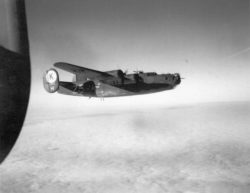
B-24s often kept their ball turrets retracted to decrease drag. Ford’s Folly (42-52515, 458BG) is lost this day due to flak over Ludwigsfelde.
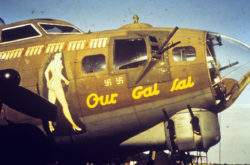
Our Gal Sal (42-31767, 100BG). The 100BG suffered particularly heavy losses on the 6 March 1944 Berlin strike.
The US 8AF launches 504 Boeing B-17s and 226 Consolidated B-24s, escorted by 86 Lockheed P-38s, 615 Republic P-47s, and 100 North American P-51s, against Berlin, Germany. Due to concerns over their lower service ceilings, the B-24s bomb the Daimler-Benz engine plant of nearby Ludwigsfelde. Four of the escorting fighter units are on loan from the US 9AF. The force is lead by "U-Uncle" (42-30731, 482BG), an H2S-equipped Pathfinder piloted by 1LT Bill V. Owen, with CO 412BS LTC H. Griff Mumford, aboard I'll Be Around (42-31320, 95BG), acting as mission commander. This is the first USAAF strike against Berlin.
The previous success of BIG WEEK was inescapable, with German interceptors becoming increasingly hesitant to engage by week’s end. As such, XO USSTAF MG Fred L. Anderson, Jr. pushed for follow-up strikes against Berlin, the logic being that German fighters would again have no choice but to intercept the American bombers. CG US 8AF MG Jimmy H. Doolittle, ever cautious, cancelled the first day’s strike and recalled another on 4 March on account of weather, prompting a harsh rebuttal from his superiors. Anderson bluntly wrote:
[It] doesn’t matter if Berlin is overcast. The resulting air battle over Berlin would result in attrition, which makes it more important than any destruction on the ground – and going to Frankfurt to find clear skies won’t achieve the same result. We’ve got to stick at this damn thing.
As such, this day’s strike is followed by further attacks against Berlin on 8 March and 9 March. The 9 March operation proves climatic as German aircraft resistance finally crumbles, with most of the last day’s losses coming not from enemy fighters but accidents and ground fire. The strategy of forcing aerial engagements via the bombing of high value targets continues throughout the spring months, and Berlin is struck again on 22 March, 29 April, and 19 May. Doing so ensures that German fighter units are hard-pressed to replace their losses. When Allied ground forces finally land in occupied-France on 6 June, only two German fighters are able to approach the landing beaches – the Luftwaffe‘s fighting ability is practically destroyed. By the end of the US attrition campaign against Berlin, 218 Luftwaffe interceptors are destroyed at the cost of 237 bombers and 97 fighters, with the Luftwaffe failing to intercept US formations at all on 9 March and 22 March.
In addition to the 2.3 million pounds of bombs dropped on 6 March, the bombers also carry some 14,273 gallons of napalm. A portmanteau of 'naphthenic' and 'palmitic' acid, 'napalm' is the product of a 1941 study by the Office of Scientific Research and Development which oversaw weapons testing against mock German and Japanese towns in Dugway, UT. Finding a new incendiary was of particular importance as the most common agent, magnesium, was in short supply. Of the incendiaries tested, DuPont’s napalm proved particularly effective against Japanese dwellings, with the added benefit of being lightweight and easy to produce. Napalm was quickly issued to infantry units with the M1A1 flamethrower but it was not until the 6 March strike on Berlin that napalm was air-dropped.
It is also worth noting that, numerically, the 6 March operation is the costliest 8AF strike of the entire war – including Schweinfurt II. However, one should be careful not to conflate numbers of aircraft lost with loss percentages. Whereas the 8AF had some 1,138 bombers in October 1943, March 1944 saw that number swell to 2,295. As such, the percentage of the force lost on Schweinfurt II (60 bombers, 21%) was still higher than that lost on Berlin (69 bombers, 9%), despite the fact that the Berlin strike suffered more losses.
The 29 April 1944 strike suffers uncharacteristically heavy losses (64 bombers 10%), the result of missed escort rendezvous points by the 4BW (94BG, 385BG, 388BG, and 447BG) and 2AD (the 8AF’s B-24 complement). The heavy losses suffered by B-24 units in particular throughout Big Week and the Battle of Berlin solidify Doolittle’s already poor opinion of the B-24, encouraging the 8AF to hold onto to the older B-17 long after other air forces had abandoned the bomber (such as in the Pacific). In truth, the 29 April strike signifies that, even though severely weakened, the Luftwaffe can still pose a serious threat.
| 6-Mar-44 | |
| Bombers Launched: | 730 |
| Bombers Effective: | 672 |
| Fighters Launched: | 801 |
| Bombers MIA: | 69 |
| Bombers DBR: | 6 |
| Bombers Abort: | 58 |
| Fighters MIA: | 11 |
| Fighters DBR: | 3 |
| Abort Rate: | 8% |
| Loss Rate: | 10% |
| E/A Destroyed: | 75 |
| 8-Mar-44 | |
| Bombers Launched: | 623 |
| Bombers Effective: | 539 |
| Fighters Launched: | 891 |
| Bombers MIA: | 36 |
| Bombers DBR: | 3 |
| Bombers Abort: | 84 |
| Fighters MIA: | 18 |
| Fighters DBR: | 16 |
| Abort Rate: | 13% |
| Loss Rate: | 6% |
| E/A Destroyed: | 48 |
| 9-Mar-44 | |
| Bombers Launched: | 526 |
| Bombers Effective: | 490 |
| Fighters Launched: | 808 |
| Bombers MIA: | 8 |
| Bombers DBR: | 2 |
| Bombers Abort: | 36 |
| Fighters MIA: | 1 |
| Fighters DBR: | 3 |
| Abort Rate: | 7% |
| Loss Rate: | 2% |
| 22-Mar-44 | |
| Bombers Launched: | 688 |
| Bombers Effective: | 657 |
| Fighters Launched: | 817 |
| Bombers MIA: | 12 |
| Bombers DBR: | 1 |
| Bombers Abort: | 31 |
| Fighters MIA: | 12 |
| Fighters DBR: | 1 |
| Abort Rate: | 5% |
| Loss Rate: | 2% |
| 29-April-44 | |
| Bombers Launched: | 679 |
| Bombers Effective: | 618 |
| Fighters Launched: | 814 |
| Bombers MIA: | 64 |
| Bombers DBR: | 2 |
| Bombers Abort: | 61 |
| Fighters MIA: | 13 |
| Fighters DBR: | 1 |
| Abort Rate: | 9% |
| Loss Rate: | 10% |
| E/A Destroyed: | 27 |
| 19-May-44 | |
| Bombers Launched: | 888 |
| Bombers Effective: | 818 |
| Fighters Launched: | 964 |
| Bombers MIA: | 29 |
| Bombers DBR: | 2 |
| Bombers Abort: | 70 |
| Fighters MIA: | 19 |
| Fighters DBR: | 2 |
| Abort Rate: | 8% |
| Loss Rate: | 3% |
| E/A Destroyed: | 68 |
| 24-May-44 | |
| Bombers Launched: | 1106 |
| Bombers Effective: | 917 |
| Fighters Launched: | 824 |
| Bombers MIA: | 33 |
| Bombers DBR: | 1 |
| Bombers Abort: | 189 |
| Fighters MIA: | 13 |
| Fighters DBR: | 1 |
| Abort Rate: | 17% |
| Loss Rate: | 3% |
| E/A Destroyed: | 36 |
| Aircraft Type | Serial No. | Name | Code | Unit | MACR |
| Boeing B-17G-15-VE | 42-97483 | LG-L | 322BS/91BG | 2902 |
| Boeing B-17G-30-DL | 42-38118 | OR-N | 323BS/91BG | 2901 |
| Boeing B-17G-30-BO | 42-31911 | OR-Q | 323BS/91BG | 2900 |
| Boeing B-17G-1-BO | 42-31079 | LL-J | 401BS/91BG | 2897 |
| Boeing B-17G-20-BO | 42-31578 | My Darling Also | LL-L | 401BS/91BG | 2898 |
| Boeing B-17G-30-BO | 42-31869 | Hell & High Water | LL-Y | 401BS/91BG | 2899 |
| Boeing B-17G-20-BO | 42-31503 | NV-L | 325BS/92BG | 2903 |
| Boeing B-17G-15-VE | 42-97527 | UX-K | 327BS/92BG | 2996 |
| Boeing B-17G-25-BO | 42-31680 | PY-P | 407BS/92BG | 2904 |
| Boeing B-17G-10-VE | 42-40052 | PY-X | 407BS/92BG | 2905 |
| Boeing B-17G-25-DL | 42-38022 | Jeanne | GL-M | 410BS/94BG | 2977 |
| Boeing B-17G-10-BO | 42-31299 | Junior | BG-M | 334BS/95BG | 2999 |
| Boeing B-17G-10-BO | 42-31251 | BG-P | 334BS/95BG | 2981 |
| Boeing B-17F-10-DL | 42-29943 | Situation Normal | OE-K | 335BS/95BG | 2980 |
| Boeing B-17G-35-BO | 42-32002 | Berlin First | OE-X | 335BS/95BG | 2982 |
| Boeing B-17G-15-VE | 42-97495 | ET-C | 336BS/95BG | 2986 |
| Boeing B-17G-25-DL | 42-38024 | ET-Q | 336BS/95BG | 2984 |
| Boeing B-17F-75-DL | 42-3529 | ET-T | 336BS/95BG | 2979 |
| Boeing B-17G-1-VE | 42-39793 | QW-V | 412BS/95BG | 2985 |
| Boeing B-17F-90-BO | 42-30170 | Pride Of The Century | XR-G | 349BS/100BG | 3015 |
| Boeing B-17F-120-BO | 42-30799 | Big Ass Bird II | XR-L | 349BS/100BG | 3017 |
| Boeing B-17G-25-BO | 42-31731 | XR-M | 349BS/100BG | 3019 |
| Boeing B-17G-5-VE | 42-39872 | Rubber Check | LN-A | 350BS/100BG | 3030 |
| Boeing B-17G-30-DL | 42-38197 | Half & Half | LN-T | 350BS/100BG | 3028 |
| Boeing B-17G-30-BO | 42-31735 | Lucky Lee | EP-B | 351BS/100BG | 3020 |
| Boeing B-17G-1-BO | 42-31051 | Goin' Jessies | EP-K | 351BS/100BG | 3018 |
| Boeing B-17G-25-DL | 42-38011 | Kinda Ruff | EP-P | 351BS/100BG | 3023 |
| Boeing B-17G-25-DL | 42-38044 | Spirit Of '44 | EP-R | 351BS/100BG | 3026 |
| Boeing B-17G-25-DL | 42-38059 | LD-A | 418BS/100BG | 3027 |
| Boeing B-17G-15-VE | 42-97491 | Ronnie R | LD-B | 418BS/100BG | 3034 |
| Boeing B-17G-10-VE | 42-39994 | Snort Stuff | LD-D | 418BS/100BG | 3031 |
| Boeing B-17F-95-BO | 42-30278 | Sly Fox | LD-R | 418BS/100BG | 3016 |
| Boeing B-17G-30-BO | 42-31800 | LD-U | 418BS/100BG | 3021 |
| Boeing B-17G-15-VE | 42-97482 | Terry & the Pirates | LD-W | 418BS/100BG | 3033 |
| Boeing B-17G-10-VE | 42-40006 | Liberty Lady | BO-H | 368BS/306BG | 2735 |
| Boeing B-17G-20-BO | 42-31555 | Ruthie | FO-H | 527BS/379BG | 2909 |
| Boeing B-17G-20-BO | 42-31448 | Half Breed | VE-A | 532BS/381BG | 3001 |
| Boeing B-17F-35-DL | 42-3215 | Linda Mary | VP-S | 533BS/381BG | 3000 |
| Boeing B-17G-20-BO | 42-31553 | Myer's Flaw | GD-B | 534BS/381BG | 3241 |
| Boeing B-17G-10-BO | 42-31240 | Shack Job | F | 561BS/388BG | 3086 |
| Boeing B-17G-30-DL | 42-38177 | Shack Rabbits | H | 561BS/388BG | 3091 |
| Boeing B-17G-10-VE | 42-40054 | unk | 561BS/388BG | 3092 |
| Boeing B-17G-5-BO | 42-31163 | Glory Girl | T | 562BS/388BG | 3083 |
| Boeing B-17G-15-DL | 42-37886 | Blitzing Betsy | U | 562BS/388BG | 3089 |
| Boeing B-17G-5-BO | 42-31135 | Susie Sag Titz | W | 562BS/388BG | 3082 |
| Boeing B-17G-5-BO | 42-31194 | Duchess Of Dixie | unk | 562BS/388BG | 3084 |
| Boeing B-17G-35-BO | 42-31935 | Stark's Ark | FC-A | 571BS/390BG | 2989 |
| Boeing B-17G-30-DL | 42-38136 | IY-G | 615BS/401BG | 2743 |
| Boeing B-17G-15-BO | 42-31373 | Flakstop | 7D-V | 731BS/452BG | 2916 |
| Boeing B-17G-15-BO | 42-31337 | Hell's Cargo | 7D-unk | 731BS/452BG | 2914 |
| Boeing B-17G-20-BO | 42-31627 | J | 748BS/457BG | 3198 |
| Boeing B-17G-20-BO | 42-31595 | Flying Jenny | unk | 750BS/457BG | 3197 |
| Boeing B-17F-70-DL | 42-3491 | MI-G | 812BS/482BG | 3362 |
| Consolidated B-24J-105-CO | 42-109832 | De-Icer | AG-unk | 330BS/93BG | 2957 |
| Consolidated B-24J-100-CO | 42-100424 | Roll Call | HP-unk | 567BS/389BG | 3249 |
| Consolidated B-24H-1-FO | 42-7598 | Flak Ducker | CI-E | 576BS/392BG | 3183 |
| Consolidated B-24J-105-CO | 42-109796 | Balls Of Fire | IS-unk | 700BS/445BG | 2962 |
| Consolidated B-24H-1-FO | 42-7586 | God Bless Our Ship | MK-Q | 701BS/445BG | 2960 |
| Consolidated B-24J-90-CO | 42-100288 | Major Hoopo | JU-C | 707BS/446BG | 2966 |
| Consolidated B-24H-5-CF | 41-29191 | Hello Natural | CT-E | 712BS/448BG | 3548 |
| Consolidated B-24H-10-CF | 42-64457 | E8-R | 733BS/453BG | 2971 |
| Consolidated B-24H-10-CF | 42-64460 | Shack Rabbit | E8-S | 733BS/453BG | 2972 |
| Consolidated B-24H-10-FO | 42-52226 | Betty Boop | F8-E | 734BS/453BG | 2970 |
| Consolidated B-24H-10-FO | 42-52191 | Lillie Belle | H6-N | 735BS/453BG | 2969 |
| Consolidated B-24H-15-FO | 42-52306 | J4-I | 753BS/458BG | 3349 |
| Consolidated B-24H-10-CF | 41-29286 | J4-R | 753BS/458BG | 3346 |
| Consolidated B-24H-15-FO | 42-52450 | Z5-G | 754BS/458BG | 3350 |
| Consolidated B-24H-15-FO | 42-52515 | Ford's Folly | Z5-H | 754BS/458BG | 3351 |
| Consolidated B-24H-10-CF | 41-29299 | Roll Call | Z5-M | 754BS/458BG | 3348 |
8-Mar-44
| Boeing B-17G-5-VE | 42-39892 | LL-B | 401BS/91BG | 3223 |
| Boeing B-17G-5-BO | 42-31141 | XM-N | 332BS/94BG | 2976 |
| Boeing B-17F-35-VE | 42-5950 | Peter's Pride | GL-P | 410BS/94BG | 2997 |
| Boeing B-17G-20-DL | 42-37929 | Diana | OE-Y | 335BS/95BG | 2983 |
| Boeing B-17G-30-BO | 42-31912 | Myasam Dragon | AW-L | 337BS/96BG | 3429 |
| Boeing B-17G-10-VE | 42-39988 | Iron Ass | QJ-A | 339BS/96BG | 3430 |
| Boeing B-17G-20-BO | 42-31576 | QJ-G | 339BS/96BG | 3426 |
| Boeing B-17F-125-BO | 42-30847 | Pegasus | MZ-N | 413BS/96BG | 3423 |
| Boeing B-17G-25-BO | 42-31716 | MZ-P | 413BS/96BG | 3428 |
| Boeing B-17G-15-BO | 42-31403 | MZ-Y | 413BS/96BG | 3424 |
| Boeing B-17G-10-VE | 42-40056 | Katie's Boys | EP-F | 351BS/100BG | 3032 |
| Boeing B-17G-20-BO | 42-31471 | Doolittle's Destroyer | PU-E | 360BS/303BG | 2908 |
| Boeing B-17G-25-DL | 42-38029 | VE-M | 532BS/381BG | 3002 |
| Boeing B-17G-30-DL | 42-38138 | A | 560BS/388BG | 3090 |
| Boeing B-17G-15-DL | 42-37819 | P | 560BS/388BG | 3087 |
| Boeing B-17G-5-BO | 42-31214 | Return Engagement | T | 560BS/388BG | 3085 |
| Boeing B-17F-120-BO | 42-30829 | Princess Pat | L | 563BS/388BG | 3081 |
| Boeing B-17F-100-BO | 42-30340 | Screamin' Red Ass | Z | 563BS/388BG | 3079 |
| Boeing B-17G-25-BO | 42-31717 | Hell's Bells | BI-A | 568BS/390BG | 2988 |
| Boeing B-17F-115-BO | 42-30713 | Phyllis Marie | BI-C | 568BS/390BG | 2987 |
| Boeing B-17G-15-DL | 42-37812 | Heavenly Body | DI-O | 570BS/390BG | 2990 |
| Boeing B-17G-20-BO | 42-31488 | Shade Ruff | IW-D | 614BS/401BG | 2911 |
| Boeing B-17G-20-DL | 42-37954 | Paper Doll | M3-unk | 729BS/452BG | 3192 |
| Boeing B-17G-15-VE | 42-97525 | Invictus | 6K-unk | 730BS/452BG | 3195 |
| Boeing B-17G-30-DL | 42-38211 | Sleepy Time Gal | 7D-M | 731BS/452BG | 3193 |
| Boeing B-17G-15-BO | 42-31354 | Dixie Jane | 7D-O | 731BS/452BG | 3191 |
| Boeing B-17G-10-BO | 42-31331 | Tina Tangerine | 7D-unk | 731BS/452BG | 3190 |
| Consolidated B-24J-55-CO | 42-99975 | Yankee-Rebel Harmony | YO-D | 564BS/389BG | 2958 |
| Consolidated B-24J-95-CO | 42-100375 | RR-unk | 566BS/389BG | 2959 |
| Consolidated B-24H-10-CF | 41-29292 | HN-unk | 705BS/446BG | 2964 |
| Consolidated B-24H-1-FO | 42-7595 | Shif'lus Skonk | RT-E | 706BS/446BG | 2963 |
| Consolidated B-24J-80-CO | 42-100231 | JU-unk | 707BS/446BG | 2965 |
| Consolidated B-24J-95-CO | 42-100342 | IO-M | 715BS/448BG | 2967 |
| Consolidated B-24J-70-CO | 42-100122 | Twin Tails | IO-unk | 715BS/448BG | 3189 |
| Consolidated B-24H-10-FO | 42-52175 | Portland Annie | H6-P | 735BS/453BG | 2928 |
| Consolidated B-24H-10-DT | 41-28720 | J3-N | 755BS/458BG | 3345 |
9-Mar-44
| Boeing B-17G-20-BO | 42-31564 | NV-O | 325BS/92BG | 3064 |
| Boeing B-17G-30-BO | 42-31772 | PY-unk | 407BS/92BG | 2995 |
| Boeing B-17G-10-DL | 42-37781 | Silver Dollar | BK-W | 546BS/384BG | 3005 |
| Boeing B-17G-15-DL | 42-37839 | Little Willie | D | 563BS/388BG | 3088 |
| Boeing B-17G-5-BO | 42-31208 | IE-unk | 709BS/447BG |
| Boeing B-17G-5-BO | 42-31210 | Piccadilly Ann | IJ-unk | 710BS/447BG |
| Consolidated B-24H-1-FO | 42-7604 | WV-unk | 702BS/445BG | 2961 |
| Consolidated B-24H-1-DT | 41-28611 | Baby Shoes | CT-unk | 712BS/448BG | 3339 |
22-Mar-44
| Boeing B-17G-40-BO | 42-97125 | LL-unk | 401BS/91BG | 3412 |
| Boeing B-17G-25-BO | 42-31637 | Athenian Avenger | TS-unk | 333BS/94BG | 3535 |
| Boeing B-17F-45-VE | 42-6099 | Winnie C. | AW-E | 337BS/96BG | 3420 |
| Boeing B-17G-20-DL | 42-37957 | KY-K | 366BS/305BG | 3432 |
| Boeing B-17G-15-VE | 42-97523 | JJ-unk | 422BS/305BG | 3433 |
| Boeing B-17G-1-VE | 42-39849 | YB-K | 508BS/351BG | 3314 |
| Boeing B-17G-35-DL | 42-107038 | YJ-unk | 710BS/447BG | 3338 |
| Consolidated B-24J-90-CO | 42-100306 | War Goddess | FL-unk | 704BS/446BG | 3337 |
| Consolidated B-24H-1-CF | 41-29151 | Joker | HN-unk | 705BS/446BG | 3336 |
| Consolidated B-24H-10-DT | 41-28678 | J3-M | 755BS/458BG | 3555 |
| Consolidated B-24H-15-CF | 41-29416 | Rebel Yell | U8-unk | 786BS/466BG | 3491 |
| Consolidated B-24H-15-CF | 41-29434 | Terry & the Pirates | U8-unk | 786BS/466BG |
29-April-44
| Boeing B-17G-15-BO | 42-31353 | Queenie | OR-Q | 323BS/91BG | 4236 |
| Boeing B-17G-45-BO | 42-97319 | JW-M | 326BS/92BG | 4261 |
| Boeing B-17F-75-DL | 42-3513 | JW-T | 326BS/92BG | 4260 |
| Boeing B-17G-20-BO | 42-31498 | Passionate Witch II | QE-X | 331BS/94BG | 4467 |
| Boeing B-17G-50-BO | 42-102520 | XM-unk | 332BS/94BG | 4468 |
| Boeing B-17G-20-DL | 42-37988 | Flag Ship | ET-M | 336BS/95BG | 4470 |
| Boeing B-17G-10-BO | 42-31320 | I'll Be Around | QW-M | 412BS/95BG | 4469 |
| Boeing B-17G-10-BO | 42-31241 | Spirit of Wanette | GN-W | 427BS/303BG | 4463 |
| Boeing B-17F-30-DL | 42-3158 | Max | GN-Y | 427BS/303BG | 4471 |
| Boeing B-17G-20-BO | 42-31556 | BO-D | 368BS/306BG | 4240 |
| Boeing B-17G-50-BO | 42-102448 | Mexican Hayride | JD-P | 545BS/384BG | 4242 |
| Boeing B-17G-30-BO | 42-31773 | GX-M | 548BS/385BG | 4456 |
| Boeing B-17G-20-VE | 42-97559 | Vapor Trails | XA-unk | 549BS/385BG | 4459 |
| Boeing B-17G-35-DL | 42-107045 | SG-D | 550BS/385BG | 4460 |
| Boeing B-17G-40-BO | 42-97078 | Pride of the Yankees | SG-unk | 550BS/385BG | 4457 |
| Boeing B-17G-5-BO | 42-31133 | Powers Girl | HR-Q | 551BS/385BG | 4453 |
| Boeing B-17G-45-BO | 42-97226 | HR-X | 551BS/385BG | 4458 |
| Boeing B-17G-5-BO | 42-31174 | Spirit of Chicago | HR-Y | 551BS/385BG | 4454 |
| Boeing B-17G-15-BO | 42-31393 | SNAFU | N | 560BS/388BG | 4243 |
| Boeing B-17G-20-DL | 42-37980 | D | 562BS/388BG | 4244 |
| Boeing B-17G-50-BO | 42-102526 | FC-N | 571BS/390BG | 4245 |
| Boeing B-17G-5-BO | 42-31226 | Saint & Ten Sinners | IN-G | 613BS/401BG | 4345 |
| Boeing B-17G-1-BO | 42-31116 | Cawn't Miss | IW-O | 614BS/401BG | 4344 |
| Boeing B-17G-20-BO | 42-31521 | Badland Bat | IY-M | 615BS/401BG | 4346 |
| Boeing B-17G-15-DL | 42-37868 | Due Back | CQ-B | 708BS/447BG | 4251 |
| Boeing B-17G-15-DL | 42-37866 | Bloated Body | CQ-D | 708BS/447BG | 4250 |
| Boeing B-17G-50-BO | 42-102479 | CQ-unk | 708BS/447BG | 4255 |
| Boeing B-17G-5-BO | 42-31144 | Miss America | CQ-A | 708BS/447BG | 4247 |
| Boeing B-17G-50-BO | 42-102421 | IE-M | 709BS/447BG | 4254 |
| Boeing B-17G-20-BO | 42-31519 | IE-O | 709BS/447BG |
| Boeing B-17G-5-BO | 42-31217 | Solid Sender | IJ-G | 710BS/447BG | 4249 |
| Boeing B-17G-40-BO | 42-97135 | IJ-N | 710BS/447BG | 4252 |
| Boeing B-17G-1-BO | 42-31124 | Lady Lilian | IR-N | 711BS/447BG | 4246 |
| Boeing B-17G-5-BO | 42-31161 | Spare Parts | IR-unk | 711BS/447BG | 4248 |
| Boeing B-17G-15-VE | 42-97501 | Gum Chum | IR-unk | 711BS/447BG | 4253 |
| Boeing B-17G-10-VE | 42-39981 | Rugged But Right | 9Z-P | 728BS/452BG | 4450 |
| Boeing B-17G-5-VE | 42-39920 | Karen B | M3-D | 729BS/452BG | 4449 |
| Boeing B-17G-30-BO | 42-31784 | Section Eight | M3-G | 729BS/452BG |
| Consolidated B-24J-85-CO | 42-100279 | NB-I | 67BS/44BG | 4464 |
| Consolidated B-24H-15-CF | 41-29471 | WQ-X | 68BS/44BG | 4472 |
| Consolidated B-24H-15-CF | 41-29513 | GJ-Z | 506BG/44BG |
| Consolidated B-24H-10-DT | 41-28676 | YO-C | 564BS/389BG | 4494 |
| Consolidated B-24H-15-DT | 41-28784 | YO-F | 564BS/389BG | 5473 |
| Consolidated B-24J-130-CO | 42-110062 | CI-A | 576BS/392BG | 4445 |
| Consolidated B-24J-95-CO | 42-100371 | Doodlebug | CI-F | 576BS/392BG | 4476 |
| Consolidated B-24H-15-DT | 41-28759 | DC-V | 577BS/392BG | 4462 |
| Consolidated B-24J-70-CO | 42-100100 | Double Trouble | EC-T | 578BS/392BG | 4444 |
| Consolidated B-24J-135-CO | 42-110105 | EC-unk | 578BS/392BG | 4446 |
| Consolidated B-24H-1-FO | 42-7510 | El Lobo | GC-C | 579BS/392BG | 4461 |
| Consolidated B-24J-95-CO | 42-100360 | Luck & Stuff | RT-B | 706BS/446BG | 4485 |
| Consolidated B-24H-1-FO | 42-7655 | Chubby Champ | CT-P | 712BS/448BG | 4486 |
| Consolidated B-24H-15-CF | 41-29523 | Miss Hap | IG-D | 713BS/448BG | 4489 |
| Consolidated B-24H-1-FO | 42-7683 | Sweet Sioux | EI-E | 714BS/448BG | 4487 |
| Consolidated B-24J-60-CO | 42-99988 | Sad Sack | EI-J | 714BS/448BG | 4491 |
| Consolidated B-24H-15-CF | 41-29479 | Big Bad Wolf | IO-K | 715BS/448BG | 4488 |
| Consolidated B-24H-15-FO | 42-52435 | IO-unk | 715BS/448BG | 4490 |
| Consolidated B-24H-10-FO | 42-52301 | Ken O Kay II | E3-C | 732BS/453BG | 4940 |
| Consolidated B-24H-20-CF | 42-50322 | F8-I | 734BS/453BG | 4493 |
| Consolidated B-24H-10-DT | 41-28718 | Bo | 7V-M | 752BS/458BG | 4451 |
| Consolidated B-24H-15-CF | 41-29399 | Playboy | T9-O | 784BS/466BG | 4448 |
| Consolidated B-24H-15-DT | 41-28754 | Tell Me More | 6L-N | 787BS/466BG | 4447 |
| Consolidated B-24H-15-FO | 42-52506 | X7-M | 788BS/467BG | 4944 |
| Consolidated B-24H-10-DT | 41-28730 | Blonde Bomber | Q2-A | 790BS/467BS | 4942 |
| Consolidated B-24H-10-DT | 41-28749 | Wild Irish Rose | Q2-N | 790BS/467BS | 4943 |
19-May-44
| Boeing B-17G-15-VE | 42-97455 | Keystone Mama | LL-J | 401BS/91BG | 4829 |
| Boeing B-17G-20-BO | 42-31540 | Miss Donna Mae | QE-A | 331BS/94BG | 4946 |
| Boeing B-17G-45-BO | 42-97290 | Smilin' Sandy Sanchez | BG-H | 334BS/95BG | 4928 |
| Boeing B-17G-20-VE | 42-97607 | XR-H | 349BS/100BG | 4948 |
| Boeing B-17G-15-DL | 42-37807 | Roger's Raiders | LN-O | 350BS/100BG |
| Boeing B-17G-30-DL | 42-38191 | LN-W | 350BS/100BG | 4947 |
| Boeing B-17G-15-BO | 42-31386 | Sky Duster | BN-W | 359BS/303BG | 4949 |
| Boeing B-17G-1-VE | 42-39783 | Blues In The Night | LF-B | 526BS/379BG | 4929 |
| Boeing B-17G-35-BO | 42-32088 | Dry Gulcher | VE-M | 532BS/381BG | 5030 |
| Boeing B-17G-15-VE | 42-97454 | VP-U | 533BS/381BG | 4932 |
| Boeing B-17G-35-DL | 42-107160 | Little Joe | S | 562BS/388BG |
| Boeing B-17G-50-BO | 42-102532 | DI-O | 570BS/390BG | 4935 |
| Boeing B-17G-45-BO | 42-97339 | N8-Y | 600BS/398BG | 4937 |
| Boeing B-17G-25-DL | 42-38026 | My Day | SC-N | 612BS/401BG | 4815 |
| Boeing B-17G-30-DL | 42-38145 | Rosalie Ann | 6K-T | 730BS/452BG |
| Boeing B-17G-10-VE | 42-39990 | Junior | 6K-Z | 730BS/452BG | 4958 |
| Boeing B-17G-15-VE | 42-97481 | Pocahontas | Q | 751BS/457BG | 4941 |
| Consolidated B-24H-1-CF | 41-29129 | CI-A | 576BS/392BG | 5096 |
| Consolidated B-24H-25-FO | 42-95060 | EC-A | 578BS/392BG | 4925 |
| Consolidated B-24H-15-CF | 41-29474 | GC-M | 579BS/392BG | 4936 |
| Consolidated B-24H-15-FO | 42-52638 | Skeeter II | EI-unk | 714BS/448BG | 5029 |
| Consolidated B-24J-150-CO | 44-40171 | Boomerang | 9H-O | 857BS/492BG | 5242 |
| Consolidated B-24J-145-CO | 44-40088 | Katie Jean | 9H-unk | 857BS/492BG | 5246 |
| Consolidated B-24J-140-CO | 42-110151 | G I Joe | 9H-unk | 857BS/492BG | 5241 |
| Consolidated B-24J-140-CO | 42-110153 | 9A-R | 858BS/492BG | 5240 |
| Consolidated B-24J-150-CO | 44-40151 | 9A-unk | 858BS/492BG | 5244 |
| Consolidated B-24J-150-CO | 44-40152 | 9A-unk | 858BS/492BG | 5243 |
| Consolidated B-24J-145-CO | 44-40133 | Uninvited | 9A-unk | 858BS/492BG | 5245 |
| Consolidated B-24J-145-CO | 44-40065 | Silver Lady | X4-O | 859BS/492BG | 5247 |
24-May-44
| Boeing B-17G-35-DL | 42-107178 | LL-K | 401BS/91BG | 5358 |
| Boeing B-17G-25-BO | 42-31635 | UX-Y | 327BS/92BG | 5159 |
| Boeing B-17G-10-BO | 42-31252 | Sweaty Betty | QE-N | 331BS/94BG |
| Boeing B-17G-5-VE | 42-39924 | Tornado | BG-N | 334BS/95BG | 5160 |
| Boeing B-17G-55-BO | 42-102648 | BTO of the ETO | XR-L | 349BS/100BG | 5172 |
| Boeing B-17G-20-BO | 42-31534 | Shilaylee | XR-N | 349BS/100BG | 5166 |
| Boeing B-17G-50-BO | 42-102528 | Times A-Wastin' | XR-O | 349BS/100BG | 5169 |
| Boeing B-17G-55-BO | 42-102624 | XR-unk | 349BS/100BG | 5170 |
| Boeing B-17G-55-BO | 42-102635 | XR-unk | 349BS/100BG | 5171 |
| Boeing B-17G-35-BO | 42-31941 | Big Stoop | LN-W | 350BS/100BG | 5167 |
| Boeing B-17G-40-BO | 42-97095 | LN-Y | 350BS/100BG | 5168 |
| Boeing B-17G-35-VE | 42-97845 | LN-unk | 350BS/100BG | 5151 |
| Boeing B-17G-10-BO | 42-31306 | Nelson King | EP-V | 351BS/100BG | 5165 |
| Boeing B-17G-30-VE | 42-97787 | VK-M | 358BS/303BG | 5173 |
| Boeing B-17G-5-VE | 42-39949 | XK-unk | 365BS/305BG | 5174 |
| Boeing B-17G-35-BO | 42-32113 | BO-G | 368BS/306BG | 4952 |
| Boeing B-17G-25-DL | 42-38005 | Stormy Weather | DS-G | 511BS/351BG | 5175 |
| Boeing B-17G-1-VE | 42-39828 | Penny Ante | WA-B | 524BS/379BG | 5320 |
| Boeing B-17G-25-DL | 42-38082 | FR-L | 525BS/379BG | 5321 |
| Boeing B-17G-10-DL | 42-37784 | Old Fox | FR-P | 525BS/379BG | 5322 |
| Boeing B-17G-25-DL | 42-38010 | VE-J | 532BG/381BG | 5178 |
| Boeing B-17G-10-BO | 42-31291 | Avengress | VP-F | 533BS/381BG | 5176 |
| Boeing B-17G-25-BO | 42-31698 | VP-N | 533BS/381BG | 5319 |
| Boeing B-17G-45-BO | 42-97214 | Carolina Queen | GD-B | 534BS/381BG | 5181 |
| Boeing B-17G-5-VE | 42-39890 | Return Ticket | MS-Y | 535BS/381BG | 5179 |
| Boeing B-17G-30-BO | 42-31878 | Spam Can | MS-Z | 535BS/381BG | 5177 |
| Boeing B-17G-15-BO | 42-31364 | Nuttal's Nut House | SU-D | 544BS/384BG | 5268 |
| Boeing B-17G-30-BO | 42-31742 | GX-unk | 548BS/385BG | 5267 |
| Boeing B-17G-35-DL | 42-107132 | 3O-V | 601BS/398BG | 5253 |
| Boeing B-17G-35-DL | 42-107231 | N7-A | 603BS/398BG | 5252 |
| Boeing B-17G-20-BO | 42-31619 | Sweet Thing | IY-L | 615BS/401BG | 4957 |
| Boeing B-17G-50-BO | 42-102494 | CQ-unk | 708BS/447BG | 5249 |
| Boeing B-17G-60-BO | 42-102965 | 749BS/457BG |
| Aircraft Type | Serial No. | Pilot | Code | Unit | MACR |
| Lockheed P-38J-10-LO | 42-67461 | 2LT Larry N. Ferguson | 5Y-unk | 384FS/364FG | 3061 |
| Republic P-47D-11-RE | 42-75397 | 2LT Andrew B. Stauss | HV-unk | 61FS/56FG | 2787 |
| Republic P-47D-2-RE | 42-7998 | 1LT Grant M. Turley | MX-D | 82FS/78FG | 2975 |
| Republic P-47D-2-RE | 42-7983 | FO Edward J. Downey | HL-W | 83FS/78FG | 2974 |
| Republic P-47D-11-RE | 42-75255 | 1LT Milton F. Erickson | QI-N | 361FS/356FG | 3058 |
| Republic P-47D-15-RE | 42-75635 | MAJ Frederick J. Nelander | E4-unk | 377FS/362FG | 2714 |
| North American P-51B-5-NA | 43-6899 | 1LT Edmund D. Whalen | QP-O | 334FS/4FG | 2839 |
| North American P-51B-5-NA | 43-6690 | MAJ Henry L. Mills | QP-Q | 334FS/4FG | 3044 |
| North American P-51B-5-NA | 43-6887 | CPT Cecil E. Manning | WD-H | 335FS/4FG | 3049 |
| North American P-51B-5-NA | 43-6630 | 1LT Robert J. Messenger | VF-U | 336FS/4FG | 3042 |
| North American P-51B-1-NA | 43-12446 | 2LT Ridley E. Donnell, Jr. | FT-unk | 353FS/354FG | 2803 |
8-Mar-44
| Lockheed P-38J-5-LO | 42-67223 | 2LT Kenneth F. London | N2-unk | 383FS/364FG | 3059 |
| Lockheed P-38J-5-LO | 42-67233 | 2LT Charles E. Brock | N2-unk | 383FS/364FG | 3060 |
| Republic P-47D-10-RE | 42-75040 | 1LT Joe W. Icard | LM-I | 62FS/56FG | 2843 |
| Republic P-47D-15-RE | 42-75697 | 2LT Frederick L. Roy | LM-O | 62FS/56FG | 2844 |
| Republic P-47D-6-RE | 42-74623 | 2LT Caleb L. Reeder, Jr. | LM-X | 62FS/56FG | 2841 |
| Republic P-47D-6-RE | 42-74697 | 1LT Anthony R. Carcione | LM-unk | 62FS/56FG | 2842 |
| Republic P-47D-1-RE | 42-7885 | 2LT John C. Marcotte | UN-N | 63FS/56FG | 2840 |
| Republic P-47D-5-RE | 42-8557 | 1LT John Zolner | LH-U | 350FS/353FG | 2992 |
| Republic P-47D-5-RE | 42-8441 | 1LT Charles H. Sweat | WR-R | 354FS/355FG | 3055 |
| Republic P-47D-5-RE | 42-8467 | 1LT Justus D. Henry, Jr. | OC-L | 359FS/356FG | 3057 |
| Republic P-47D-10-RE | 42-75084 | 2LT Clyde L. Coldren | IA-unk | 366FS/358FG | 2846 |
| Republic P-47D-15-RE | 42-75672 | 2LT Edward A. Abdallah | B8-unk | 379FS/362FG | 2734 |
| North American P-51B-5-NA | 43-6442 | LTC Selden R. Edner | VF-unk | 336FS/4FG | 2838 |
| North American P-51B-5-NA | 43-6989 | 2LT Daniel S. Rothenberg | OS-unk | 357FS/355FG | 3056 |
| North American P-51C-1-NT | 42-103041 | 1LT William W. Gambill | B6-F | 363FS/357FG | 2994 |
| North American P-51B-5-NA | 43-6932 | 1LT Neill F. Ullo | A9-V | 380FS/363FG | 2575 |
9-Mar-44
| Lockheed P-38J-5-LO | 42-67230 | 2LT Rayman D. Kunzler | 5Y-R | 384FS/364FG | 3063 |
22-Mar-44
| Lockheed P-38J-10-LO | 42-67919 | 2LT Victor J. LaBella | CL-unk | 338FS/55FG | 3386 |
| Lockheed P-38J-10-LO | 42-67934 | CPT Roy O. Smith, Jr. | 5E-unk | 385FS/364FG | 3374 |
| Lockheed P-38J-10-LO | 42-68069 | 1LT William R. Jackson | 5E-unk | 385FS/364FG | 3375 |
| Republic P-47D-10-RE | 42-75126 | 1LT Donald M. Funcheon | HV-F | 61FS/56FG | 3389 |
| Republic P-47D-5-RE | 42-8461 | 2LT Dale E. Stream | HV-P | 61FS/56FG | 3387 |
| Republic P-47D-5-RE | 42-8579 | 2LT Claude E. Mussey | HV-Y | 61FS/56FG | 3388 |
| Republic P-47D-11-RE | 42-75446 | 1LT Melvin C. Wood | HV-unk | 61FS/56FG | 3390 |
| Republic P-47D-5-RE | 42-8512 | 2LT James A. Rogers | E2-O | 375FS/361FG | 3403 |
| North American P-51B-5-NA | 43-6687 | 1LT J. Richard Kenyon | GQ-S | 355FS/354FG | 3251 |
| North American P-51B-1-NA | 43-12205 | 1LT William C. Aney | AJ-unk | 356FS/354FG | 3254 |
| North American P-51B-1-NA | 43-12309 | 1LT Theodore E. Ditewig | AJ-unk | 356FS/354FG | 3250 |
| North American P-51B-1-NA | 43-12315 | 2LT Carter L. Jones | B6-S | 363FS/357FG | 3401 |
29-April-44
| Lockheed P-38J-10-LO | 42-67417 | 2LT Shorndin D. McCloud | 5Y-D | 384FS/364FG | 4408 |
| Lockheed P-38J-10-LO | 42-67438 | 2LT Kenneth M. Shaffer | 5Y-I | 384FS/364FG | 4407 |
| Lockheed P-38J-10-LO | 42-67447 | 1LT Eugene L. Smith | 5Y-unk | 384FS/364FG | 4406 |
| North American P-51B-10-NA | 42-106682 | 2LT John L. Barden | QP-B | 334FS/4FG | 4671 |
| North American P-51B-5-NA | 43-6646 | 2LT Peter R. Kennedy | QP-L | 334FS/4FG | 4541 |
| North American P-51B-5-NA | 43-6424 | LTC John Cannon | FT-K | 353FS/354FG | 4422 |
| North American P-51B-5-NA | 43-6918 | 2LT Peter H. Hudson | GQ-unk | 355FS/354FG | 4420 |
| North American P-51B-1-NA | 43-12383 | 2LT Paul W. Kallas | GQ-unk | 355FS/354FG | 4434 |
| North American P-51B-5-NA | 43-6577 | CPT Thomas F. Neal, Jr | WR-J | 354FS/355FG | 4547 |
| North American P-51B-10-NA | 42-106485 | 2LT Albert G. Johnson | A9-V | 380FS/363FG | 4435 |
| North American P-51B-5-NA | 43-6852 | FO Daniel G. Diya | A9-unk | 380FS/363FG | 5130 |
| North American P-51B-5-NA | 43-6513 | 2LT Norman D. Hersberger | A9-unk | 380FS/363FG | 4431 |
| North American P-51B-5-NA | 43-6804 | 1LT Arthur W. Owen, Jr | A9-unk | 380FS/363FG | 4432 |
19-May-44
| Lockheed P-38J-10-LO | 42-68013 | 1LT John Kerr | N2-A | 383FG/364FG | 5006 |
| Lockheed P-38J-15-LO | 43-28360 | 1LT Nicholas W. Cruger | N2-unk | 383FG/364FG | 5015 |
| Lockheed P-38J-15-LO | 42-104402 | 2LT Marvin H. Brown | 5Y-T | 384FG/364FG | 5008 |
| Lockheed P-38J-10-LO | 42-67882 | 2LT Edwin F. Gaines | 5Y-unk | 384FG/364FG | 5005 |
| Republic P-47D-22-RE | 42-25681 | 2LT Anthony S. Cavallo | UN-G | 63FS/56FG |
| Republic P-47D-20-RE | 43-25294 | 2LT Edwin D. Cook | PI-unk | 360FS/356FG | 5103 |
| Republic P-47D-20-RE | 43-25302 | 2LT Allen A. Perryman, Jr. | PI-unk | 360FS/356FG | 5104 |
| Republic P-47D-11-RE | 42-75505 | 1LT James K. Johnson | QI-Y | 361FS/356FG | 4994 |
| North American P-51B-5-NA | 43-6584 | 1LT Donald J. Patchen | VF-A | 336FS/4FG | 5290 |
| North American P-51B-15-NA | 42-106785 | 1LT James R. Crockett | D7-Q | 503FS/339FG | 4986 |
| North American P-51C-5-NT | 42-103342 | 2LT Walter R. O'Sullivan, Jr. | 5Q-unk | 504FS/339FG | 4983 |
| North American P-51B-10-NA | 42-106668 | 1LT Michael M. Carlone | PE-N | 328FS/352FG | 4989 |
| North American P-51B-10-NA | 43-7142 | 1LT Edward W. Szaniawski | OS-A | 357FS/355FG | 4992 |
| North American P-51B-15-NA | 42-106762 | 1LT Hudson F. Packard | OS-I | 357FS/355FG | 4993 |
| North American P-51B-10-NA | 42-106648 | 1LT Archie F. Bridges | C5-unk | 364FS/357FG | 4809 |
| North American P-51B-15-NA | 42-106893 | 2LT D. H. Laing, Jr. | CV-E | 369FS/359FG | 5000 |
| North American P-51B-15-NA | 42-106890 | CPT Charles E. Mosse | CV-H | 368FS/359FG | 4999 |
| North American P-51B-15-NA | 42-106804 | 2LT James B. Smith | CV-S | 368FS/359FG | 4998 |
24-May-44
| Lockheed P-38J-10-LO | 42-67858 | 2LT Raymond E. Huarte | MC-unk | 79FS/20FG | 5285 |
| Republic P-47D-20-RE | 42-76585 | 2LT William H. Genge | MX-F | 82FS/78FG | 5279 |
| North American P-51B-10-NA | 42-106429 | 2LT Harry E. Jennings | WD-W | 335FS/4FG | 5287 |
| North American P-51B-10-NA | 42-106646 | 2LT Harold M. Everett | 6N-M | 505FS/339FG | 5278 |
| North American P-51B-5-NA | 43-6805 | 2LT James D. Hannon | HO-C | 487FS/352FG | 5098 |
| North American P-51B-15-NA | 42-106788 | 1LT Carl J. Luksic | HO-Z | 487FS/352FG | 5100 |
| North American P-51B-15-NA | 42-106874 | 2LT Herbert E. Fritts | WR-F | 354FS/355FG | 5402 |
| North American P-51C-5-NT | 42-103389 | 1LT Joseph M. Jenkins | C5-M | 364FS/357FG | 5109 |
| North American P-51B-15-NA | 42-106884 | 1LT Joseph G. Sullivan | C5-unk | 364FS/357FG | 5112 |
| North American P-51B-15-NA | 42-106792 | 1LT Stanley D. Rames | E2-unk | 375FS/361FG | 5118 |
| North American P-51B-15-NA | 42-106912 | 2LT Warren D. Wherry | E2-unk | 375FS/361FG | 5119 |
| North American P-51B-10-NA | 42-106660 | 1LT Morris C. Williams | E9-unk | 376FS/361FG | 5116 |
21 March 1944
Boeing B-17G Silver Slipper (42-32045, 96BG) arrives for service with the 8AF. Silver Slipper is the first delivery of an unpainted B-17 to combat service, not having the standard olive drab/neutral gray camouflage. This new trend wherein USAAF aircraft are accepted without camouflage is met with skepticism, though early combat reports show no undue favoritism to unpainted aircraft. In fact, the lack of paint significantly increases production times and the decrease in weight adds a slight boost to aircraft performance. The only significant change is the necessary use of black and dark blue paint for markings previously painted yellow and grey. By war’s end, few camouflaged aircraft remain in USAAF service.
27 March 1944
The US 8AF launches 546 Boeing B-17s and 168 Consolidated B-24s, escorted by 132 Lockheed P-38s, 702 Republic P-47s, and 122 North American P-51s, against the following French airfields: Biarritz, Bordeaux-Mérignac, Cayeux-sur-Mer, Chartres, La Rochelle-Île de Rê, Liotard, Mont de Marsan, Pau, Saint-Jean-d’Angély, and Tours. One of the aircraft is Knockout Dropper (41-24605, 303BG), who on this day becomes the first 8AF bomber to complete 75 combat missions – by this point she is one of the last F-model B-17s still seeing combat. Knockout Dropper returns home on a war bound tour shortly after this strike.
This is also the last strategic bombing operation before USSTAF is placed under SHAEF’s operational control (14 April 1944), requiring all future operations be approved by CO AEAF AVM Trafford Leigh-Mallory and Supreme Commander AEF GEN Dwight D. Eisenhower before launch. The arrangement will remain in place until AEAF's dissolution on 16 August 1944. This interim period will see the strategic forces reluctantly take part in tactical strikes against occupied-France, both in support of the upcoming amphibious landings and inland breakout, and in seeking out and destroying V-weapon launch sites.
| Bombers Launched: | 714 |
| Bombers Effective: | 701 |
| Fighters Launched: | 960 |
| Bombers MIA: | 6 |
| Bombers DBR: | 5 |
| Bombers Abort: | 13 |
| Fighters MIA: | 10 |
| Fighters DBR: | 2 |
| Abort Rate: | 2% |
| Loss Rate: | 2% |
| E/A Destroyed: | 10 |
| Aircraft Type | Serial No. | Name | Code | Unit | MACR |
| Boeing B-17G-15-BO | 42-31363 | Vapor Trail | BO-G | 368BS/306BG | 3479 |
| Boeing B-17F-90-BO | 42-30207 | Big Red | T | 561BS/388BG | 3540 |
| Boeing B-17G-5-BO | 42-31191 | Virginia Lee | IJ-unk | 710BS/447BG | 3546 |
| Consolidated B-24J-105-CO | 42-109836 | QK-B | 66BG/44BG | 3590 | |
| Consolidated B-24H-15-CF | 41-29554 | Texas Rose | NB-J | 67BS/44BG | 3588 |
| Consolidated B-24H-10-CF | 42-64478 | Cabin in the Sky | H6-X | 735BS/453BG | 3554 |
| Aircraft Type | Serial No. | Pilot | Code | Unit | MACR |
| Lockheed P-38J-10-LO | 42-67428 | 2LT Harry W. Westmore | 5Y-unk | 384FS/364FG | 3528 |
| Lockheed P-38J-10-LO | 42-67433 | 1LT William G. Coltman | 5Y-unk | 384FS/364FG | 3529 |
| Republic P-47D-10-RE | 42-75213 | 2LT James E. Fields | LM-L | 62FS/56FG | 3441 |
| Republic P-47D-11-RE | 42-75234 | 1LT Evert G. Everett | UN-Q | 63FS/56FG | 3442 |
| Republic P-47D-15-RE | 42-76249 | MAJ Gerald W. Johnson | UN-V | 63FS/56FG | 3443 |
| Republic P-47D-5-RE | 42-8487 | MAJ Walker M. Mahurin | UN-M | 63FS/56FG | 3440 |
| Republic P-47D-10-RE | 42-75091 | 2LT John E. Kerns | CR-I | 370FS/359FG | 3454 |
| North American P-51B-5-NA | 43-6860 | CPT Archie W. Chatterley | QP-G | 334FS/4FG | 3439 |
| North American P-51B-5-NA | 43-6777 | 1LT Chester J. Butcher | OS-T | 357FS/355FG | 3446 |
| North American P-51B-5-NA | 43-6978 | 1LT James E. Strode | C5-unk | 364FS/357FG | 3452 |
30 March 1944
RAF BC launches this night 214 Handley Page Halifaxes, 9 de Havilland Mosquitoes, and 572 Avro Lancasters against Nuremburg, Germany. This raid is launched despite there being a full-moon, which is usually cause for a stand-down. A meteorological forecast of heavy cloud-cover over the planned route gives cause for launching regardless, supposedly shrouding the force's visibility. This cloud cover does not occur. Instead, the only effective cloud cover is over the target area, and as a result, most of the Pathfinders and bombers mistakenly bomb nearby Schweinfurt. This is the costliest operation of the entire war for RAF BC and is the final strike launched before absorbed under SHAEF's operational control. (69 killed)
One interesting anecdote relates to the Halifax Mk III Friday the 13th (LV907, 158 Squadron), which flies its first mission this night. Friday the 13th is the eighth Halifax in its squadron to carry the code “F for Fox” in the course of a year. Many airmen, ever superstitious, refuse assignments to the new bomber due to the code’s reputation. The pilot, Plt Off Clifford R. R. Smith, resolves the issue with humor, naming the bomber Friday the 13th (few RAF aircraft carry names and artwork) and painting on the nose an upside-down horseshow, Grim Reaper, and open ladder. In the end, Friday the 13th survives its first raid and goes on to complete 128 combat missions – more than any other Halifax.
| Bombers Launched: | 795 |
| Bombers Effective: | 644 |
| Bombers MIA: | 95 |
| Bombers Abort: | 151 |
| Abort Rate: | 19% |
| Loss Rate: | 12% |
| Aircraft Type | Serial No. | Code | Unit | ||
| Handley Page Halifax Mk. III | LV881 | Y | 10 Squadron | ||
| Handley Page Halifax Mk. III | LW537 | C2 | 51 Squadron | ||
| Handley Page Halifax Mk. III | LV777 | F2 | 51 Squadron | ||
| Handley Page Halifax Mk. III | LV857 | H2 | 51 Squadron | ||
| Handley Page Halifax Mk. III | LW544 | Q2 | 51 Squadron | ||
| Handley Page Halifax Mk. III | LV822 | Z2 | 51 Squadron | ||
| Handley Page Halifax Mk. III | LK795 | P | 76 Squadron | ||
| Handley Page Halifax Mk. III | LW647 | W | 76 Squadron | ||
| Handley Page Halifax Mk. III | LW696 | X | 76 Squadron | ||
| Handley Page Halifax Mk. III | HX241 | P | 78 Squadron | ||
| Handley Page Halifax Mk. III | LV899 | Q | 78 Squadron | ||
| Handley Page Halifax Mk. III | LK762 | Z | 78 Squadron | ||
| Handley Page Halifax Mk. III | HX322 | B | 158 Squadron | ||
| Handley Page Halifax Mk. III | HX349 | G | 158 Squadron | ||
| Handley Page Halifax Mk. III | LW634 | P | 158 Squadron | ||
| Handley Page Halifax Mk. III | LW724 | S | 158 Squadron | ||
| Handley Page Halifax Mk. II | LV879 | A | 424 Squadron | ||
| Handley Page Halifax Mk. III | LV944 | U | 424 Squadron | ||
| Handley Page Halifax Mk. III | LW429 | R | 425 Squadron |
| Handley Page Halifax Mk. III | LV898 | D | 427 Squadron | ||
| Handley Page Halifax Mk. III | LW618 | E | 427 Squadron | ||
| Handley Page Halifax Mk. III | LV923 | N | 427 Squadron | ||
| Handley Page Halifax Mk. III | LK800 | N | 429 Squadron | ||
| Handley Page Halifax Mk. III | LK804 | Q | 429 Squadron | ||
| Handley Page Halifax Mk. III | MZ504 | C | 432 Squadron | ||
| Handley Page Halifax Mk. III | LK754 | Z | 432 Squadron | ||
| Handley Page Halifax Mk. III | HX272 | N | 433 Squadron | ||
| Handley Page Halifax Mk. III | MZ508 | N | 578 Squadron | ||
| Handley Page Halifax Mk. III | LW549 | B | 640 Squadron |
| Handley Page Halifax Mk. III | LW555 | L | 640 Squadron | ||
| Handley Page Halifax Mk. III | LW500 | Z | 640 Squadron | ||
| Avro Lancaster Mk. III | ND443 | L | 7 Squadron | ||
| Avro Lancaster Mk. III | JB722 | Q | 7 Squadron | ||
| Avro Lancaster Mk. III | W5006 | X | 9 Squadron | ||
| Avro Lancaster Mk. III | ND562 | D | 12 Squadron | ||
| Avro Lancaster Mk. III | ND441 | Z | 12 Squadron | ||
| Avro Lancaster Mk. III | ND795 | C | 44 Squadron | ||
| Avro Lancaster Mk. I | ME629 | R | 44 Squadron | ||
| Avro Lancaster Mk. III | JB466 | A | 49 Squadron |
| Avro Lancaster Mk. III | JB314 | Q | 49 Squadron | ||
| Avro Lancaster Mk. III | EE174 | A | 50 Squadron | ||
| Avro Lancaster Mk. III | LM394 | R | 50 Squadron | ||
| Avro Lancaster Mk. I | R5546 | T | 50 Squadron | ||
| Avro Lancaster Mk. III | ND622 | E | 57 Squadron | ||
| Avro Lancaster Mk. I | DV311 | P | 61 Squadron | ||
| Avro Lancaster Mk. I | R5734 | V | 61 Squadron | ||
| Avro Lancaster Mk. III | ND640 | R | 97 Squadron | ||
| Avro Lancaster Mk. III | ND390 | S | 97 Squadron | ||
| Avro Lancaster Mk. I | LL861 | H | 101 Squadron |
| Avro Lancaster Mk. I | ME618 | J | 101 Squadron | ||
| Avro Lancaster Mk. III | LM463 | K | 101 Squadron | ||
| Avro Lancaster Mk. III | DV264 | L | 101 Squadron | ||
| Avro Lancaster Mk. III | DV276 | R | 101 Squadron | ||
| Avro Lancaster Mk. I | LL832 | K2 | 101 Squadron | ||
| Avro Lancaster Mk. I | ME721 | M | 103 Squadron | ||
| Avro Lancaster Mk. III | JB736 | N | 103 Squadron | ||
| Avro Lancaster Mk. III | JB566 | C | 106 Squadron | ||
| Avro Lancaster Mk. III | ND585 | J | 106 Squadron | ||
| Avro Lancaster Mk. III | ND535 | Q | 106 Squadron |
| Avro Lancaster Mk. II | LL622 | J | 115 Squadron | ||
| Avro Lancaster Mk. III | ND492 | L | 156 Squadron | ||
| Avro Lancaster Mk. III | ND406 | S | 156 Squadron | ||
| Avro Lancaster Mk. III | ND476 | V | 156 Squadron | ||
| Avro Lancaster Mk. III | ND466 | Z | 156 Squadron | ||
| Avro Lancaster Mk. I | ME638 | B | 166 Squadron | ||
| Avro Lancaster Mk. III | ND798 | C | 166 Squadron | ||
| Avro Lancaster Mk. I | ME686 | V | 166 Squadron | ||
| Avro Lancaster Mk. I | ME624 | X | 166 Squadron | ||
| Avro Lancaster Mk. III | LM436 | G | 207 Squadron |
| Avro Lancaster Mk. III | ND568 | L | 207 Squadron | ||
| Avro Lancaster Mk. II | LL633 | L | 408 Squadron | ||
| Avro Lancaster Mk. II | DS840 | C | 426 Squadron | ||
| Avro Lancaster Mk. II | DS852 | Q | 426 Squadron | ||
| Avro Lancaster Mk. III | ND738 | E | 460 Squadron | ||
| Avro Lancaster Mk. III | ND361 | R | 460 Squadron | ||
| Avro Lancaster Mk. III | ED750 | E2 | 460 Squadron | ||
| Avro Lancaster Mk. III | DV240 | D | 467 Squadron | ||
| Avro Lancaster Mk. III | LM376 | O | 467 Squadron | ||
| Avro Lancaster Mk. II | LL696 | A | 514 Squadron |
| Avro Lancaster Mk. II | LL738 | D | 514 Squadron | ||
| Avro Lancaster Mk. II | DS863 | L | 514 Squadron | ||
| Avro Lancaster Mk. II | LL683 | P | 514 Squadron | ||
| Avro Lancaster Mk. II | LL698 | J2 | 514 Squadron | ||
| Avro Lancaster Mk. III | ND425 | C | 550 Squadron | ||
| Avro Lancaster Mk. III | LM425 | N | 550 Squadron | ||
| Avro Lancaster Mk. III | LM470 | U2 | 576 Squadron | ||
| Avro Lancaster Mk. III | ND767 | D | 622 Squadron | ||
| Avro Lancaster Mk. III | ED619 | T | 622 Squadron | ||
| Avro Lancaster Mk. III | W5009 | Z | 625 Squadron |
| Avro Lancaster Mk. III | JB288 | H | 630 Squadron | ||
| Avro Lancaster Mk. III | ND337 | S | 630 Squadron | ||
| Avro Lancaster Mk. I | ME664 | T | 630 Squadron | ||
| Avro Lancaster Mk. III | ND711 | C | 635 Squadron | ||
| Avro Lancaster Mk. III | JB706 | T | 635 Squadron | ||
| Avro Lancaster Mk. III | JB356 | X | 635 Squadron |
4 April 1944
The Twentieth Air Force (20AF) is created on this date. The organization responsible for Boeing B-29 operations, the 20AF is the first US air force to function independent of theater command. The reason for this is quite shrewd. Unlike the ETO, wherein Allied operations are mostly controlled by a single supreme commander (GA Dwight D Eisenhower), the PTO encompasses three supreme commanders: Southeast Asia Command (SEAC) under VAdm Lord Louis F. A. V. N. Mountbatten, Southwest Pacific Area Command (SWPA) under GA Douglas MacArthur, and Pacific Ocean Areas Command (POA) under FADM Chester W. Nimitz. None of these commands have a particularly large strategic bombing force and all three, with their respective AAF commanders, lobbied hard for the new B-29. As a result, the 20AF is commanded directly by CG USAAF GEN Henry H. Arnold from his office in Washington, DC, with his deputy commander, LTG Millard F. Harmon, Jr., serving as Arnold’s proxy in the field. Unfortunately, Harmon is a poor choice, as he is also CG Army Air Forces POA, the natural result being an unavoidable conflict-of-interest. While Harmon's role as CG AAFPOA is largely administrative, Nimitz named Harmon CO TF 93 the previous December, effectively giving Harmon operational control of all land-based air assets in the POA. This leads to conflict when 7AF fighters are assigned escort duty to 20AF B-29s in February 1945.
Click here to see the US Twentieth Air Force order of battle (1944-1945)
5 April 1944
The US 15AF begins a sustained campaign against Ploiești, România. This day sees 117 Boeing B-17s and 169 Consolidated B-24s, escorted by 142 Lockheed P-38s and 48 Republic P-47s, strike the marshaling yards of Ploiești while another 29 B-17s and 68 B-24s bomb the yards of Leskovac and Niš, Yugoslavia. This is, in a way, a means by CG USSTAF LTG Carl A. Spaatz to unofficially begin his campaign against POL (Petroleum-Oil-Lubrication) targets. The marshaling yards of Ploiești are largely adjacent to the city's oil refineries, so operations against them in theory adhere to both Spaatz's Oil Plan and Solly Zuckerman's Transportation Plan. As Spaatz predicted, said railyards are easily repaired and later operations which target the refineries themselves prove far more successful.
This strike is also noteworthy as the first operational use of H2X radar-equipped B-24 Pathfinders.
The campaign against Ploiești ends on 23 August when King Michael Hohenzollern-Sigmaringen I, backed by royalist supporters during the Soviet breakthrough, announces a coup against Românian dictator Ion V. Antonescu. Antonescu is spirited away and an attempt by Kommandierender General und Befehlshaber der Deutschen Luftwaffe in Rumänien (Commanding General, Luftwaffe in România) and GenLt Alfred Gerstenberg to reverse these events using paratroopers (as with Italian Presidente Benito A. A. Mussolini) ends in failure on 28 August when said forces are surrounded and Gerstenberg is captured. While România is technically now an Allied power - the 15AF even supports Romanian operations with a requested 120-strong strike against the Băneasa Forest on 26 August - formal recognition does not take place until 12 September. King Michael I's return to power is short-lived under Communist occupation and he is exiled in 1947, not returning to his home until 1992 at the age of 71.
The 15AF's campaign against Ploiești sees 24 strikes against the city between 5 April and 19 August (20 US daylight, 4 RAF night), during which the average oil output dropped an astonishing 62%.
| 5-Apr-44 | |
| Bombers Launched: | 393 |
| Bombers Effective: | 322 |
| Fighters Launched: | 190 |
| Fighters Effective: | 175 |
| Bombers MIA: | 13 |
| Bombers Abort: | 71 |
| Fighters MIA: | 1 |
| Fighters Abort: | 15 |
| Abort Rate: | 18% |
| Loss Rate: | 3% |
| E/A Destroyed: | ≥8 |
| 15-Apr-44 | |
| Bombers Launched: | 644 |
| Bombers Effective: | 498 |
| Fighters Launched: | 229 |
| Fighters Effective: | 193 |
| Bombers MIA: | 11 |
| Bombers Abort: | 146 |
| Fighters MIA: | 3 |
| Fighters Abort: | 36 |
| Abort Rate: | 23% |
| Loss Rate: | 2% |
| E/A Destroyed: | ≥4 |
| 21-Apr-44 | |
| Bombers Launched: | 637 |
| Bombers Effective: | 152 |
| Fighters Launched: | 226 |
| Fighters Effective: | 94 |
| Bombers MIA: | 10 |
| Bombers Abort: | 485 |
| Fighters MIA: | 4 |
| Fighters Abort: | 132 |
| Abort Rate: | 76% |
| Loss Rate: | 2% |
| E/A Destroyed: | ≥8 |
| 24-Apr-44 | |
| Bombers Launched: | 578 |
| Bombers Effective: | 525 |
| Fighters Launched: | 292 |
| Fighters Effective: | 243 |
| Bombers MIA: | 8 |
| Bombers Abort: | 53 |
| Fighters MIA: | 1 |
| Fighters Abort: | 49 |
| Abort Rate: | 9% |
| Loss Rate: | 1% |
| E/A Destroyed: | ≥3 |
| 5-May-44 | |
| Bombers Launched: | 686 |
| Bombers Effective: | 642 |
| Fighters Launched: | 276 |
| Fighters Effective: | 238 |
| Bombers MIA: | 16 |
| Bombers Abort: | 44 |
| Fighters MIA: | 3 |
| Fighters Abort: | 38 |
| Abort Rate: | 6% |
| Loss Rate: | 2% |
| E/A Destroyed: | ≥8 |
| 18-May-44 | |
| Bombers Launched: | 783 |
| Bombers Effective: | 394 |
| Fighters Launched: | 296 |
| Fighters Effective: | 235 |
| Bombers MIA: | 15 |
| Bombers Abort: | 389 |
| Fighters MIA: | 1 |
| Fighters Abort: | 61 |
| Abort Rate: | 50% |
| Loss Rate: | 2% |
| E/A Destroyed: | ≥10 |
| 31-May-44 | |
| Bombers Launched: | 555 |
| Bombers Effective: | 496 |
| Fighters Launched: | 241 |
| Fighters Effective: | 217 |
| Bombers MIA: | 13 |
| Bombers Abort: | 59 |
| Fighters MIA: | 4 |
| Fighters Abort: | 24 |
| Abort Rate: | 11% |
| Loss Rate: | 2% |
| E/A Destroyed: | ≥11 |
| 6-Jun-44 | |
| Bombers Launched: | 730 |
| Bombers Effective: | 665 |
| Fighters Launched: | 288 |
| Fighters Effective: | 259 |
| Bombers MIA: | 16 |
| Bombers Abort: | 65 |
| Fighters MIA: | 2 |
| Fighters Abort: | 29 |
| Abort Rate: | 9% |
| Loss Rate: | 2% |
| E/A Destroyed: | ≥7 |
| 10-Jun-44 | |
| Fighters Launched: | 94 |
| Fighters Effective: | 65 |
| Fighters MIA: | 22 |
| Fighters Abort: | 29 |
| Abort Rate: | 31% |
| Loss Rate: | 23% |
| E/A Destroyed: | ≥11 |
| 23-Jun-44 | |
| Bombers Launched: | 760 |
| Bombers Effective: | 422 |
| Fighters Launched: | 326 |
| Fighters Effective: | 262 |
| Bombers MIA: | 9 |
| Bombers Abort: | 338 |
| Fighters MIA: | 3 |
| Fighters Abort: | 64 |
| Abort Rate: | 44% |
| Loss Rate: | 1% |
| E/A Destroyed: | ≥11 |
| 24-Jun-44 | |
| Bombers Launched: | 377 |
| Bombers Effective: | 335 |
| Fighters Launched: | 305 |
| Fighters Effective: | 266 |
| Bombers MIA: | 13 |
| Bombers Abort: | 42 |
| Fighters MIA: | 2 |
| Fighters Abort: | 39 |
| Abort Rate: | 11% |
| Loss Rate: | 3% |
| E/A Destroyed: | ≥14 |
| 9-Jul-44 | |
| Bombers Launched: | 247 |
| Bombers Effective: | 222 |
| Fighters Launched: | 250 |
| Fighters Effective: | 209 |
| Bombers MIA: | 4 |
| Bombers Abort: | 25 |
| Fighters MIA: | 1 |
| Fighters Abort: | 41 |
| Abort Rate: | 10% |
| Loss Rate: | 2% |
| E/A Destroyed: | ≥12 |
| 15-Jul-44 | |
| Bombers Launched: | 706 |
| Bombers Effective: | 605 |
| Fighters Launched: | 385 |
| Fighters Effective: | 333 |
| Bombers MIA: | 17 |
| Bombers Abort: | 101 |
| Fighters Abort: | 52 |
| Abort Rate: | 14% |
| Loss Rate: | 2% |
| E/A Destroyed: | ≥2 |
| 22-Jul-44 | |
| Bombers Launched: | 652 |
| Bombers Effective: | 494 |
| Fighters Launched: | 225 |
| Fighters Effective: | 197 |
| Bombers MIA: | 16 |
| Bombers Abort: | 158 |
| Fighters MIA: | 1 |
| Fighters Abort: | 28 |
| Abort Rate: | 24% |
| Loss Rate: | 2% |
| E/A Destroyed: | ≥8 |
| 28-Jul-44 | |
| Bombers Launched: | 429 |
| Bombers Effective: | 348 |
| Fighters Launched: | 315 |
| Fighters Effective: | 224 |
| Bombers MIA: | 15 |
| Bombers Abort: | 81 |
| Fighters MIA: | 4 |
| Fighters Abort: | 91 |
| Abort Rate: | 19% |
| Loss Rate: | 3% |
| E/A Destroyed: | ≥7 |
| 31-Jul-44 | |
| Bombers Launched: | 420 |
| Bombers Effective: | 371 |
| Fighters Launched: | 347 |
| Fighters Effective: | 309 |
| Bombers MIA: | 4 |
| Bombers Abort: | 49 |
| Fighters MIA: | 4 |
| Fighters Abort: | 38 |
| Abort Rate: | 12% |
| Loss Rate: | 1% |
| E/A Destroyed: | ≥18 |
| 10-Aug-44 | |
| Bombers Launched: | 480 |
| Bombers Effective: | 419 |
| Fighters Launched: | 348 |
| Fighters Effective: | 307 |
| Bombers MIA: | 12 |
| Bombers Abort: | 61 |
| Fighters MIA: | 1 |
| Fighters Abort: | 41 |
| Abort Rate: | 13% |
| Loss Rate: | 3% |
| E/A Destroyed: | ≥3 |
| 17-Aug-44 | |
| Bombers Launched: | 380 |
| Bombers Effective: | 303 |
| Fighters Launched: | 241 |
| Fighters Effective: | 212 |
| Bombers MIA: | 18 |
| Bombers Abort: | 77 |
| Fighters MIA: | 4 |
| Fighters Abort: | 29 |
| Abort Rate: | 20% |
| Loss Rate: | ≥5% |
| 18-Aug-44 | |
| Bombers Launched: | 544 |
| Bombers Effective: | 475 |
| Fighters Launched: | 253 |
| Fighters Effective: | 201 |
| Bombers MIA: | 8 |
| Bombers Abort: | 69 |
| Fighters Abort: | 52 |
| Abort Rate: | 13% |
| Loss Rate: | 1% |
| E/A Destroyed: | ≥3 |
| 19-Aug-44 | |
| Bombers Launched: | 81 |
| Bombers Effective: | 67 |
| Fighters Launched: | 198 |
| Fighters Effective: | 149 |
| Bombers MIA: | 2 |
| Bombers Abort: | 14 |
| Fighters MIA: | 1 |
| Fighters Abort: | 49 |
| Abort Rate: | 17% |
| Loss Rate: | 2% |
Figures on Axis interceptor losses are not exact due to insufficient sources pertaining to Romanian fighter operations, who worked alongside locally stationed Luftwaffe units.
The smokescreens which protected the oil refineries around Ploiești proved a difficult problem and the strike of 10 June 1944 saw an attempt to bomb precision targets using fighter bombers. Due to the early warning of FREYA radar, the attack proved disastrous.
5-Apr-44
| Aircraft Type | Serial No. | Name | Code | Unit | MACR |
| Boeing B-17F-35-VE | 42-5938 | 414BS/97BG | 3966 |
| Boeing B-17G-30-DL | 42-38207 | 346BS/99BG | 3695 |
| Boeing B-17G-5-BO | 42-31182 | Mighty Rabbit | 419BS/301BG | 3882 |
| Consolidated B-24H-20-FO | 42-94950 | 720BS/450BG | 3965 |
| Consolidated B-24G-10-NT | 42-78185 | 720BS/450BG | 3951 |
| Consolidated B-24H-15-DT | 41-28757 | Joker | 720BS/450BG | 3953 |
| Consolidated B-24J-85-CO | 42-100252 | Tailwind | 722BS/450BG | 3885 |
| Consolidated B-24G-10-NT | 42-78199 | 723BS/450BG | 3960 |
| Consolidated B-24H-15-FO | 42-52474 | 724BS/451BG | 3918 |
| Consolidated B-24H-5-FO | 42-52081 | Jolly Roger | 727BS/451BG | 4082 |
| Consolidated B-24H-5-FO | 42-52103 | Craven Raven | 727BS/451BG | 4032 |
| Consolidated B-24H-1-FO | 42-7720 | St. Peter's Ferry | 727BS/451BG | 4080 |
| Consolidated B-24H-5-CF | 42-64442 | Super Moose | 727BS/451BG | 4081 |
15-Apr-44
| Boeing B-17G-35-DL | 42-107000 | Princess No-No | 347BS/99BG | 3972 |
| Boeing B-17G-15-BO | 42-31400 | 352BS/301BG |
| Boeing B-17F-20-VE | 42-5786 | Whizzer II | 840BS/483BG | 3909 |
| Consolidated B-24H-10-FO | 42-52246 | 724BS/451BG | 4083/4392 |
| Consolidated B-24H-10-CF | 41-29263 | Vicious Vixen | 737BS/454BG | 15354 |
| Consolidated B-24J-85-CO | 42-100263 | Countess In | 758BS/459BG | 4031 |
| Consolidated B-24H-15-DT | 41-28823 | 758BS/459BG | 3996 |
| Consolidated B-24H-20-NT | 41-28961 | 759BS/459BG | 4209 |
| Consolidated B-24H-15-FO | 42-52360 | 761BS/460BG | 4383 |
| Consolidated B-24G-10-NT | 42-78186 | Lucky Strike | 761BS/460BG | 4384 |
| Consolidated B-24J-20-CF | 42-64380 | 762BS/460BG | 4099 |
21-Apr-44
| Consolidated B-24H-10-FO | 42-52203 | Genii | 737BS/454BG | 4386 |
| Consolidated B-24G-10-NT | 42-78169 | Southern Belle | 739BS/454BG | 4651 |
| Consolidated B-24H-10-FO | 42-52209 | Moo Juice | 739BS/454BG | 4652 |
| Consolidated B-24H-10-FO | 42-52219 | Marji Jean | 740BS/455BG | 4201 |
| Consolidated B-24H-10-FO | 42-52223 | Dragon Lady | 740BS/455BG | 4650 |
| Consolidated B-24H-20-FO | 42-94804 | The Captain & the Kids | 741BS/455BG | 4617 |
| Consolidated B-24H-5-DT | 41-28640 | Raunchy | 742BS/455BG | 4387 |
| Consolidated B-24H-15-FO | 42-52345 | Flying Flivver | 745BS/456BG | 4190 |
| Consolidated B-24J-15-CF | 42-99772 | Fat Joe | 747BS/456BG | 4388 |
| Consolidated B-24H-15-DT | 41-28936 | R | 760BS/460BG | 4391 |
24-Apr-44
| Boeing B-17G-5-BO | 42-31201 | 414BS/97BG | 4519 |
| Boeing B-17G-35-BO | 42-32035 | 416BS/99BG | 4390 |
| Boeing B-17G-30-BO | 42-31759 | Hustlin' Gal | 774BS/463BG | 4611 |
| Consolidated B-24H-15-CF | 41-29556 | Tobacco Rhoda | 515BS/376BG | 4208 |
| Consolidated B-24G-10-NA | 42-78170 | Destiny Deb | 5 | 720BS/450BG | 4207 |
| Consolidated B-24H-15-DT | 41-28923 | 75 | 723BS/450BG | 4400 |
| Consolidated B-24H-5-CF | 41-29199 | Big Boober Girl | 13 | 727BS/451BG | 4396 |
| Consolidated B-24H-10-DT | 41-28717 | Big Stinky | 30 | 765BS/461BG | 4627 |
5-May-44
| Boeing B-17F-85-BO | 42-30072 | Virginia Lee | 342BS/97BG | 4607 | |
| Boeing B-17G-20-VE | 42-97583 | Blue Champagne | 773BS/463BG | 4712 | |
| Boeing B-17G-30-BO | 42-31793 | Lavern’s Bad Penny | 774BS/463BG | 4623 | |
| Boeing B-17G-30-BO | 42-31796 | 774BS/463BG | 4616 | ||
| Consolidated B-24H-15-CF | 41-29512 | Troop Sleeper | 52 | 716BS/449BG | 4667 |
| Consolidated B-24H-5-FO | 42-7744 | Shack Happy | 41 | 717BS/449BG | 4714 |
| Consolidated B-24J-20-CF | 42-64394 | Miss Bea Haven | 717BS/449BG | 4665 | |
| Consolidated B-24H-10-FO | 42-52149 | Big Noise From Kentucky | 26 | 718BS/449BG | 4661 |
| Consolidated B-24H-20-CF | 42-50307 | Bonnie's Boys | 719BS/449BG | 4608 | |
| Consolidated B-24H-5-CF | 41-29239 | Shilay-Lee | 4 | 727BS/451BG | 5446 |
| Consolidated B-24H-5-FO | 42-52094 | Devil's Duchess | 725BS/451BG | 4604 | |
| Consolidated B-24H-10-FO | 42-52260 | Knock Out | 28 | 741BS/455BG | 4662 |
| Consolidated B-24H-10-CF | 42-64499 | 745BS/456BG | 4749 | ||
| Consolidated B-24G-10-NT | 42-78235 | Yo-Yo | 746BS/456BG | 4886 | |
| Consolidated B-24H-10-FO | 42-52222 | Deuces Wild | 746BS/456BG | 4713 | |
| Consolidated B-24H-10-DT | 41-28703 | Heaven Can Wait | N | 761BS/460BG | 4613 |
18-May-44
| Boeing B-17G-35-DL | 42-106991 | 347BS/99BG | 5066 | ||
| Boeing B-17G-25-VE | 42-97726 | 772BS/463BG | 4916 | ||
| Boeing B-17G-30-BO | 42-31829 | 772BS/463BG | 5434 | ||
| Boeing B-17G-30-BO | 42-31791 | 773BS/463BG | 5834 | ||
| Boeing B-17G-30-BO | 42-31803 | 774BS/463BG | 5832 | ||
| Boeing B-17G-20-VE | 42-97540 | 775BS/463BG | 5061 | ||
| Boeing B-17G-30-BO | 42-31825 | 775BS/463BG | 5791 | ||
| Consolidated B-24H-10-FO | 42-52170 | Old Ironsides | 47 | 717BS/449BG | 5060 |
| Consolidated B-24H-5-CF | 41-29246 | Miss Polly | 738BS/454BG | 5067 | |
| Consolidated B-24H-10-FO | 42-52253 | Snuffy Smith & the Yard Birds | 68 | 743BS/455BG | 4843 |
| Consolidated B-24J-15-CF | 42-64347 | Boom-erang Betsy | 743BS/455BG | 5057 | |
| Consolidated B-24G-5-NT | 42-78081 | 743BS/455BG | 4842 | ||
| Consolidated B-24H-15-CF | 41-29576 | Stormy Weather | 758BS/459BG | 5048 | |
| Consolidated B-24H-15-FO | 42-52351 | Satan's Shuttlebus | 756BS/459BG | 5830 | |
| Consolidated B-24H-15-FO | 42-52355 | Agony Wagon | C | 763BS/460BG | 5044 |
31-May-44
| Consolidated B-24G-10-NT | 42-78194 | Joint Venture | 42 | 722BS/450BG | 5466 |
| Consolidated B-24H-10-FO | 42-52144 | Rum Buggy | 44 | 722BS/450BG | 5468 |
| Consolidated B-24G-15-NT | 42-78325 | 723BS/450BG | 5462 | ||
| Consolidated B-24H-30-CF | 42-50423 | Pretty Mickey | 4 | 738BS/454BG | 6009 |
| Consolidated B-24H-10-FO | 42-52268 | Big Stud | 6 | 744BS/456BG | 8529 |
| Consolidated B-24H-15-FO | 42-52317 | Leila Nell | 759BS/459BG | 5667 | |
| Consolidated B-24H-15-FO | 42-52528 | V | 762BS/460BG | 5836 | |
| Consolidated B-24G-5-NT | 42-78103 | Red Ryder | 17 | 764BS/461BG | 5841 |
| Consolidated B-24H-10-DT | 41-28685 | Leading Lady | 24 | 765BS/461BG | 6126 |
| Consolidated B-24H-15-FO | 42-52543 | 782BS/465BG | 5192 | ||
| Consolidated B-24H-15-FO | 42-94734 | 37 | 825BS/484BG | 5429 | |
| Consolidated B-24H-15-FO | 42-52685 | Luscious Lucy | 38 | 825BS/484BG | 15169 |
| Consolidated B-24H-15-FO | 42-52773 | Screamin' Demon | 42 | 825BS/484BG | 5428 |
6-Jun-44
| Boeing B-17G-30-DL | 42-38114 | 772BS/463BG | 5847 | ||
| Consolidated B-24J-165-CO | 44-40494 | 345BS/98BG | 6101 | ||
| Consolidated B-24G-5-NT | 42-78075 | 84 | 515BS/376BG | 5829 | |
| Consolidated B-24H-5-FO | 42-7757 | Windy City | 724BS/451BG | 5477 | |
| Consolidated B-24H-15- FO | 42-52717 | Jackie Boy | 756BS/459BG | 5848 | |
| Consolidated B-24H-15-CF | 41-29410 | Pappy's Puss | 776BS/464BG | 5455 | |
| Consolidated B-24H-30-CF | 42-50411 | 776BS/464BG | 5840 | ||
| Consolidated B-24G-5-NT | 42-78088 | Repulsive Raider | I | 777BS/464BG | |
| Consolidated B-24H-15-CF | 41-29379 | 777BS/464BG | 6098 | ||
| Consolidated B-24G-10-NT | 42-78223 | Reluctant Dragon | 778BS/464BG | 5476 | |
| Consolidated B-24H-15-DT | 41-28755 | Hard Hearted Hannah | 778BS/464BG | 5431 | |
| Consolidated B-24H-25-CF | 42-50405 | Heaven's Above | 779BS/464BG | 5835 | |
| Consolidated B-24H-15-FO | 42-52449 | Gum Drop | E | 781BS/465BG | 6125 |
| Consolidated B-24H-15-FO | 42-52505 | Hells' Belle | K | 781BS/465BG | 5850 |
| Consolidated B-24H-15-FO | 42-52456 | Memories | A | 782BS/465BG | 5851 |
| Consolidated B-24H-15-FO | 42-52575 | Old Dutch Cleanser | K | 782BS/465BG | 5844 |
23-Jun-44
| Boeing B-17F-95-BO | 42-30267 | Hustlin' Huzzy | 341BS/97BG | 6951 | |
| Boeing B-17F-35-VE | 42-5951 | O Pissonya | 341BS/97BG | 6406 | |
| Boeing B-17G-15-BO | 42-31351 | 341BS/97BG | 6407 | ||
| Boeing B-17G-35-DL | 42-106995 | Anthony J. | 348BS/99BG | 6076 | |
| Boeing B-17G-15-DL | 42- 37813 | 32BS/301BG | 16203 | ||
| Boeing B-17G-45-BO | 42-97189 | 353BS/301BG | 6080 | ||
| Consolidated B-24H-15-CF | 41-29530 | American Beauty | 25 | 724BS/451BG | 10720 |
| Consolidated B-24H-15-FO | 42-52706 | 829BS/485BG | 6176 | ||
| Consolidated B-24H-15-CF | 41-29495 | 831BS/485BG | 12527 |
24-Jun-44
| Consolidated B-24J-85-CO | 42-100259 | 343BS/98BG | 6437 | ||
| Consolidated B-24J-15-CO | 42-73136 | 344BS/98BG | 11265 | ||
| Consolidated B-24G-5-NT | 42-78111 | 43 | 513BS/376BG | 6071 | |
| Consolidated B-24H-15-FO | 42-52547 | 513BS/376BG | 7130 | ||
| Consolidated B-24G-10-NT | 42-78190 | Problem Child | 63 | 514BS/376BG | 6765 |
| Consolidated B-24G-16-NT | 42-78373 | 515BS/376BG | 6869 | ||
| Consolidated B-24H-15-DT | 41-28846 | Gidi Gidi Boom Boom | 55 | 717BS/449BG | 6403 |
| Consolidated B-24H-20-CF | 42-50304 | Shoo Shoo Baby | 720BS/450BG | 6760 | |
| Consolidated B-24H-5-CF | 41-29227 | 721BS/450BG | 6367 | ||
| Consolidated B-24H-20-FO | 42-94984 | Flak Magnet | 53 | 722BS/450BG | 6366 |
| Consolidated B-24G-16-NT | 42-78380 | 722BS/450BG | 6365 | ||
| Consolidated B-24G-10-NT | 42-78216 | Janner II | 43 | 723BS/450BG | 6364 |
| Consolidated B-24H-10-CF | 42-64454 | Wolf Pack | 67 | 723BS/450BG | 6369 |
9-Jul-44
| Boeing B-17G-35-DL | 42-107166 | 815BS/483BG | 6817 | ||
| Consolidated B-24G-15-NT | 42-78346 | 343BS/98BG | 6860 | ||
| Consolidated B-24G-15-NT | 42-78348 | 415BS/98BG | 6865 | ||
| Consolidated B-24G-15-NT | 42-78341 | Th' Inhoomin Critter | 21 | 718BS/449BG | 7011 |
15-Jul-44
| Boeing B-17G-25-VE | 42-97653 | 840BS/483BG | 6826 | ||
| Boeing B-17G-50-BO | 42-102429 | 840BS/483BG | 6955 | ||
| Consolidated B-24H | 42-95463 | 345BS/98BG | 7309 | ||
| Consolidated B-24J-15-CO | 42-73139 | Goodtime Charlie | 90 | 513BS/376BG | 6756 |
| Consolidated B-24J-155-CO | 44-40265 | 55 | 717BS/449BG | 7100 | |
| Consolidated B-24J-15-CF | 42-64354 | Dry Run | 56 | 717BS/449BG | 7056 |
| Consolidated B-24H-25-DT | 42-51153 | Strange Cargo | 721BS/450BG | 6995 | |
| Consolidated B-24H-10-CF | 42-64488 | Penny C. | 738BS/454BG | 6757 | |
| Consolidated B-24H-20-FO | 42-94983 | 740BS/455BG | 6897 | ||
| Consolidated B-24H-30-FO | 42-95325 | Chiggiebofumbie | 51 | 742BS/455BG | 6896 |
| Consolidated B-24G-10-NT | 42-78275 | 745BS/456BG | 6908 | ||
| Consolidated B-24G-15-NT | 42-78323 | Jeanne | 758BS/459BG | 7058 | |
| Consolidated B-24H-10-CF | 41-29319 | Nightmare | 757BS/459BG | 6861 | |
| Consolidated B-24H-25-FO | 42-95256 | 763BS/460BG | 6748 | ||
| Consolidated B-24H-20-CF | 42-50303 | Our Hobby | 22 | 765BS/461BG | 6962 |
| Consolidated B-24H-25-DT | 42-50408 | 776BS/464BG | 6810 | ||
| Consolidated B-24G-10-NT | 42-78261 | 778BS/464BG | 6911 |
22-Jul-44
| Boeing B-17G-20-BO | 42-31452 | Fifty Packin' Mama | 20BS/2BG | 6949 | |
| Boeing B-17G-25-VE | 42-97725 | 414BS/97BG | 6854 | ||
| Boeing B-17G-45-DL | 44-6197 | 414BS/97BG | 6855 | ||
| Boeing B-17G-50-DL | 44-6260 | 414BS/97BG | 7094 | ||
| Boeing B-17G-35-BO | 42-32028 | Mighty Mike | 346BS/99BG | 6948 | |
| Boeing B-17G-30-BO | 42-31881 | 352BS/301BG | 7033 | ||
| Consolidated B-24G-15-NT | 42-78343 | 343BS/98BG | 7054 | ||
| Consolidated B-24J-60-CF | 44-10546 | Tu-Yung-Tu | A | 344BS/98BG | 7152 |
| Consolidated B-24J-15-CF | 42-64344 | 415BS/98BG | 7053 | ||
| Consolidated B-24H-20-FO | 42-94887 | 76 | 716BS/449BG | 6968 | |
| Consolidated B-24H-30-CF | 42-50424 | 740BS/455BG | 7059 | ||
| Consolidated B-24H-30-FO | 42-95328 | 741BS/455BG | 7145 | ||
| Consolidated B-24H-15-CF | 41-29362 | Lucky Seven | 7 | 764BS/461BG | 6853 |
| Consolidated B-24J-5-FO | 42-50948 | 766BS/461BG | 7005 | ||
| Consolidated B-24H-25-DT | 42-51136 | 776BS/464BG | 9716 | ||
| Consolidated B-24G-16-NT | 42-78392 | Maiden USA | 777BS/464BG | 6920 |
28-Jul-44
| Boeing B-17G-35-BO | 42-32068 | Heaven Can Wait | 346BS/99BG | 7122 | |
| Boeing B-17G-50-DL | 44-6280 | 774BS/463BG | 7128 | ||
| Consolidated B-24H-20-DT | 41-28950 | Wolf Wagon | 18 | 724BS/451BG | 7041 |
| Consolidated B-24H-15-FO | 42-52378 | Windy City II | 22 | 724BS/451BG | 7525 |
| Consolidated B-24H-15-DT | 41-28933 | Ferp Finesco | 38 | 725BS/451BG | 7060 |
| Consolidated B-24H-15-CF | 41-29541 | Ice Cold Katie | 47 | 726BS/451BG | 7036 |
| Consolidated B-24J-185-CO | 44-40925 | 744BS/456BG | 7121 | ||
| Consolidated B-24H-15-FO | 42-52400 | 756BS/459BG | 7314 | ||
| Consolidated B-24J-190-CO | 44-41063 | 756BS/459BG | 7315 | ||
| Consolidated B-24G-15-NT | 42-78335 | 757BS/459BG | 7139 | ||
| Consolidated B-24G-16-NT | 42-78385 | 757BS/459BG | 7312 | ||
| Consolidated B-24H-15-DT | 41-28769 | 757BS/459BG | 7313 | ||
| Consolidated B-24J-165-CO | 44-40497 | Lady Esther | 776BS/464BG | 7337 | |
| Consolidated B-24H-10-CF | 41-29275 | 777BS/464BG | 6996 | ||
| Consolidated B-24H-15-CF | 41-29347 | Alley Oop | 782BS/465BG | 7106 |
31-Jul-44
| Boeing B-17G-30-BO | 42-31827 | G.I. Delivery | 772BS/463BG | 7154 | |
| Boeing B-17G-60-BO | 42-102887 | The Pisseroo | 772BS/463BG | 7206 | |
| Consolidated B-24D-155-CO | 42-72767 | Flame McGoon | 42 | 513BS/376BG | 7210 |
| Consolidated B-24H-15-FO | 42-52614 | 725BS/451BG | 7209 |
10-Aug-44
| Boeing B-17G-60-BO | 42-102914 | 340BS/97BG | 7194 | ||
| Consolidated B-24J-190-CO | 44-41047 | 415BS/98BG | 7674 | ||
| Consolidated B-24J-45-CO | 42-73417 | 75 | 513BS/376BG | 12529 | |
| Consolidated B-24J- 15-CF | 42-99761 | 513BS/376BG | 12528 | ||
| Consolidated B-24G- 16-NT | 42-78464 | Upsy Daisy | 514BS/376BG | 8087 | |
| Consolidated B-24G-15-NT | 42-78320 | Penguin | 85 | 515BS/376BG | 7185 |
| Consolidated B-24J-15-CF | 42-64373 | 48 | 519BS/376BG | 10717 | |
| Consolidated B-24H-20-DT | 41-28973 | 33 | 721BS/450BG | 7675 | |
| Consolidated B-24J-1-NT | 42-78505 | 722BS/450BG | 7186 | ||
| Consolidated B-24H-1-DT | 41-28608 | It Had To Be You | 739BS/454BG | 7200 | |
| Consolidated B-24J-165-CO | 44-40487 | Secondhand Rose | 746BS/456BG | 7466 | |
| Consolidated B-24J-5-FO | 42-50909 | 763BS/460BG | 15243 |
17-Aug-44
| Boeing B-17G-20-VE | 42-97544 | 773BS/463BG | 7458 | ||
| Consolidated B-24G-10-NT | 42-78206 | Desert Fury | 38 | 512BS/376BG | 7634/7638 |
| Consolidated B-24J-165-CO | 44-40489 | 512BS/376BG | 7631/7637 | ||
| Consolidated B-24G- 16-NT | 42-78386 | 515BS/376BG | 7980 | ||
| Consolidated B-24G-10-NT | 42-78159 | 8 | 720BS/450BG | 7629/7635 | |
| Consolidated B-24J-170-CO | 44-40615 | Ruff n' Ready | 20 | 720BS/450BG | 7951 |
| Consolidated B-24J-1-NT | 42-78484 | Merry Barbara | 50 | 726BS/451BG | 7679 |
| Consolidated B-24H-20-CF | 42-50298 | Dirty Gertie | 7 | 727BS/451BG | 7678 |
| Consolidated B-24G-16-NT | 42-78367 | Yamacraw Lou | 49 | 737BS/454BG | 7462 |
| Consolidated B-24J-1-NT | 42-78504 | B.T.O. | 738BS/454BG | 7456 | |
| Consolidated B-24J-1-FO | 42-50576 | Slip Stream | 738BS/454BG | 7457 | |
| Consolidated B-24G-10-NT | 42-78182 | Rough Rider | 738BS/454BG | 7628/7632 | |
| Consolidated B-24H-15-DT | 41-28790 | Bright Eyes | 739BS/454BG | 7633 | |
| Consolidated B-24J-1-NT | 42-78500 | 742BS/455BG | 7696 | ||
| Consolidated B-24J-65-CF | 44-10560 | What's Cookin' Doc? | 46 | 742BS/455BG | 7863 |
| Consolidated B-24G-10-NT | 42-78203 | Big Butch | 745BS/456BG | 7672 | |
| Consolidated B-24J-1-NT | 42-78519 | 75 | 767BS/461BG | 8260 | |
| Consolidated B-24G-10-NT | 42-78229 | 827BS/484BG | 7682 |
18-Aug-44
| Boeing B-17G-50-DL | 44-6275 | 20BS/2BG | 7683 | ||
| Boeing B-17G-50-DL | 44-6340 | Remember Me | 414BS/97BG | 7970 | |
| Consolidated B-24G-16-NT | 42-78398 | 343BS/98BG | 9719 | ||
| Consolidated B-24J-200-CO | 44-41185 | 344BS/98BG | 7952 | ||
| Consolidated B-24G-10-NT | 42-78244 | My Ginnie | 415BS/98BG | 16454/16518 | |
| Consolidated B-24J-195-CO | 44-41061 | 70 | 716BS/449BG | 7680 | |
| Consolidated B-24J-1-NT | 42-78604 | Our Gal Sal | 15 | 719BS/449BG | 15232 |
| Consolidated B-24G-10-NT | 42-78295 | Hot n' Bothered | 758BS/459BG | 7693 |
19-Aug-44
| Boeing B-17G-45-DL | 44-6194 | Berlin Sleeper II | 772BS/463BG | 9717 | |
| Boeing B-17G-30-BO | 42-31824 | 775BS/463BG | 12531 |
Boeing B-17G 42-31824 lands in neutral Turkey and is interned.
| Aircraft Type | Serial No. | Pilot | Code | Unit | MACR |
| Lockheed P-38J-15-LO | 43-2180 | 2LT John R. Lindstrom | 48FS/14FG | 3704 |
15-Apr-44
| Lockheed P-38J-10-LO | 42-67965 | 2LT Joseph A. Garrity | 37FS/14FG | 4368 |
| Lockheed P-38J-15-LO | 42-104102 | 2LT John C. Ingram | 37FS/14FG | 4371 |
| Lockheed P-38J-15-LO | 42-104151 | 1LT Robert G. Zimmerman | 37FS/14FG | 4378 |
| Lockheed P-38J-15-LO | 42-104138 | COL Oliver E. Ford, Jr. | 49FS/14FG | 4043 |
21-Apr-44
| Lockheed P-38J-15-LO | 42-104108 | 1LT Richard D. Wilhelm | 37FS/14FG | 4377 |
| North American P-51B-10-NA | 42-106532 | 2LT Roland H. Jackson | 309FS/31FG | 4228 |
| North American P-51B-10-NA | 42-106563 | 1LT Edward M. Lyman | 309FS/31FG | 4373 | |
| North American P-51B-10-NA | 42-106499 | 2LT John J. Williams | 309FS/31FG | 4223 |
24-Apr-44
| North American P-51 | 2LT Harry G. Linton, Jr. | 307FS/31FG | 15873 |
5-May-44
| Lockheed P-38J-15-LO | 42-104027 | 1LT Robert N. Griffith | 48FS/14FG | 4644 | |
| Lockheed P-38J-15-LO | 42-104414 | 2LT Robert L. Klos | 96FS/82FG | 4524 | |
| Republic P-47D-15-RE | 42-75735 | 2LT Arthur J. Fitch | 318FS/325FG | 4724 |
18-May-44
| Lockheed P-38J-15-LO | 42-104063 | 2LT Paul J. Wingert | 49FS/14FG | 5042 |
31-May-44
| Lockheed P-38J-15-LO | 42-104142 | 2LT Robert P. Rasmussen | 27FS/1FG | 5191 | |
| Lockheed P-38J-15-LO | 42-104244 | 2LT Edward D. Ulrich, Jr. | 27FS/1FG | 5779 | |
| North American P-51B-15-NA | 42-106764 | 2LT Charles R. Denham | 5FS/52FG | 5425 | |
| North American P-51B-15-NA | 43-24879 | 2LT John G. Karle | 5FS/52FG | 5635 |
6-Jun-44
| North American P-51C-7-NA | 42-103432 | 1LT Donald J. MacDonald | 318FS/325FG | 6763 | |
| North American P-51C-7-NA | 42-103369 | 2LT John D. Mumford | 318FS/325FG | 5854 |
10-Jun-44
| Lockheed P-38J-15-LO | 43-28549 | CPT August J. Bischoff, Jr. | 27FS/1FG | 6036 | |
| Lockheed P-38J-15-LO | 43-28807 | 2LT James M. Joye | 27FS/1FG | 6037 | |
| Lockheed P-38J-15-LO | 42-104330 | 2LT William D. McClellan | 27FS/1FG | 5855 | |
| Lockheed P-38J-15-LO | 42-104110 | 2LT Harry E. Noone | 27FS/1FG | 6322 | |
| Lockheed P-38J-15-LO | 43-28772 | 2LT Rudolph M. Janci, Jr. | 71FS/1FG | 5776 | |
| Lockheed P-38J-15-LO | 43-28812 | 2LT Vernon C. Baker | 71FS/1FG | 5637 | |
| Lockheed P-38J-15-LO | 43-28536 | 1LT Willie B. Flack | 71FS/1FG | 5665 | |
| Lockheed P-38J-15-LO | 43-28741 | 2LT Ralph W. Hisey, Jr. | 71FS/1FG | 5857 | |
| Lockheed P-38J-15-LO | 43-28704 | 1LT Carl C. Hoenshell | 71FS/1FG | 5634 | |
| Lockheed P-38J-15-LO | 42-104072 | 2LT Joseph H. Jackson, Jr. | 71FS/1FG | 5778 | |
| Lockheed P-38J-15-LO | 42-104058 | 2LT George J. Johnson, Jr. | 71FS/1FG | 5781 | |
| Lockheed P-38J-15-LO | 42-104089 | 2LT William L. Potter | 71FS/1FG | 5642 | |
| Lockheed P-38J-15-LO | 43-28732 | 2LT Albert F. Smith | 71FS/1FG | 5762 | |
| Lockheed P-38J-15-LO | 42-104009 | 1LT Raymond J. Geyman | 94FS/1FG | 6030 | |
| Lockheed P-38J-15-LO | 43-28723 | 2LT John F. Cannady, Jr. | 97FS/82FG | 5760 | |
| Lockheed P-38J-15-LO | 43-28688 | 1LT Thomas D. Hodgson | 95FS/82FG | 6069 | |
| Lockheed P-38J-15-LO | 43-28789 | CPT Elwyn H. Jackson | 95FS/82FG | 5765 | |
| Lockheed P-38J-15-LO | 43-28818 | 2LT William H. Jefferson | 97FS/82FG | 5761 | |
| Lockheed P-38J-15-LO | 42-104281 | 1LT Charles C. Laugenour, Jr. | 96FS/82FG | 5856 | |
| Lockheed P-38J-15-LO | 43-28808 | 2LT Walter T. Leslie | 95FS/82FG | 5764 | |
| Lockheed P-38J-15-LO | 43-28821 | 2LT John P. McMonegal | 97FS/82FG | 5757 | |
| Lockheed P-38J-15-LO | 43-28806 | 2LT Charles E. Welch | 96FS/82FG | 5763 |
23-Jun-44
| North American P-51B-15-NA | 43-24863 | 2LT Ronald G. Robinett | QP-G | 2FS/52FG | 6074 |
| North American P-51B-15-NA | 43-24847 | 2LT Gilbert N. Burwell | WD-Q | 4FS/52FG | 6072 |
| North American P-51C-7-NT | 42-103590 | 2LT Frederick E. Fisher | VF-N | 5FS/52FG | 6075 |
| North American P-51C-7-NT | 42-103554 | 2LT Peter C. Osterhus | 318FS/325FG | 6733 |
24-Jun-44
| North American P-51C-7-NT | 42-103599 | 2LT Joseph W. Harper | 318FS/325FG | 6077 | |
| North American P-51C-7-NT | 42-103552 | 2LT Howard F. Welch | 319FS/325FG | 6178 |
9-Jul-44
| Lockheed P-38J-15-LO | 44-23201 | 2LT John J. Vandiver | 95FS/82FG | 7103 |
22-Jul-44
| North American P-51C-7-NA | 42-103592 | 1LT James A. Walker | 302FS/332FG | 6852 |
28-Jul-44
| Lockheed P-38J-15-LO | 43-28645 | 1LT Jim L. Kuykendall | 27FS/1FG | 7008 | |
| Lockheed P-38J-15-LO | 43-28370 | 2LT Herbert L. Foor | 27FS/1FG | 7009 | |
| Lockheed P-38J-15-LO | 42-104090 | 2LT David W. Reid, Jr. | 49FS/14FG | 7137 | |
| North American P-51D-5-NA | 44-13508 | 2LT John Roper | 317FS/325FG | 7112 |
31-Jul-44
| North American P-51D-5-NA | 44-13516 | 2LT Charles L. Jones | 307FS/31FG | 7465 | |
| North American P-51B-10-NA | 42-106625 | 1LT Dennis R. Riddle | QP-D | 2FS/52FG | 7191 |
| North American P-51B-15-NA | 43-24860 | 2LT Edmund V. Gubler | QP-G | 2FS/52FG | 7307 |
| North American P-51D-5-NA | 44-13364 | 2LT Bobbie L. Winn | 318FS/325FG | 7155 |
10-Aug-44
| North American P-51D-5-NA | 44-13436 | 2LT Edward J. Isackson | 317FS/325FG | 7201 |
17-Aug-44
| Lockheed P-38J-10-LO | 42-67746 | 2LT Joe Lake, III | 95FS/82FG | 7671 | |
| Lockheed P-38J-15-LO | 43-28398 | 2LT Robert Y. Haller | 95FS/82FG | 7676 | |
| Lockheed P-38J-15-LO | 44-23188 | 2LT Elbert W. Creech | 95FS/82FG | 7695 | |
| North American P-51B-10-NA | 42-106455 | 1LT Bennard A. Shipp | 308FS/31FG | 7864 |
19-Aug-44
| Lockheed P-38J-5-LO | 42-67310 | 2LT Donald G. Vial | 95FS/82FG | 7681 |
13 April 1944
CPT Don S. Gentile (4FG) becomes the first US Army fighter pilot to break the US record of 26 aerial victories made by CPT Eddie V. Rickenbacker in the Great War (the first American to break the record was a Marine, CO VMF-214 Maj Gregory "Pappy" Boyington, on 3 January). This day’s action sees the US 8AF launch 415 Boeing B-17s and 211 Consolidated B-24s, escorted by 134 Lockheed P-38s, 504 Republic P-47s, and 233 North American P-51s, against the Messerschmitt Flugzeugwerke (Messerschmitt Aircraft Works) of Augsburg, the airfield of Lechfeld, the Dornier Flugzeugwerke (Dornier Aircraft Works) of Oberpfaffenhofen, and the Schweinfurter Präzisions Kugellagerwerke (Schweinfurt Precision Ball-Bearing Works or SKW) of Schweinfurt, Germany. Gentile celebrates this achievement on return by buzzing gathered reporters, promptly crash-landing when his propeller hits the ground. Despite this embarrassment, Gentile is sent home on war bond tour.
It is worth noting that Gentile’s final tally is somewhat misleading. One of CG 8AF MG Jimmy H. Doolittle’s first acts upon taking command was to recognize aircraft destroyed on the ground as aerial victories, hoping to encourage pilots to strafe enemy airfields. As such, while it is true that Gentile’s final tally constituted 27 victory claims, only 19 of these actually occurred in air-to-air combat. The first US pilot to break Rickenbacker’s record in air-to-air combat is MAJ Robert S. Johnson (56FG). Johnson shoots down his 27th and last aerial victory on 8 May 1944 and is also returned home on a war bond tour.
This day is also the second time since Doolittle took command of the 8AF that more than a dozen US bombers crash or voluntary land in neutral Switzerland. While records are unclear as to the rationale behind each landing, the increasing number of US aircraft fleeing to Switzerland is a clear indicator of just how much the air war over Europe has intensified.
| Bombers Launched: | 626 |
| Bombers Effective: | 566 |
| Fighters Launched: | 871 |
| Bombers MIA: | 38 |
| Bombers DBR: | 3 |
| Bombers Abort: | 70 |
| Fighters MIA: | 9 |
| Fighters DBR: | 2 |
| Abort Rate: | 11% |
| Loss Rate: | 6% |
| E/A Destroyed: | 45 |
| Aircraft Type | Serial No. | Name | Code | Unit | MACR |
| Boeing B-17G-20-BO | 42-31543 | Nine Yanks & A Jerk | XM-D | 332BS/94BG |
| Boeing B-17G-30-BO | 42-31747 | Angel In The Skies | XM-Q | 332BS/94BG | 4006 |
| Boeing B-17G-35-BO | 42-31977 | XM-unk | 332BS/94BG | 4007 |
| Boeing B-17F-95-BO | 42-30233 | Rhapsody In Flak | QW-X | 412BS/95BG |
| Boeing B-17G-15-VE | 42-97480 | AW-B | 337BS/96BG | 3769 |
| Boeing B-17G-30-BO | 42-31774 | Vera Mae | BX-L | 338BS/96BG | 3766 |
| Boeing B-17G-35-BO | 42-32073 | QJ-D | 339BS/96BG | 3767 |
| Boeing B-17G-10-VE | 42-40016 | Character | QJ-unk | 339BS/96BG | 4267 |
| Boeing B-17G-20-DL | 42-37910 | Stormy Weather | QJ-unk | 339BS/96BG | 3768 |
| Boeing B-17G-20-VE | 42-97617 | VK-D | 358BS/303BG | 3770 |
| Boeing B-17G-15-DL | 42-37827 | YB-J | 508BS/351BG | 3863 |
| Boeing B-17G-15-BO | 42-31357 | Our Desire | MS-N | 535BS/381BG | 3865 |
| Boeing B-17G-45-BO | 42-97228 | GI Jive | JD-G | 545BS/384BG | 3871 |
| Boeing B-17G-30-DL | 42-38112 | Mrs. Geezil | JD-J | 545BS/384BG | 3869 |
| Boeing B-17G-45-BO | 42-97233 | JD-K | 545BS/384BG | 3874 |
| Boeing B-17G-1-BO | 42-31048 | JD-L | 545BS/384BG | 3866 |
| Boeing B-17G-40-BO | 42-97124 | Joker | JD-M | 545BS/384BG | 3870 |
| Boeing B-17G-15-DL | 42-37816 | Big Stupe | JD-S | 545BS/384BG | 3868 |
| Boeing B-17G-45-BO | 42-97231 | SO-D | 547BS/384BG | 3872 |
| Boeing B-17G-45-BO | 42-97274 | SO-M | 547BS/384BG | 3873 |
| Boeing B-17G-20-BO | 42-31433 | Rum Pot | SO-V | 547BS/384BG | 3867 |
| Boeing B-17G-30-DL | 42-38196 | SG-K | 550BS/385BG | 3772 |
| Boeing B-17G-30-BO | 42-31866 | Pride Of The Yankees | SG-L | 550BS/385BG | 3771 |
| Boeing B-17G-5-BO | 42-31138 | Winged Fury | unk | 560BS/388BG | 3773 |
| Boeing B-17G-1-VE | 42-39819 | Anoxia Queen | BI-F | 568BS/390BG | 3947 |
| Boeing B-17G-1-VE | 42-39821 | Hey, Moitle | DI-J | 570BS/390BG | 3946 |
| Boeing B-17G-25-BO | 42-31691 | Lassie | FC-Q | 571BS/390BG | 3948 |
| Boeing B-17G-20-BO | 42-31508 | Command Performance | IN-Q | 613BS/401BG | 3938 |
| Boeing B-17G-15-VE | 42-97464 | What Next? | IW-D | 614BS/401BG | 3941 |
| Boeing B-17G-35-DL | 42-107021 | IJ-L | 710BS/447BG | 4297 |
| Boeing B-17G-40-BO | 42-97064 | IR-C | 711BS/447BG | 4296 |
| Boeing B-17G-5-BO | 42-31184 | Wichita Witch | IR-E | 711BS/447BG | 4295 |
| Consolidated B-24J-90-CO | 42-100330 | NB-L | 67BS/44BG | 4045 |
| Consolidated B-24J-130-CO | 42-110048 | Paper Doll | WV-unk | 702BS/445BG | 3832 |
| Consolidated B-24H-1-CF | 41-29132 | Tenovus | RN-unk | 703BS/445BG | 3830 |
| Consolidated B-24H-1-DT | 41-28629 | Blondes Away | F8-P | 734BS/453BG | 3834 |
| Consolidated B-24H-15-FO | 42-52567 | 6L-G | 787BS/466BG | 4113 |
| Consolidated B-24H-15-FO | 42-52535 | Katy | X7-unk | 789BS/467BG | 4181 |
| Aircraft Type | Serial No. | Pilot | Code | Unit | MACR |
| Lockheed P-38 | unk | unk | unk | unk |
| Lockheed P-38 | unk | 2LT Melvin A. Hawes | CG-unk | 38FS/55FG |
| Lockheed P-38J-15-LO | 42-104195 | 2LT Walter W. Pogue | SY-E | 384FS/364FG | 3762 |
| Republic P-47D-16-RE | 42-76074 | 2LT Donald R. Roberts | MX-H | 82FS/78FG | 3752 |
| Republic P-47D-10-RE | 42-75104 | 2LT Cecil R. Brown | CV-T | 368FS/359FG | 3897 |
| North American P-51B-5-NA | 43-7035 | CPT Vasseure H. Wynn, Jr. | QP-X | 334FS/4FG | 4128 |
| North American P-51B-5-NA | 43-6325 | 2LT Ralph W. Saunders | WD-Z | 335FS/4FG | 4143 |
| North American P-51B-1-NA | 43-12199 | 1LT George W. Hall | AJ-H | 356FS/354FG | 4679 |
| North American P-51B-1-NA | 43-12441 | 2LT Robert L. Planck | AJ-unk | 356FS/354FG | 4522 |
14 April 1944
USSTAF and RAF BC are formally placed under the control of SHAEF on this date.
The creation of Supreme Commander Allied Expeditionary Forces, with GEN Dwight D. Eisenhower appointed commander on 6 December 1943, had not gone smoothly. Eisenhower hoped to staff his command with many of the same officers he had worked with in the MTO. LTG Ira C. Eaker's transfer from the 8AF, for example, was justified on the basis that LTG Carl A. Spaatz was Eisenhower's preferred airman and Eaker's equally vast experience was redundant in the ETO. The problem was that these positions were largely chosen by the CCS prior to Eisenhower's appointment.
In attempting to balance nationalities, the air, land, and sea commanders were all British. When the universally despised AVM Trafford Leigh-Mallory was made CINC Allied Expeditionary Air Forces (AEAF) on 10 August 1943, the question immediately arose as to what level of control Leigh-Mallory possessed over the strategic air forces. Strictly speaking, Leigh-Mallory was chosen because it was thought the invasion required tactical air support, and as such, was best commanded by a fighter commander. Instead, Leigh-Mallory pushed for control of all Allied air forces in the ETO. Eisenhower certainly desired such power but protested Leigh-Mallory's appointment, preferring Air Chf Mshl Sir Arthur W. Tedder, who was instead chosen as his deputy supreme commander.
The issue was control of heavy bomber operations. The British, exemplified by Secretary of State for Air Sir Archibald H. M. Sinclair (LP), bitterly resisted turning over control of RAF BC, partially on the questionable claim from CINC RAF BC Air Mshl Sir Arthur T. Harris that RAF bombers were incapable of such precision, but primarily on the basis of national pride. Eisenhower was only able to gain "direction" (as it was carefully worded) of RAF BC by threatening to resign on 28 February. The USAAF was not so steadfast - in fact, CG GEN Henry H. Arnold's original conception of USSTAF included all Allied strategic air units. Rather, the US's qualm was one of direction. Leigh-Mallory advocated the "Transportation Plan," which diverted US POINTBLANK and RAF area strikes to railyards and bridges. Leigh-Mallory did not feel that air supremacy was a realistic goal for OVERLORD, placing him at odds with Spaatz, whose POINTBLANK offensive sought air supremacy, not air superiority. As a result, Spaatz simply bypassed Leigh-Mallory and got his orders from Tedder.
Leigh-Mallory only gains complete control of USSTAF and RAF BC for few days immediately preceding the Normandy landings, with Tedder directing much of the transportation campaign. The AEAF is eventually broken up on 16 August 1944 and Leigh-Mallory is reassigned to Southeast Asia. Leigh-Mallory is killed en route to his new post.
Click here to see the Allied Forces in Western Europe order-of-battle (1944-1945).
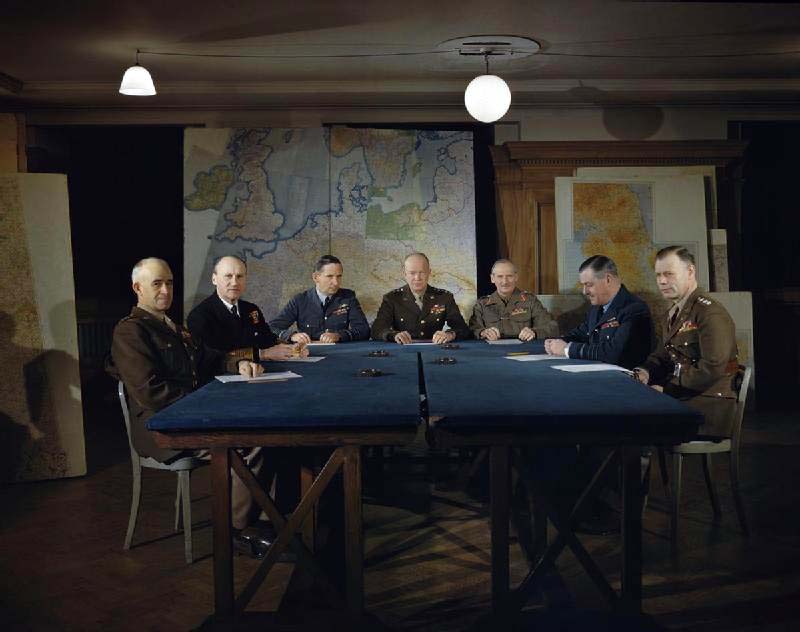
SHAEF (left to right): LTG Omar N. Bradley (US First Army), Adm Bertram H. Ramsay (Allied Naval Expeditionary Force), Air Chf Mshl Sir Arthur W. Tedder (Deputy Supreme Commander), GEN Dwight D. Eisenhower (Supreme Commander), Gen Sir Bernard L. Montgomery (21st Army Group), AVM Trafford Leigh-Mallory (Allied Expeditionary Air Forces), and LTG W. Bedell Smith (CS).
17 April 1944
The US 15AF launches three Boeing B-17s, escorted by 17 Lockheed P-38s, against the Ancona-Rimini railway of Italy. This strike is in support of the 15th Army Group’s advance on the “Gothic Line” and is the first operational use of the AZON smart bomb.
While the AZON (Azimuth-Only) bomb was developed specifically for interdiction against the Japanese in Burma, sixteen AZON-trained crews – six B-17s and 10 Consolidated B-24s – were diverted from their original assignment in the CBI to the 8AF and 15AFs, respectively. Essentially, AZON consists of a special 96 lb remote-controlled tail fin being attached to a standard AN-M65 1,000 lb or AN-M66 2,000 lb GP bomb. The former is classified the VB-1 and the latter the VB-2. The bomb operates using MCLOS (Manual Command Line Of Sight), streaming colored smoke so the bombardier can visually track it while radio-controlling the bomb's azimuth.
The 15AF launches 14 AZON strikes, all to poor effect, before abandoning the project on 11 August 1944, turning over its stock of AZONs to the 12AF. Similarly, the launches 10 AZON strikes (via the 458BG) before abandoning the project on 13 September, ostensibly because cloud cover hindered accurate sighting. More successful was the 10AF, whose compliment of five B-24s began operations on 1 November. Lacking heavy AAA and fighter resistance (a la the 15AF) or long seasons of poor weather (a la the 8AF), the 10AF’s AZON campaign was shockingly effective at destroying bridges in Burma. The 10AF’s AZON crews fly 25 operations, targeting 30 bridges (of which 27 are destroyed) before ending their campaign on 5 March 1945.
| 31 May 1944 | |
| Targets: (Bridges) | Beaumont-sur-Oise, France |
| Melun, France | |
| Praca Roissy-en-France, France | |
| Verberie, France | |
| Bombers Launched: | 5 |
| Bombers Effective: | 4 |
| Bombers Abort: | 1 |
| Abort Rate: | 20% |
| 4 June 1944 | |
| Targets: (Bridges) | Melun, France |
| Bombers Launched: | 6 |
| Bombers Effective: | 5 |
| Bombers Abort: | 1 |
| Abort Rate: | 17% |
| 14 June 1944 | |
| Target: (Bridge) | Ham, France |
| Bombers Launched: | 15 |
| Bombers Effective: | 12 |
| Bombers Abort: | 3 |
| Abort Rate: | 20% |
| 15 June 1944 | |
| Targets: (Bridges) | Étaples, France |
| Péronne, France | |
| Bombers Launched: | 14 |
| Bombers Effective: | 12 |
| Bombers Abort: | 2 |
| Abort Rate: | 14% |
| 22 June 1944 | |
| Targets: (Bridges) | Saumur, France |
| Tours, France | |
| Bombers Launched: | 10 |
| Bombers Effective: | 9 |
| Bombers Abort: | 1 |
| Abort Rate: | 10% |
| 17 August 1944 | |
| Target: (Bridge) | Esternay, France |
| Bombers Launched: | 10 |
| Bombers Effective: | 10 |
| 25 August 1944 | (8AF 571) |
| Target: (Bridge) | Moerdijk, Netherlands |
| Bombers Launched: | 10 |
| Bombers Effective: | 10 |
| 26 August 1944 | |
| Target: (Bridge) | Moerdijk, Netherlands |
| Bombers Launched: | 9 |
| Bombers Effective: | 9 |
| 1 September 1944 | |
| Target: (Bridge) | Ravenstein, Netherlands |
| Bombers Launched: | 12 |
| Bombers Effective: | 12 |
| 13 September 1944 | |
| Target: (Oil Refinery) | Hemmingstedt, Germany |
| Bombers Launched: | 11 |
| Bombers Effective: | 11 |
Sixteen AZON strikes were planned in total, with six scrubbed on account of weather. Of the ten above, only the strikes of 15 July 1944 and 22 July 1944 successfully hit their assigned targets.
| 17 April 1944 | |
| Target: (Railyard) | Ancona-Rimini, Italy |
| Bombers Launched: | 3 |
| Bombers Effective: | 0 |
| Fighters Launched: | 17 |
| Fighters Effective: | 0 |
| Bombers Abort: | 3 |
| Fighters Abort: | 17 |
| Abort Rate: | 100% |
| 24 April 1944 | |
| Target: (Rail Bridge) | Ancona-Rimini, Italy |
| Bombers Launched: | 5 |
| Bombers Effective: | 4 |
| Fighters Launched: | 18 |
| Fighters Effective: | 18 |
| Bombers Abort: | 1 |
| Abort Rate: | 20% |
| 29 April 1944 | |
| Target: (Rail Bridges) | Ancona-Rimini, Italy |
| Bombers Launched: | 5 |
| Bombers Effective: | 5 |
| Fighters Launched: | 24 |
| Fighters Effective: | 24 |
| 30 April 1944 | |
| Target: (Rail Bridges) | Ancona-Rimini, Italy |
| Bombers Launched: | 5 |
| Bombers Effective: | 5 |
| Fighters Launched: | 18 |
| Fighters Effective: | 17 |
| 10 May 1944 | |
| Target: (Rail Bridge) | Saint-Laurent-du-Var, France |
| Bombers Launched: | 4 |
| Bombers Effective: | 0 |
| Fighters Launched: | 36 |
| Fighters Effective: | 34 |
| Bombers Abort: | 4 |
| Fighters Abort: | 2 |
| Abort Rate: | 100% |
| 13 May 1944 | |
| Target: (Rail Bridge) | Trento, Italy |
| Bombers Launched: | 31 (4 AZON) |
| Bombers Effective: | 30 |
| Fighters Launched: | 51 |
| Fighters Effective: | 37 |
| Bombers Abort: | 1 |
| Fighters Abort: | 14 |
| Abort Rate: | 3% |
| 2 June 1944 | |
| Target: (Railyard) | Oradea, Romania |
| Bombers Launched: | 66 (1 AZON) |
| Bombers Effective: | 53 |
| Fighters Launched: | 50 |
| Fighters Effective: | 42 |
| Bombers MIA: | 1 |
| Bombers Abort: | 13 |
| Fighters Abort: | 8 |
| Abort Rate: | 20% |
| 6 June 1944 | |
| Target: (Railyard) | Drobeta-Turnu Severin, Romania |
| Bombers Launched: | 56 (6 AZON) |
| Bombers Effective: | 56 |
| Fighters Launched: | 47 |
| Fighters Effective: | 42 |
| Bombers MIA: | 1 |
| Fighters MIA: | 2 |
| Fighters Abort: | 5 |
| 25 June 1944 | |
| Target: (Rail Bridge) | Tarascon, France |
| Bombers Launched: | 5 |
| Bombers Effective: | 5 |
| Fighters Launched: | 42 |
| Fighters Effective: | 36 |
| Fighters Abort: | 8 |
| 2 July 1944 | |
| Target: (Rail Bridge) | Szolnok, Hungary |
| Bombers Launched: | 5 |
| Bombers Effective: | 5 |
| Bombers MIA: | 1 |
| Loss Rate: | 20% |
| 3 July 44 | |
| Target: (Rail Bridge) | Szeged, Hungary |
| Bombers Launched: | 4 |
| Bombers Effective: | 4 |
Figures on 15AF AZON strikes are incomplete.
US 8AF
| Aircraft Type | Serial No. | Name | Code | Unit |
| Consolidated B-24J-155-CO | 44-40285 | Table Stuff | J4-H | 753BS/458BG |
| Consolidated B-24J-155-CO | 44-40283 | Lassie Come Home | J4-I | 753BS/458BG |
| Consolidated B-24J-155-CO | 44-40287 | Bachelor's Bedlam | J4-J | 753BS/458BG |
| Consolidated B-24J-155-CO | 44-40264 | Kiss Me, Baby | J4-K | 753BS/458BG |
| Consolidated B-24J-155-CO | 44-40275 | Shack Time | J4-L | 753BS/458BG |
| Consolidated B-24J-155-CO | 44-40291 | Royal Flush | J4-O | 753BS/458BG |
| Consolidated B-24J-155-CO | 44-40277 | Miss Used | J4-P | 753BS/458BG |
| Consolidated B-24J-155-CO | 44-40281 | A Dog's Life | J4-Q | 753BS/458BG |
| Consolidated B-24J-155-CO | 44-40288 | Bad Girl | J4-S | 753BS/458BG |
| Consolidated B-24J-155-CO | 44-40273 | Howling Banshee | J4-T | 753BS/458BG |
US 10AF
| Consolidated B-24J-105-CF | 44-44501 | Spirit of Ft. Worth | 493BS/7BG |
US 15AF
| Boeing B-17G-35-BO | 42-32100 | Ragged But Right | 419BS/301BG |
| Boeing B-17G-35-BO | 42-32103 | 419BS/301BG |
| Boeing B-17G-35-BO | 42-32104 | St. Francis | 419BS/301BG |
| Boeing B-17G-35-BO | 42-32105 | Wolf Shack | 419BS/301BG |
| Boeing B-17G-35-BO | 42-32107 | 419BS/301BG |
| Boeing B-17G-35-BO | 42-32108 | FUBAR | 419BS/301BG |
Listing on 10AF AZON aircraft is incomplete.
19 April 1944
The Japanese Sixth (Chūjō Yasuji Okamura) and Eleventh Armies (Chūjō Isamu Yokoyama), under the Shina haken gun (China Expeditionary Force) (Taishō Shunroku Hata), initiate Operation ICHI-GO (Number One). The plan calls for Japanese forces to open a land-route to occupied French-Indochina (Việt Nam), in the process seizing US 14AF and 20AF bases in southern-China. Boeing B-29s only began arriving in China two weeks prior under Operation MATTERHORN. A product of the Quebec Conference (QUADRANT) and approved on 12 October 1943, MATTERHORN called for the creation of US bases around Guangxi. Now with Guangxi under attack, MATTERHORN is forced to divert its resources to Chengdu. Much to the dismay of CG China GEN Joseph W. Stillwell, Chinese premier Tèjí Shàngjiàng Chiang Kai-shek throws his support behind CG 14AF LTG Claire L. Chennault’s promise to halt the advance through tactical airpower. Chennault, and by extension Kai-Shek, fails to make any significant headway against the Japanese, and insists upon additional supplies and a complete takeover of the 20AF and its assets.
MATTERHORN is by no means up to this task. With the reopening of the Burma Road still months away, Chinese supplies must be flown over the Himalayas from bases in British India. This is a logistical nightmare. While MATTERHORN uses B-29s as impromptu tankers, on average, the bombers use more fuel than they actually deliver. Worse, the B-29’s finicky engines require regular overhauls, a task made nearly impossible at the extreme edges of Allied supply lines. In the wake of China’s pitiful performance against the Japanese - and as a political ploy to pull power away from Chiang (whom he detests) - Stillwell calls for Chiang to release control of his armies. When Pres. Franklin D. Roosevelt (D-NY) backs Stillwell, Chiang digs in, demanding Stillwell’s removal. A fact-finding mission led by the eccentric Sen. Patrick J. Hurley (R-OK) attempts to mend relations but ultimately agrees that Stillwell should be removed from office. He is replaced by the more pragmatic LTG Albert Wedemeyer. The primary issue in Chiang's mind had long been the threat of Chinese Communists, and Wedemeyer and Hurley vainly argued that the US State Department was dangerously naïve in urging Chiang to make concessions to the Communists in order to fight the Japanese. This backfires as, combined with the removal of Stillwell, the US government becomes increasingly dismissive of China as corrupted beyond redemption. It certainly does not help that, with the success of the island-hopping campaign, China is no longer necessary for a strategic victory against Japan. Japanese forces reach French Indochina in December, and the remaining B-29s in the CBI are all transferred to the Marianas by April 1945.
Also on this day, Supreme Commander AEF GEN Dwight D. Eisenhower orders his air commanders give top priority to those targets specified under Operation CROSSBOW. First implemented with the 17 August 1943 RAF strike against Peenemünde, Germany, CROSSBOW targets Germany’s Vergeltungswaffen (Reprisal Weapon) program. Allied intelligence was aware of this program long before the first V-1 and V-2 missile launches and expressed concern over the possibility of chemical and biological attacks. As such, responsibility is placed on the 21st Army Group (FM Sir Bernard L. Montgomery) and the AEAF (AVM Trafford Leigh-Mallory) to destroy and secure the V-weapon launch sites. While the first V-1 strike takes place on 13 June 1944 and the first V-2 strike on 8 September 1944, no V-weapon launch is ever made using chemical or biological material.
CROSSBOW is bitterly resisted by Allied airmen and is treated as a poor weather alternative (code-named NO BALL) to strategic operations. However, with USSTAF and RAF BC being under SHAEF’s operational control since 14 April 1944, NO BALLs become a regular task. Eisenhower’s deputy, Air Chf Mshl Sir Arthur W. Tedder, issues a target list on 10 July, assigning six targets to the tactical fighter commands, 30 to RAF BC, and 68 to the USSTAF. While CG USSTAF LTG Carl A. Spaatz bitterly protests, he is nevertheless overruled. In all, over a quarter of all USAAF tonnage dropped in the summer of 1944 is on V-1 and V-2 missile sites in Northern Europe. Postwar analysis reveals that these strikes were, in fact, ineffective.
30 April 1944
Boeing sets a world record for heavy bomber production, its Seattle, WA plant producing 16 bombers in 24 hours. Of the 12,731 Boeing B-17s produced during the bomber’s service life, only 54 are produced prior to the outbreak of war in Europe. When the US finally entered the war, B-17s are produced not only through Boeing, but through contracts with Lockheed-Vega’s in Burbank, CA and Douglas Aircraft’s in Long Beach, CA. These contracts respectively produce 2,750 and 3,000 bombers each, with Boeing still constructing the vast majority with some 6,981 B-17s by war’s end. What is all the more remarkable is just how typical this feat of engineering managed to become. The B-17 is not a design conducive to assembly-line production, averaging some $238,000 a piece ($3.2 million adjusted for inflation), which explains why the B-17 is by no means the most heavily produced bomber of the war. Just the same, Boeing’s achievement this day is a strong indicator that the USAAF’s bomber offensive against Germany has reached a point where adequate numbers of aircraft are no longer an issue.
6 May 1944
RAF BC this night launches 77 Handley Page Halifaxes, 12 de Havilland Mosquitoes, and 180 Avro Lancasters against Mantes-la-Jolie, Sablé-sur-Sarthe, and Aubigné-Racan, France. One of the bombers is Lancaster Mk I “S for Sugar” (R5868, 467 Squadron) who on this night becomes the first Lancaster to complete 100 combat missions. She goes on to complete another 39 combat missions by the war’s end. (54 killed)
The Avro Lancaster Mk I “S for Sugar” is currently on display at the Royal Air Force Museum just outside of London.
| Bombers Launched: | 269 |
| Bombers Effective: | 261 |
| Bombers MIA: | 4 |
| Bombers Abort: | 8 |
| Abort Rate: | 3% |
| Loss Rate: | 1% |
| Aircraft Type | Serial No. | Code | Unit | |
| Handley Page Halifax Mk. III | LV943 | G | 466 Squadron | |
| Avro Lancaster Mk. III | ND449 | M | 156 Squadron | |
| Avro Lancaster Mk. III | ND617 | B | 405 Squadron | |
| Avro Lancaster Mk. III | ND783 | C2 | 576 Squadron |
10 May 1944
CG USAAF GEN Henry H. Arnold suffers his third heart attack of the war. This event is probably related to the development of the Boeing B-29 Superfortress.
The B-29 represents one of the greatest leaps forward in the history of aviation but does so at a staggering cost – at $3 billion (some $43 billion when adjusted for inflation), the development of the B-29 costs more than even the entire Manhattan Project at $2 billion (some $29 billion when adjusted for inflation). While most military aircraft, particularly large ones, have a developmental period of 5-6 years, the B-29 is completed in half that time. By no means a simple design, alterations, production, and product testing are all done simultaneously, and it is for this reason that the B-29 program is rife with technical issues – as was clearly illustrated with the death of Eddie Allen in February 1943. Now entering production, B-29s are unsurprisingly found rolling off the assembly lines with serious mechanical issues, delaying the delivery of aircraft to combat units.
When Arnold visited Boeing’s Wichita, KS plant – the first plant designated for B-29 production – on 11 January 1944, only 16 of the 97 B-29s built at that time were actually flyable. Engines constantly overheated (the defect that killed Eddie Allen), poor quality Plexiglas and XLR cables needed replacing, and weight between aircraft varied wildly due to construction inconsistencies. Worse, the Wichita plant was also tasked with production of CG-4 gliders for the upcoming invasion of France. Arnold signed his name on sub-assembly no. 175, stating that he would return on 1 March expecting to see said aircraft completed. The goal was not met. With B-29 units already trained and ready for their aircraft, MG Bennett E. Meyers of Materiel Command is charged with overseeing production. CG-4 and B-29 sub-assembly production is temporarily halted, mechanics are brought in from across the US, and work is conducted at a back-breaking pace in subzero weather, with mechanics using ovens to warm their tools. Thanks to these efforts, the first B-29, Gone With The Wind (42-6331, 40BG), reached India on 2 April 1944.
Arnold spends 10 days recuperating from his heart attack before departing for a tour of the Normandy beaches with CSA GA George C. Marshall. Arnold is not the only one whose health is affected by the frantic pace of the B-29 program, as Boeing CEO Philip G. Johnson suffers a massive stroke visiting the Wichita plant on 13 September 1944. Johnson does not survive.
12 May 1944
The US 8AF launches 621 Boeing B-17s and 265 Consolidated B-24s, escorted by 153 Lockheed P-38s, 201 Republic P-47s, and 381 North American P-51s (with an additional 245 fighters loaned from the 9AF), against the Interessen-Gemeinschaft Farbenindustrie (Dye Industry Interest Community or IG Farben) of Leuna (Merseburg), the Wintershall Holding plant of Mücheln (Lützkendorf), the Auto Union plant at Zwickau, the Sudetenländische Treibstoffwerke (Sudetenland Fuel Works) of Brüx (Most), and the Braunkohlen Benzin (Brown Coal/Benzine or BRABAG) plants of Böhlen and Zeitz, Germany.
While USSTAF is still under the temporary control of CO AEAF AVM Trafford Leigh-Mallory, CG USSTAF LTG Carl A. Spaatz is nevertheless given the option to implement his oil plan when practicable. As such, this is the ETO's first strike of the USSTAF Oil Campaign.
| Bombers Launched: | 886 |
| Bombers Effective: | 814 |
| Fighters Launched: | 735 |
| Bombers MIA: | 46 |
| Bombers DBR: | 9 |
| Bombers Abort: | 72 |
| Fighters MIA: | 7 |
| Abort Rate: | 8% |
| Loss Rate: | 5% |
| E/A Destroyed: | 88 |
| Aircraft Type | Serial No. | Name | Code | Unit | MACR |
| Boeing B-17F-115-BO | 42-30644 | UX-V | 327BS/92BG | 4851 |
| Boeing B-17G-25-BO | 42-31704 | QE-P | 331BS/94BG | 4826 |
| Boeing B-17G-55-BO | 42-102584 | Bottled In Bond | XM-unk | 332BS/94BG | 15260 |
| Boeing B-17G-5-VE | 42-39884 | ET-N | 336BS/95BG | 4854 |
| Boeing B-17F-130-BO | 42-31014 | Smokey Stover, Jr. | AW-A | 337BS/96BG | 5093 |
| Boeing B-17G-45-BO | 42-97382 | AW-K | 337BS/96BG | 4859 |
| Boeing B-17G-50-BO | 42-102452 | AW-R | 337BS/96BG | 4862 |
| Boeing B-17G-25-BO | 42-31718 | AW-T | 337BS/96BG | 4857 |
| Boeing B-17G-15-BO | 42-31343 | Myna Myra | BX-E | 338BS/96BG | 4855 |
| Boeing B-17G-20-BO | 42-31621 | Stormy Weather | BX-L | 338BS/96BG | 4856 |
| Boeing B-17G-35-DL | 42-107123 | BX-unk | 338BS/96BG | 5359 |
| Boeing B-17G-35-DL | 42-107189 | Seventh Son | QJ-M | 339BS/96BG | 4864 |
| Boeing B-17G-40-BO | 42-97167 | QJ-N | 339BS/96BG | 4858 |
| Boeing B-17G-55-BO | 42-102571 | QJ-U | 339BS/96BG | 4863 |
| Boeing B-17G-24-VE | 42-97654 | MZ-J | 413BS/96BG | 4861 |
| Boeing B-17G-20-VE | 42-97567 | MZ-K | 413BS/96BG | 4860 |
| Boeing B-17G-40-BO | 42-97127 | Miss Ma' Lovin' | XR-J | 349BS/100BG | 4867 |
| Boeing B-17G-20-BO | 42-31504 | Rosie's Riveters | LN-Q | 350BS/100BG | 4865 |
| Boeing B-17G-30-BO | 42-31787 | GX-N | 548BS/385BG | 4879 |
| Boeing B-17G-20-BO | 42-31549 | Jeannie | H | 561BS/388BG | 4881 |
| Boeing B-17G-35-DL | 42-107020 | CQ-unk | 708BS/447BG | 4773 |
| Boeing B-17G-80-BO | 42-38164 | Virginia Lee | IE-unk | 709BS/447BG | 4767 |
| Boeing B-17G-30-VE | 42-97794 | IE-unk | 709BS/447BG | 4769 |
| Boeing B-17G-35-DL | 42-107072 | IJ-unk | 710BS/447BG | 4774 |
| Boeing B-17G-30-VE | 42-97815 | IJ-unk | 710BS/447BG | 4770 |
| Boeing B-17G-50-BO | 42-102395 | IR-unk | 711BS/447BG | 4771 |
| Boeing B-17G-45-BO | 42-97179 | IR-unk | 711BS/447BG | 4768 |
| Boeing B-17G-45-BO | 42-97209 | 9Z-A | 728BS/452BG | 4777 |
| Boeing B-17G-5-VE | 42-39937 | Duchess | 9Z-G | 728BS/452BG | 4818 |
| Boeing B-17G-45-BO | 42-97361 | Punched Fowl | 9Z-K | 728BS/452BG | 4821 |
| Boeing B-17G-15-BO | 42-31345 | Lady Stardust II | 9Z-unk | 728BS/452BG | 5021 |
| Boeing B-17G-45-BO | 42-97371 | Hairless Joe | 9Z-unk | 728BS/452BG | 4822 |
| Boeing B-17G-35-VE | 42-97864 | Why Worry II | 9Z-unk | 728BS/452BG | 4779 |
| Boeing B-17G-35-DL | 42-107089 | 9Z-unk | 728BS/452BG | 4780 |
| Boeing B-17G-40-BO | 42-97235 | M3-H | 729BS/452BG | 4778 |
| Boeing B-17G-40-BO | 42-97143 | You've Had It | M3-P | 729BS/452BG | 4776 |
| Boeing B-17G-30-VE | 42-97786 | Hard Way | M3-unk | 729BS/452BG | 4823 |
| Boeing B-17G-75-BO | 42-37947 | Princess Pat | 6K-Q | 730BS/452BG | 4816 |
| Boeing B-17G-5-VE | 42-39902 | 6K-unk | 730BS/452BG | 4817 |
| Boeing B-17G-5-VE | 42-39939 | 6K-unk | 730BS/452BG | 4818 |
| Boeing B-17G-5-VE | 42-39941 | Lucky Lady | 7D-G | 731BS/452BG | 4819 |
| Boeing B-17G-10-VE | 42-39976 | My Achin' Back | 7D-K | 731BS/452BG | 4820 |
| Boeing B-17G-20-BO | 42-31607 | Rose Olive | B | 748BS/457BG | 4800 |
| Consolidated B-24J-130-CO | 42-110042 | NB-J | 67BS/44BG | 4850 |
| Consolidated B-24J-50-CO | 42-73503 | Marion | YM-Y | 409BS/93BG | 4828 |
| Consolidated B-24H-10-DT | 41-28715 | YO-I | 564BS/389BG | 5217 |
| Aircraft Type | Serial No. | Pilot | Code | Unit | MACR |
| Republic P-47D-10-RE | 42-75162 | 1LT Jack E. Greene | LM-J | 62FS/56FG | 4689 |
| Republic P-47D-6-RE | 42-74750 | LTC Preston Piper | UN-L | 63FS/56FG | 4805 |
| Republic P-47D-10-RE | 42-75109 | 2LT Willard D. Johnson | UN-W | 63FS/56FG | 4806 |
| Republic P-47D-22-RE | 42-26025 | 1LT Daniel D. Hagarty | MX-R | 82FS/78FG | 4692 |
| North American P-51B-5-NA | 43-6929 | 2LT Alfred P. Howard, Jr | HO-X | 487FS/352FG | 4696 |
| North American P-51B-5-NA | 43-6634 | 2LT Roger A. Hilsted | G4-C | 362FS/357FG | 4700 |
| North American P-51B-10-NA | 42-106777 | CPT John B. Carder | C5-J | 364FS/357FG | 4701 |
28 May 1944
The US 8AF launches 924 Boeing B-17s and 417 Consolidated B-24s, escorted by 182 Lockheed P-38s, 208 Republic P-47s, and 307 North American P-51s, against the Eifeltor marshalling yards of Cologne, the Junkers factory of Dessau, the oil dump of Königsberg (present-day Kaliningrad), the IG Farben plant of Leuna, and the BRABAG plants of Madgeburg, Schwarzheide, and Zeitz, Germany. Elements of this strike – 59 B-17s of the 41BW – drop 113 specially-designed bombs over Cologne. This is the first use of the Aeronca GB-1 2,000 lb glide bomb.
Known as “bat bombs,” the GB-1 was thought to offer greater precision and the ability to strike beyond enemy defenses. Mounting a 12 ft wing and tail assembly to a standard AN-M66 2,000 lb bomb, the GB-1 uses a gyroscoped autopilot to hold its course once dropped some 20 mi from target. The GB-1 proves to be a failure, with only 42 of those against Cologne actually hitting due to high winds and battery failures. While the 8AF never again uses the GB-1, other air forces continue experiment with the bomb until the project’s termination in January 1945.
| Bombers Launched: | 1,341 |
| Bombers Effective: | 864 |
| Fighters Launched: | 697 |
| Bombers MIA: | 32 |
| Bombers DBR: | 1 |
| Bombers Abort: | 477 |
| Fighters MIA: | 9 |
| Fighters DBR: | 3 |
| Abort Rate: | 36% |
| Loss Rate: | 2% |
| E/A Destroyed: | 50 |
| Aircraft Type | Serial No. | Name | Code | Unit | MACR |
| Boeing B-17G-15-BO | 42-31389 | Luscious Lucy | EP-J | 351BS/100BG | 5382 |
| Boeing B-17G-35-DL | 42-107028 | VK-I | 358BS/303BG | 5340 | |
| Boeing B-17G-5-VE | 42-39878 | War Eagle | XK-S | 365BS/305BG | 5336 |
| Boeing B-17G-30-BO | 42-31757 | Round Trip | YB-G | 508BS/351BG | 5333 |
| Boeing B-17G-25-BO | 42-31721 | Black Magic | TU-S | 510BS/351BG | 5334 |
| Boeing B-17G-10-VE | 42-39987 | Pin Ball | DS-D | 511BS/351BG | 5328 |
| Boeing B-17G-15-VE | 42-97472 | Slow Ball | DS-H | 511BS/351BG | 5329 |
| Boeing B-17G-45-BO | 42-97191 | Silver Ball | DS-X | 511BS/351BG | 5326 |
| Boeing B-17G-35-VE | 42-97847 | Four Freedoms | XA-Q | 549BS/385BG | 5265 |
| Boeing B-17G-1-VE | 42-39845 | Hulcher's Vultures | B | 563BS/388BG | 5317 |
| Boeing B-17G-50-BO | 42-102485 | Bare Essentials | R | 562BS/388BG | 5316 |
| Boeing B-17G-50-BO | 42-102440 | Silver Slipper | BI-K | 568BS/390BG | 5254 |
| Boeing B-17G-35-BO | 42-31985 | Devil's Aces | DI-P | 570BS/390BG | 5258 |
| Boeing B-17G-35-BO | 42-32089 | Mountaineer | DI-W | 570BS/390BG | 5257 |
| Boeing B-17G-25-BO | 42-31651 | Decatur Deb | FC-G | 571BS/390BG | 5259 |
| Boeing B-17G-15-DL | 42-37806 | Stark's Ark | FC-Z | 571BS/390BG | 5256 |
| Boeing B-17G-1-BO | 42-31034 | Bonnie Donnie | SC-G | 612BS/401BG | 5309 |
| Boeing B-17G-1-VE | 42-39837 | Red's Rogues | SC-L | 612BS/401BG | |
| Boeing B-17G-55-BO | 42-102647 | BTO in the ETO | IN-G | 613BS/401BG | 5305 |
| Boeing B-17G-55-BO | 42-102581 | Lonesome Polecat | IN-L | 613BS/401BG | 5306 |
| Boeing B-17G-55-BO | 42-102580 | IN-Q | 613BS/401BG | 5307 | |
| Boeing B-17G-20-BO | 42-31557 | IN-R | 613BS/401BG | 5308 | |
| Boeing B-17G-40-BO | 42-97073 | IY-N | 615BS/401BG | 5311 | |
| Boeing B-17G-20-BO | 42-31520 | A | 751BS/457BG | 5300 | |
| Boeing B-17G-15-VE | 42-97452 | L | 751BS/457BG | 5296 | |
| Boeing B-17G-40-BO | 42-97067 | Black Puff Polly | Y | 748BS/457BG | 5297 |
| Consolidated B-24J-130-CO | 42-110045 | Banana Barge | GJ-K | 506BS/44BG | 5353 |
| Consolidated B-24J-130-CO | 42-110074 | Satan's Mate | HP-P | 567BS/389BG | 5387 |
| Consolidated B-24H-20-CF | 42-50346 | Shoo, Shoo Baby | RN-M | 703BS/445BG | 5302 |
| Consolidated B-24H-20-CF | 42-50345 | 3R-B | 832BS/486BG | 5389 | |
| Consolidated B-24H-15-FO | 42-52764 | Spirit of LSU | 4N-O | 833BS/486BG | 5390 |
| Consolidated B-24H-15-FO | 42-52651 | Star Duster | 4F-R | 837BS/487BG | 5223 |
| Aircraft Type | Serial No. | Pilot | Code | Unit | MACR |
| Republic P-47D-22-RE | 42-26064 | 1LT Philip H. Hazelett | MX-M | 82FS/78FG | 5028 |
| Republic P-47D-15-RE | 42-76318 | 2LT William S. Orvis, Jr. | MX-W | 82FS/78FG | 5026 |
| Republic P-47D-22-RE | 42-26016 | CPT Alvin M. Juchheim | HL-A | 83FS/78FG | 5280 |
| Republic P-47D-11-RE | 42-75457 | 2LT Joseph R. Farley | YJ-A | 351FS/353FG | 5027 |
| North American P-51B-15 | 42-106846 | 2LT Richard L. Bopp | QP-H | 334FS/4FG | 5726 |
| North American P-51B-7 | 43-6933 | 2LT Aubrey E. Hewatt | QP-Y | 334FS/4FG | 5397 |
| North American P-51B-10 | 42-106635 | CPT Woodrow W. Anderson | PZ-A | 486FS/352FG | 5099 |
| North American P-51B-7 | 43-6983 | 2LT Walter M. Christensen | WR-O | 354FS/355FG | 5202 |
| North American P-51B-5 | 43-6631 | 1LT Clarence R. Barger | WR-T | 354FS/355FG | 5360 |
In preparation for the upcoming invasion of France, the US 8AF begins transitioning its fighter groups to P-51s (the sole exception being the 56FG, who retain their P-47s). The P-47s, with their heavy gun package and strong design, are now destined to see usage as fighter-bombers in US 9AF. This shift coincides with the arrival of the first bubble canopy aircraft to frontline units. Aircraft designers had long struggled with the problem of pilot visibility, and for most of the 1930s and early-1940s, the standard had been the so-called “razorback” canopy. Razorback canopies tapered in behind the pilot’s headrest, giving a slight degree of sight over each shoulder. In 1941 a British firm, R. Malcolm & Co. of Slough, introduced the “Malcolm hood” for use on the Supermarine Spitfire Mk. V, which blew out the rounded edges of the canopy just enough that a pilot could lean beyond the fuselage for a better view. This increasing sophistication of Plexiglas technology – ever difficult to mold – is what allowed for the final bubble canopy, first introduced by Miles Aircraft of Woodley, then perfected by Hawker Aviation of London in early-1944. With the new bubble canopy, fighter pilots possessed an unobstructed view of the air around them. The US is quick to seize upon the design, with the first US “bubbletop” fighters being the P-47D-25 and P-51D. Bubble canopies remain standard on fighter aircraft throughout the world to this day.
2 June 1944
The US 15AF launches 130 Boeing B-17s, escorted by 70 North American P-51s, against the railyards of Debrecen, Hungary under Operation FRANTIC. A potential long sought by US leaders, FRANTIC seeks to extend the range of US airstrikes by allowing bombers to rearm and refuel at bases in Soviet occupied territory - namely, Poltava and Myrhorod, Ukraine. CG MAAF LTG Ira C. Eaker leads the first FRANTIC operation, flying on from the target to Poltava, launching strikes from Soviet bases on 6 June (the airfield of Galați) and 11 June (the airfield of Focșani) before returning to Italy.
The US 8AF launches its first FRANTIC strike on 21 June, sending 163 B-17s, escorted by 72 Lockheed P-38s, 38 Republic P-47s, and 122 P-51s, under BG Archie J. Old, Jr. against the BRABAG plant of Schwarzheide, Germany. That night, the German discovery of the base at Poltava results in Operation ZAUNKOENIG (Wren), wherein a force of He-111s and Ju-88s under ObtLt Wilheelm Antrup destroys 64 of the 73 B-17s parked there. This disaster is indicative of a greater failure.
While FRANTIC made sense on paper, the political reality of US-Soviet joint operations is problematic. The Roosevelt administration had long suffered from an almost willful ignorance toward the realities of communism. FRANTIC was no exception, the concept being lobbied for by the president's son, COL Elliott Roosevelt, whose rapid rise through the ranks was clearly more the result of nepotism than actual competence. Soviet officers are uncooperative and hostile, overruling target choices, refusing to repatriate US POWs, and rejecting the installation of US night fighters and AAA for base defense. The final straw comes in August with the Warsaw Uprising, the Soviets deliberately waiting for the Germans to put down the uprising before liberating the city. US outrage over this results in a declaration from Narodnyĭ Komissariat Po Inostrannym Delam (People’s Commissariat for Foreign Affairs) Vyacheslav M. Molotov that support from USSTAF is no longer desired, with cases of assault and theft doubling almost overnight. As such, FRANTIC is brought to a halt in September, with a mere seven shuttle missions being flown by war’s end. While it had been hoped that FRANTIC would open doors to a potential strategic air campaign against Japan from Vladivostok, the failure of FRANTIC is assuaged by the securing of Saipan on 9 July.
| FRANTIC I (15AF) | |
| 2 June 1944 (Italy to Ukraine) | |
| Target: (Railyard) | Debrecen, Hungary |
| Bombers Launched: | 130 |
| Bombers Effective: | 130 |
| Fighters Launched: | 70 |
| Fighters Effective: | 64 |
| Fighters Abort: | 6 |
| 6 June 1944 (Ukraine) | |
| Target: (Airfield) | Galați, Romania |
| Bombers Launched: | 112 |
| Bombers Effective: | 108 |
| Fighters Launched: | 47 |
| Fighters Effective: | 42 |
| Bombers Abort: | 6 |
| Fighters MIA: | 2 |
| Fighters Abort: | 5 |
| Abort Rate: | 5% |
| 11 June 1944 (Ukraine to Italy) | |
| Target: (Airfield) | Focșani, Romania |
| Bombers Launched: | 126 |
| Bombers Effective: | 121 |
| Fighters Launched: | 52 |
| Fighters Effective: | 48 |
| Bombers Abort: | 5 |
| Fighters Abort: | 4 |
| Abort Rate: | 4% |
| FRANTIC II (8AF) | |
| 21 June 1944 (UK to Ukraine) | |
| Target: (Oil) | Schwarzheide, Germany |
| Bombers Launched: | 163 |
| Bombers Effective: | 145 |
| Fighters Launched: | 232 (65 to Ukraine) |
| Bombers MIA: | 1 |
| Bombers Abort: | 18 |
| Fighters MIA: | 4 |
| Abort Rate: | 11% |
| 26 June 1944 (Ukraine to Italy) | |
| Target: (Oil) | Drohobych, Ukraine |
| Bombers Launched: | 73 |
| Bombers Effective: | 72 |
| Fighters Launched: | 103 (55 to Italy) |
| Bombers Abort: | 1 |
| Abort Rate: | 1% |
| 3 July 1944 (Italy) | |
| Target: (Railyard) | Arad, Romania |
| Bombers Launched: | 106 (57 8AF) |
| Bombers Effective: | 99 (55 8AF) |
| Fighters Launched: | 90 (42 8AF) |
| Fighters Effective: | 85 (42 8AF) |
| Bombers MIA: | 2 (1 8AF) |
| Bombers Abort: | 7 (2 8AF) |
| Fighters MIA: | 1 |
| Fighters Abort: | 5 |
| Abort Rate: | 7% (4% 8AF) |
| Loss Rate: | 2% (2% 8AF) |
| 5 July 1944 (Italy to UK) | |
| Target: (Railyard) | Béziers, France |
| Bombers Launched: | 171 (71 8AF) |
| Bombers Effective: | 96 (70 8AF) |
| Fighters Launched: | 291 (253 8AF) |
| Fighters Effective: | 260 (228 8AF) |
| Bombers Abort: | 75 (1 8AF) |
| Fighters MIA: | 4 (3 8AF) |
| Fighters Abort: | 31 (25 8AF) |
| Abort Rate: | 44% (1%) |
| FRANTIC III (15AF) | |
| 22 July 1944 (Italy to Ukraine) | |
| Target: (Airfield) | Zilișteanca, Ukraine |
| Fighters Launched: | 136 |
| Fighters Effective: | 118 |
| Fighters MIA: | 5 |
| Fighters Abort: | 18 |
| Abort Rate: | 4% |
| Loss Rate: | 13% |
| 25 July 1944 (Ukraine) | |
| Target: (Airfield) | Mielec, Poland |
| Fighters Launched: | 78 |
| Fighters Effective: | 67 |
| Fighters Abort: | 11 |
| Abort Rate: | 14% |
| 26 July 1944 (Ukraine to Italy) | |
| Target: (Fighter Sweep) | Bucharest, Romania |
| Ploiești, Romania | |
| Fighters Launched: | 102 |
| Fighters Effective: | 98 |
| Fighters MIA: | 2 |
| Fighters Abort: | 4 |
| Abort Rate: | 4% |
| Loss Rate: | 2% |
| FRANTIC IV (15AF) | |
| 4 August 1944 (Italy to Ukraine) | |
| Target: (Fighter Sweep) | Focșani, Romania |
| Fighters Launched: | 89 |
| Fighters Effective: | 79 |
| Fighters MIA: | 7 |
| Fighters Abort: | 10 |
| Abort Rate: | 11% |
| Loss Rate: | 8% |
| 6 August 1944 (Ukraine to Italy) | |
| Target: (Fighter Sweep) | Bucharest, Romania |
| Ploiești, Romania | |
| Fighters Launched: | 60 |
| Fighters Effective: | 53 |
| Fighters Abort: | 7 |
| Abort Rate: | 12% |
| FRANTIC V (8AF) | |
| 6 August 1944 (UK to Ukraine) | |
| Target: (Aircraft Industry) | Gdynia, Poland |
| Bombers Launched: | 78 |
| Bombers Effective: | 75 |
| Fighters Launched: | 160 |
| Fighters Effective: | 154 |
| Bombers Abort: | 3 |
| Fighters MIA: | 4 |
| Fighters DBR: | 1 |
| Fighters Abort: | 6 |
| Abort Rate: | 4% |
| 7 August 1944 (Ukraine) | |
| Target: (Oil) | Trzebinia, Poland |
| Bombers Launched: | 55 |
| Bombers Effective: | 55 |
| Fighters Launched: | 29 |
| 8 August 1944 (Ukraine to Italy) | |
| Target: (Airfield) | Bizau, Austria |
| Zilișteanca, Romania | |
| Bombers Launched: | 78 |
| Bombers Effective: | 73 |
| Fighters Launched: | 55 |
| Bombers Abort: | 5 |
| Abort Rate: | 6% |
| 12 August 1944 (Italy to UK) | |
| Target: (Airfield) | Toulouse, France |
| Bombers Launched: | 69 |
| Bombers Effective: | 64 |
| Fighters Launched: | 87 |
| Fighters Effective: | 81 |
| Bombers Abort: | 5 |
| Fighters Abort: | 6 |
| Abort Rate: | 7% |
| FRANTIC VI (8AF) | |
| 11 September 1944 (UK to Ukraine) | |
| Target: (Oil) | Chemnitz, Germany |
| Bombers Effective: | 75 |
| Fighters Effective: | 64 |
| Fighters MIA: | 1 |
| 13 September 1944 (Ukraine to Italy) | |
| Target: (Steel Works) | Diósgyőr, Hungary |
| Bombers Launched: | 74 |
| Bombers Effective: | 73 |
| Fighters Launched: | 63 |
| Fighters Effective: | 63 |
| Bombers Abort: | 1 |
| Abort Rate: | 1% |
| 15 September 1944 (UK to Ukraine) | |
| Target: (Supply Drop) | Warsaw, Poland |
| Bombers Launched: | 110 (Recalled) |
| Fighters Launched: | 156 |
| Fighters Effective: | 149 |
| Fighters MIA: | 2 |
| Fighters Abort: | 7 |
| 17 September 1944 (Italy to UK) | |
| Bombers Launched: | 72 |
| Fighters Launched: | 59 |
| FRANTIC VII (8AF) | |
| 18 September 1944 (UK to Ukraine) | |
| Target: (Supply Drop) | Warsaw, Poland |
| Bombers Launched: | 110 |
| Bombers Effective: | 107 |
| Fighters Launched: | 150 |
| Fighters Effective: | 137 |
| Bombers MIA: | 1 |
| Bombers Abort: | 3 |
| Fighters MIA: | 2 |
| Fighters Abort: | 13 |
| Abort Rate: | 3% |
| Loss Rate: | 1% |
| 19 September 1944 (Ukraine to Italy) | |
| Target: (Railyard) | Szolnok, Hungary |
| Bombers Launched: | 100 |
| Fighters Launched: | 61 |
| 19 September 1944 (Ukraine to Italy) | |
| Bombers Launched: | 10 |
| Fighters Launched: | 8 |
| 22 September 1944 (Italy to UK) | |
5 June 1944
The Boeing B-29 flies its first combat mission when US XX BC (20AF) launches 98 B-29s out of Chengdu, China against the marshalling yards of Bangkok, Thailand. To prevent interservice rivalry between theaters of operation, the newly formed 20AF is commanded directly by CG USAAF GEN Henry H. Arnold (at this time recovering from his third heart attack), with XX BC being commanded by MG Kenneth B. Wolfe. An engineer, Wolfe oversaw the rushed development of the B-29 and it was hoped that he could straighten-out the problematic Operation MATTERHORN. This is not realistic as, on average, seven tanker flights over the Himalayas are required for a single combat operation against Japan.
On the recommendation of the COA, XX BC’s primary targets in the coming months are to be the steel production facilities of Manchuria, China and Kyūshū, Japan. No bombers are lost to enemy action on this strike, its losses being solely the result of the B-29’s technical problems. These issues plague the B-29’s entire first year of service.
| Bombers Launched: | 98 | |
| Bombers Effective: | 77 | |
| Bombers MIA: | 5 | |
| Bombers Abort: | 21 | |
| Abort Rate: | 21% | |
| Loss Rate: | 5% | |
| Aircraft Type | Serial No. | Name | Code | Unit | MACR |
| Boeing B-29-5-BW | 42-6282 | unk | 395BG/40BG | 5861/6602 | |
| Boeing B-29-5-BW | 42-6304 | unk | 395BS/40BG | 5860/6603 | |
| Boeing B-29-10-BW | 42-6318 | unk | 395BS/40BG | ||
| Boeing B-29-15-BW | 42-6361 | unk | 678BS/444BG | ||
| Boeing B-29-10-BW | 42-6336 | unk | 771BS/462BG |
Also on this day, the US Fifth Army (LTG Mark W. Clark) declares the city of Rome, Italy secure after liberating it the previous day. Clark’s race to Rome remains one of the most controversial acts in US military history as Clark disobeyed a direct order from 15th Army Group commander Gen the Hon. Sir Harold R. L. G. Alexander in doing so. Having broken out of the Anzio beachhead, 15th Army Group had an opportunity to encircle the German Tenth Army (GenObt Heinrich von Vietinghoff) as they retreated from the Gustav-Line. By taking possession of Rome, the German Tenth Army was allowed to escape, fighting a defense-in-depth as they dug into the mountainous terrain of Northern Italy.
Lastly, in attempt to prevent another friendly-fire incident akin to that suffered in HUSKY, SHAEF orders all Allied aircraft in the ETO visible to the naked-eye (i.e., fighters, medium bombers, and cargo aircraft) be painted with black and white stripes on their wings and fuselage. Hurriedly painted, these stripes remain in use throughout the rest of the war, though enforcement of the order eventually relaxes.
6 June 1944
The US First (LTG Omar N. Bradley) and British Second Armies (Lt-Gen Miles C. Dempsey), under the 21st Army Group (Gen Sir Bernard L. Montgomery), initiate Operation OVERLORD and begin the invasion of France. Poor weather forced the delay of the invasion from May, as planned, to this date. Following a lengthy push through the surrounding hedgerow country, additional armies are brought in through Cherbourg and the makeshift floating harbors around Normandy: the Canadian First Army (LGen Henry D. G. Crerar), the US Third Army (LTG George S. Patton, Jr.), the US Ninth Army (LTG William H. Simpson), and the US Fifteenth Army (LTG Leonard T. Gerow) – the last being an army of occupation. Personnel problems between the Allies force a reorganization the following September wherein the US armies are grouped under the 12th Army Group (GEN Omar N. Bradley), with LTG Courtney H. Hodges taking command of US First Army.
7 June 1944
RAF BC launches this night 195 Handley Page Halifaxes, 62 de Havilland Mosquitoes, and 324 Avro Lancasters against the the road junction between Bayeux and Saint-Lô, and the marshalling yards of Achères, Juvisy-sur-Orge, Massy, and Versailles, France. On this raid, Fg Off Wallace McIntosh, tail gunner on “M for Mike” (LL973, 207 Squadron), claims three German night fighters in conjunction with his top turret gunner, Plt Off Larry Sutherland. These victories elevate McIntosh and Sutherland to ace status, ending the war with 8 and 7 victories, respectively. As such, McIntosh is believed to be the highest scoring aerial gunner to serve in RAF BC.
| Bombers Launched: | 581 |
| Bombers Effective: | 551 |
| Bombers MIA: | 29 |
| Bombers DBR: | 7 |
| Bombers Abort: | 30 |
| Abort Rate: | 5% |
| Loss Rate: | 5% |
| Aircraft Type | Serial No. | Code | Unit | ||
| Handley Page Halifax Mk. III | MZ531 | D | 76 Squadron | ||
| Handley Page Halifax Mk. III | MZ568 | E | 78 Squadron | ||
| Handley Page Halifax Mk. III | MZ577 | O | 78 Squadron | ||
| Handley Page Halifax Mk. III | MZ636 | T | 78 Squadron | ||
| Handley Page Halifax Mk. III | LK863 | C | 158 Squadron | ||
| Handley Page Halifax Mk. III | NA505 | J | 420 Squadron | ||
| Handley Page Halifax Mk. III | LW582 | Q | 422 Squadron | ||
| Handley Page Halifax Mk. III | LV987 | K | 427 Squadron | ||
| Handley Page Halifax Mk. III | MZ602 | S | 431 Squadron | ||
| Handley Page Halifax Mk. III | MZ283 | F | 466 Squadron | ||
| Handley Page Halifax Mk. III | LK866 | L | 640 Squadron | ||
| Avro Lancaster Mk. III | LM534 | A | 15 Squadron | ||
| Avro Lancaster Mk. I | LL945 | M | 15 Squadron | ||
| Avro Lancaster Mk. I | ME868 | K | 57 Squadron | ||
| Avro Lancaster Mk. I | ME565 | Q | 101 Squadron | ||
| Avro Lancaster Mk. III | ND761 | C | 115 Squadron | ||
| Avro Lancaster Mk. I | LL864 | H | 115 Squadron | ||
| Avro Lancaster Mk. III | ND790 | H | 115 Squadron | ||
| Avro Lancaster Mk. I | HK552 | J | 115 Squadron | ||
| Avro Lancaster Mk. III | ND760 | K | 115 Squadron | ||
| Avro Lancaster Mk. I | HK548 | W | 115 Squadron | ||
| Avro Lancaster Mk. III | ND577 | E | 156 Squadron | ||
| Avro Lancaster Mk. I | DV367 | T | 166 Squadron | ||
| Avro Lancaster Mk. I | LM126 | A2 | 166 Squadron | ||
| Avro Lancaster Mk. II | LL643 | Q | 408 Squadron | ||
| Avro Lancaster Mk. II | DS822 | T | 514 Squadron | ||
| Avro Lancaster Mk. II | LL727 | C2 | 514 Squadron | ||
| Avro Lancaster Mk. III | ND765 | C | 622 Squadron | ||
| Avro Lancaster Mk. III | LM491 | E | 622 Squadron |
8 June 1944
RAF BC launches this night 169 Handley Page Halifaxes, 31 de Havilland Mosquitoes, and 315 Avro Lancasters against the marshalling yards of Alençon, Fougères, Mayenne, Pontaubault, and Rennes, France. This raid sees the first use of the 12,000 lb “Tallboy” bomb, developed by Barnes N. Wallis. The success of Operation CHASTISE the previous year resulted in the RAF giving greater credence to Wallis’s theories, which included the development of “earthquake bombs” (which he proposed three years prior) – going so far as to order bombs outside the Air Ministry. Rather than a traditional thin-cased explosive, Wallis’s Tallboy uses a heavy, thick casing, combined with a tail which takes up nearly half its 21 ft length. This aerodynamic design allows the bomb to spin toward its trajectory, improving accuracy and increasing speed. In doing so, the bomb hits the ground at approximately 710 mph, detonating below the ground and maximizing its destructive potential through the resulting shockwave. The bombs are expensive to produce, requiring nearly a month for the Torpex to set, and crews are instructed to return the bombs in the event of an abort rather than jettison their loads. On this night, 19 specially-converted Lancasters of 617 Squadron (of “Dambusters” fame) attempt to collapse the Saumur railway tunnel using Tallboys. They succeed in this endeavor by detonating a Tallboy some 60 ft below ground, collapsing the tunnel and effectively slowing German panzer reinforcements from reaching the Normandy area.
Some 854 Tallboys are built and the design is later adopted by the US as the M121. While the Convair B-36 (1946-1959) is the last bomber capable of carrying a Tallboy, the design remains in use as late as 1969, being pushed out the back of Lockheed C-130s to clear helicopter landing zones in Viêt Nam.
| Bombers Launched: | 515 |
| Bombers Effective: | 502 |
| Bombers MIA: | 2 |
| Bombers Abort: | 13 |
| Abort Rate: | 3% |
| Loss Rate: | <1% |
| Aircraft Type | Serial No. | Code | Unit | ||
| de Havilland Mosquito Mk. IV | DZ353 | B | 627 Squadron | ||
| Avro Lancaster Mk. III | LM575 | H | 15 Squadron |
14 June 1944
RAF BC launches 13 de Havilland Mosquitoes and 221 Avro Lancasters, escorted by Supermarine Spitfires of 11 Group, against the Kriegsmarine forces docked at Le Havre, France, supporting the Allied landings in Normandy. This is the first major daylight operation launched by RAF BC since 2 Group's departure the previous May. An indisputable product of the US 8AF and 15AF’s Operation POINTBLANK, fighter interceptions of Allied bombers are now more common at night than during the day. As such, while CINC RAF BC Air Mshl Sir Arthur T. Harris is hesitant - particularly in regard to the 'panacea' bombing such tactics suggest - he nevertheless authorizes this strike to test the feasibility of allowing daylight operations once more. Outside the adoption of loose formations, RAF BC daylight tactics remain largely unchanged from that of night and no special units are established for the purpose. (76 killed)
| Bombers Launched: | 234 |
| Bombers MIA: | 1 |
| Loss Rate: | ≤1 |
15 June 1944
US Far East Air Forces (FEAF) is reformed under LTG George C. Kenney on this date. The 5AF, based in the south Pacific area around New Guinea and now under MG Ennis C. Whitehead; the 7AF, based in Hawaii under MG Robert W. Douglass, Jr. but soon to be transferred to the Marianas under MG Thomas D. White; the 13AF, based in the south Pacific area around Los Negros under MG St. Clair Streett; and the RNZAF, under AVM Leonard M. Isitt, are all placed under Twining's authority.
US XX BC (20AF) launches this night 69 Boeing B-29s against the Yahata seitetsu-sho (Yawata Steel Works) near Kitakyushu, Japan. This is the first strike against Japan since the Doolittle raid and the second of the B-29’s combat career. Due to a combination of poor weather and training, it is later revealed that only a single bomb hit the primary target. Because of fuel exhaustion, XX BC operations are put on hold afterward – a result of MATTERHORN’s failure and the onset of Japan’s ICHI-GO offensive. Due to a perceived lack-of-drive on the part of CG XX BC MG Kenneth B. Wolfe, Wolfe is rather summarily relieved of command on 6 July.
Interceptors struggle to reach the B-29’s operational altitude during the strike, with only 12 fighters coming within 500 yds of the bombers. Still, one of the bombers, Limber Dugan (42-6230, 468BG), is shot down by a Ki-45 Nick piloted by Jun-i Sadamitsu Kimura (4 Sentai). Although not recognized by the Japanese, Limber Dugan is the first B-29 lost in aerial combat. Kimura ends the war as Japan’s top B-29 interceptor, claiming eight victories against these giant bombers before being killed by a B-29 gunner on the night of 13 July 1945.
| Bombers Launched: | 69 |
| Bombers Effective: | 54 |
| Bombers MIA: | 7 |
| Bombers Abort: | 15 |
| Abort Rate: | 22% |
| Loss Rate: | 10% |
| Aircraft Type | Serial No. | Name | Code | Unit | MACR |
| Boeing B-29-5-BW | 42-6261 | Stockett's Rocket | unk | 45BS/40BG | |
| Boeing B-29-5-BW | 42-6293 | unk | 676BS/444BG | ||
| Boeing B-29-1-BW | 42-6220 | unk | 677BS/444BG | ||
| Boeing B-29-1-MO | 42-6230 | Limber Dugan | unk | 792BS/468BG | 6596 |
| Boeing B-29A-1-BN | 42-93826 | unk | 793BS/468BG | ||
| Boeing B-29-1-MO | 42-6229 | unk | 793BS/468BG | ||
| Boeing B-29-1-MO | 42-6231 | unk | 794BS/468BG | 6599 |
Limber Dugan (42-6230, 468BG) is this strike's sole air combat casualty.
27 June 1944
The US 8AF launches a NO BALL strike of 64 Boeing B-17s and 187 Consolidated B-24s, escorted by 191 North American P-51s, against supply sites in the Pas de Calais region of France. 8AF A-2 BG Arthur W. Vanaman is taken prisoner this day, having accompanied the crew of B-17G Big Barn Smell (42-32093, 379BG) as an observer. An engine fire prompted several airmen to bail out before the smoke was brought under control. Vanaman now replaces former A-3 EFTC COL Delmar T. Spivey as the highest-ranking US POW in the ETO. Despite his vast knowledge of US operations (including ULTRA), German official nevertheless regard Vanaman as a plant due to the unusual circumstances of his capture.
Vanaman and Spivey are later used by Reichsführer Schutzstaffel (SS) Heinrich L. Himmler to broker a peace attempt with the western Allies. The two are smuggled into neutral Switzerland on 23 April 1945, from there passing along codes that indicate a willingness to surrender to the Allies if the Soviet Union is not included. Himmler personally proposes the same deal via neutral Sweden the same day. The deal is rejected.
| Bombers Launched: | 251 |
| Bombers Effective: | 218 |
| Fighters Launched: | 191 |
| Fighters Effective: | 149 |
| Bombers MIA: | 5 |
| Bombers DBR: | 2 |
| Bombers Abort: | 33 |
| Fighters MIA: | 2 |
| Fighters Abort: | 42 |
| Abort Rate: | 13% |
| Loss Rate: | 2% |
13 July 1944
A Ju-88G of NJG2, crewed by Uffz Hans Mäckle, OGfr Heinz Olze, and OGfr Hans Mockl, crash-lands near Woodbridge, England in the predawn hours of this morning after becoming disorientated and lost. The aircraft is a boon to Allied intelligence who through it discover the existence of the FLENSBURG radar detector. Introduced into frontline service a few months prior, FLENSBURG uses the sub-harmonic frequencies of the British MONICA radar to locate RAF bombers in the dark. As a result of this find, RAF BC immediately orders MONICA be removed from all of its aircraft.
16 July 1944
The US 8AF launches 645 Boeing B-17s and 442 Consolidated B-24s, escorted by 176 Lockheed P-38s, 198 Republic P-47s, and 338 North American P-51s, against the Bayerische Flugzeugwerke (Bavarian Aircraft Works) of Munich and the marshalling yards of Saarbrücken and Stuttgart, Germany. This strike sees the first use of Scouting Forces, a concept created by COL Budd J. Peaslee.
From the beginning, weather was the greatest obstacle against the US sustaining a major air offensive against Nazi Germany. Weather hindered operations and caused many a strike to woefully lack in precision. Pathfinder aircraft – bombers equipped with H2X radar – allowed for a more sustained offensive but could only do so at the cost of precision. Peaslee’s Scouting Forces, first proposed in March 1944, sought to rectify this through the use of fighter aircraft. Bomber pilots who completed their tours-of-duty were given the opportunity to become fighter pilots, with each air division having a Scouting Force, sortieing with existing fighter groups for training and protection.
Similar to the RAF’s Master Bomber program, these Scouting Forces work by flying ahead of the bomber stream, checking on weather patterns and enemy opposition, and providing critical feedback to the bomber formations. By doing so, the scouting forces can call for course corrections and changes in target selection, with preference given to those targets with the clearest visibility. Scouting Forces prove to be a major success and remain in use for the rest of the war.
| Bombers Launched: | 1,087 |
| Bombers Effective: | 984 |
| Fighters Launched: | 712 |
| Fighters Effective: | 623 |
| Bombers MIA: | 11 |
| Bombers DBR: | 5 |
| Bombers Abort: | 103 |
| Fighters MIA: | 3 |
| Fighters DBR: | 1 |
| Fighters Abort: | 89 |
| Abort Rate: | 9% |
| Loss Rate: | 1% |
| E/A Destroyed: | 12 |
| Aircraft Type | Serial No. | Name | Code | Unit | MACR |
| Boeing B-17G-20-BO | 42-31610 | Liberty Belle | LG-M | 322BS/91BG | |
| Boeing B-17G-45-BO | 42-97225 | Battle Baby | NV-D | 325BS/92BG | 7566 |
| Boeing B-17G-35-BO | 42-31978 | Dottie G II | NV-Q | 325BS/92BG | 7571 |
| Boeing B-17G-25-DL | 42-38025 | Flak Happy | UX-Q | 327BS/92BG | 7565 |
| Boeing B-17G-35-DL | 42-107153 | Danny Boy | WW-V | 369BS/306BG | 7567 |
| Boeing B-17G-55-BO | 42-102664 | Happy Bottom | VE-F | 532BS/381BG | |
| Boeing B-17G-35-DL | 42-107064 | Miss Fit | SO-S | 547BS/384BG | 7553 |
| Boeing B-17G-40-DL | 44-6112 | SG-H | 550BS/385BG | 7569 | |
| Boeing B-17G-55-BO | 42-102599 | N8-U | 600BS/398BG | 7564 | |
| Boeing B-17G-50-BO | 42-102476 | N7-B | 603BS/398BG | 7242 | |
| Boeing B-17G-40-VE | 42-97982 | IY-P | 615BS/401BG | 7558 |
| Aircraft Type | Serial No. | Pilot | Code | Unit | MACR |
| Lockheed P-38J-15-LO | 42-104207 | 1LT John E. Klink | KI-N | 55FS/20FG | |
| North American P-51D-5-NA | 44-13413 | 2LT Wesley G. Fish | 6N-unk | 505FS/339FG | 6714 |
| North American P-51B-10-NA | 42-106451 | 2LT Jules V. Conrad | HO-R | 487FS/352FG | 6781 |
18 July 1944
Hptm Werner Thielfelder, CO Einsatzkommando (Operational Detachment) 262, is killed piloting a Me-262A Schwalbe (130011) near Landsberg am Lech, Germany. Thielfedler’s death is due to unknown circumstances as, while the group had scrambled for bomber interception, no interception actually takes place. Since no US fighter pilot claims a Me-262 victory this day, Thielfelder’s death is either due to US aerial gunners or, more likely, to technical issues with the jet’s infamously poor quality engines.
The first confirmed victory over a Me-262 takes place on 28 August 1944, when Republic P-47Ds of the 78FG, flown by MAJ Joseph Myers and 2LT Manford Crory, Jr., force down a jet piloted by OFwl Hieronymus Lauer (KG51) near Haaltert, Belgium. This claim is often disputed as the crash is not caused by gunfire but evasive action.
The first Me-262 downed by gunfire occurs on 5 October 1944 when a Me-262 piloted by Hptm Hans Christoff Buttman (170093, KG51) is shot down by a flight of five RAF Supermarine Spitfires led by Sqn Ldr R. I. A. “Rod” Smith (401 Squadron) over the Nijmegen, Netherlands.
20 July 1944
LTC Francis S. Gabreski crashes his Republic P-47D while strafing an airfield near Bassenheim, Germany. Having completed his tour-of-duty, Gabreski was not supposed to fly this day and is embarrassingly captured by the Germans after the accident. Despite this setback, Gabreski ends the war as the highest scoring American ace of the European theater (28 victories), going on to score five more victories flying North American F-86s in the Korean War (1950-1953). A testament to the aggressive leadership of CG VIII FC MG William E. Kepner, all but one of Gabreski’s victories were made after Kepner took command on 29 August 1943. This is typical of US 8AF fighter aces.
This day’s action sees the US 8AF launch 712 Boeing B-17s and 460 Consolidated B-24s, escorted by 101 Lockheed P-38s, 156 Republic P-47s, and 285 North American P-51s, against Dessau, Leipzig, Köthen, Wettin, Merseburg, Rüsselsheim, Erfurt, and Gotha, Germany.
| Bombers Launched: | 1,172 |
| Bombers Effective: | 1,077 |
| Fighters Launched: | 542 |
| Fighters Effective: | 476 |
| Bombers MIA: | 19 |
| Bombers DBR: | 1 |
| Bombers Abort: | 95 |
| Fighters MIA: | 8 |
| Fighters DBR: | 2 |
| Fighters Abort: | 66 |
| Abort Rate: | 8% |
| Loss Rate: | 2% |
| E/A Destroyed: | 18 |
| Aircraft Type | Serial No. | Name | Code | Unit | MACR |
| Boeing B-17G-25-DL | 42-38027 | Heavenly Body | LG-A | 322BS/91BG | 7285 |
| Boeing B-17G-35-BO | 42-31982 | Superstitious Aloysius | LG-S | 322BS/91BG | 7282 |
| Boeing B-17G-15-DL | 43-37819 | Mr. Five By Five | LG-unk | 322BS/91BG | 7284 |
| Boeing B-17G-40-VE | 42-97999 | DF-unk | 324BS/91BG | 7273 | |
| Boeing B-17G-50-BO | 42-102509 | Liberty Run | LL-A | 401BS/91BG | 7274 |
| Boeing B-17G-30-BO | 42-31812 | Destiny's Child | LL-H | 401BS/91BG | 7281 |
| Boeing B-17G-65-BO | 43-37624 | Victory Queen | LL-P | 401BS/91BG | 7283 |
| Boeing B-17G-40-VE | 42-97954 | Winnie, Frank, & Joe | LL-Z | 401BS/91BG | 7272 |
| Boeing B-17G-35-BO | 42-31984 | Berlin Special | PY-U | 407BS/92BG | 7408 |
| Boeing B-17G-20-VE | 42-97564 | Belle Of Berlin | OE-F | 335BS/95BG | 7414 |
| Boeing B-17G-20-VE | 42-102683 | RD-N | 423BS/306BG | ||
| Boeing B-17G-30-BO | 42-31897 | RD-S | 423BS/306BG | 7277 | |
| Boeing B-17F-75-DL | 42-3524 | Vonnie Gal | FO-G | 526BS/379BG | 7838 |
| Boeing B-17G-75-BO | 42-37974 | Section Eight | SO-O | 547BS/384BG | 7278 |
| Boeing B-17G-60-BO | 42-102917 | SC-E | 612BS/401BG | 7546 | |
| Boeing B-17G-1-BO | 42-31037 | Pistol Packin' Mama | IN-F | 613BS/401BG | 7545 |
| Boeing B-17G-1-BO | 42-31128 | IE-unk | 709BS/447BG | 7547 | |
| Consolidated B-24H-25-FO | 42-95117 | You Can't Take It With You! | 7V-M | 752BS/458BG | 7255 |
| Consolidated B-24H-15-CF | 41-29561 | Mizry Merchant | G6-unk | 863BS/493BG |
| Aircraft Type | Serial No. | Name | Code | Unit | MACR |
| Republic P-47D-25-RE | 42-26418 | LTC Francis S. Gabreski | HV-A | 61FS/56FG | 7161 |
| Republic P-47D-22-RE | 42-25751 | CPT Carman F. Rhodes | PI-M | 360FS/356FG | 6836 |
| North American P-51C-1-NT | 42-103561 | 2LT Lester B. Godwin | WD-H | 335FS/4FG | 6845 |
| North American P-51C-10-NT | 43-25069 | 2LT Wallace H. Earnest | CL-unk | 338FS/55FG | 6849 |
| North American P-51B-15-NA | 43-24795 | 2LT Walter O. Costello | OS-M | 357FS/355FG | 6832 |
| North American P-51B-10-NA | 42-106474 | 2LT Gordon M. Shortness | CR-M | 370FS/359FG | 6837 |
Interestingly, LTC Francis S. Gabreski’s unit, the 56FG, ends the war with the highest kill ratio of any 8AF fighter group despite being the only one to not transition to the North American P-51.
| Rank | Group | Victories | Losses | Start |
| 1 | 56FG | 674 | 128 | Apr-43 |
| 2 |
357FG | 609 | 128 | Feb-44 |
| 3 | 4FG | 583 | 241 | Oct-42 |
| 4 | 352FG | 519 | 118 | Sep-43 |
| 5 | 355FG | 365 | 175 | Sep-43 |
| 6 | 78FG | 338 | 167 | Apr-43 |
| 7 | 353FG | 330 | 137 | Aug-43 |
| 8 | 55FG | 316 | 181 | Oct-43 |
| 9 | 364FG | 256 | 134 | Mar-44 |
| 10 | 359FG | 253 | 106 | Dec-43 |
29 July 1944
US XX BC (20AF) launches 96 Boeing B-29s against the Shōwa Seitetsusho (Shōwa Steel Works) of occupied-Manchuria. One of the bombers, Ramp Tramp (42-6256, 462BG), loses an engine to AAA fire and elects to land at nearby Vladivostok, Russia. Since the Soviet Union is still yet not at war with the Japanese Empire, the crew of the bomber is interned. While Ramp Tramp‘s crew is eventually returned home, the bomber remains in Soviet hands.
| Bombers Launched: | 96 |
| Bombers Effective: | 82 |
| Bombers MIA: | 4 |
| Bombers Abort: | 14 |
| Abort Rate: | 15% |
| Loss Rate: | 1% |
| Aircraft Type | Serial No. | Name | Code | Unit | MACR |
| Boeing B-29-10-BW | 42-6351 | unk | 25BS/40BG | 15109 | |
| Boeing B-29-1-BW | 42-6228 | unk | 677BS/444BG | ||
| Boeing B-29-5-BW | 42-6256 | Ramp Tramp | unk | 771BS/462BG | 7178 |
| Boeing B-29-5-BW | 42-6274 | Lady Hamilton | unk | 794BS/468BG | 6946 |
Lady Hamilton (42-6474, 794BG), damaged by friendly-fire from Chinese Curtiss P-40s, is shot down by Shōsa Takehisa Yakuyama (9 Sentai).
The Soviet Union supposedly first learned of the Boeing B-29’s existence in June 1943 when Eddie V. Rickenbacker, fresh from a recent ditching in the South Pacific, innocently spoke of the bomber during a goodwill tour. In an uncharacteristically prudent move, the US’s Lend-Lease program denied the transfer of heavy bombers to the Soviet Union. This becomes a serious issue in the eyes of Soviet Premier Joseph V. J. Stalin when, in 1945, the B-29 is used as the world’s first nuclear weapon’s platform. He personally orders Andrei N. Tupolev, recently released from prison, to oversee the replication of the B-29 – coinciding with a massive spy program to create a Soviet nuclear weapon. The possession of a relatively intact B-29 proves a god-send, and Ramp Tramp and two later internees are meticulously dissected and studied by the Tupolev OKB.
1 August 1944
The US 8AF undergoes its final command reorganization of the war, eliminating VIII FC and attaching each fighter wing to a separate air division: the 67FW to the 1AD, the 65FW to the 2AD, and the 66FW to the 3AD. As such, former CG VIII FC MG William E. Kepner is made commander of the 2AD.
This shift is part of a larger overall policy of mission specification. LTG Hoyt S. Vandenberg is promoted to CG 9AF, with each of its commands being assigned tactical air support of a US army in France: IX FC to the US First Army, XIX FC to the US Third Army, and XXIX FC to the US Ninth Army. The 9AF’s former commander, LTG Lewis H. Brereton, is given command of the newly created First Allied Airborne Army, encompassing the two British and three US airborne divisions, as well as IX Troop Carrier Command.
Lastly, this day sees the formal implementation of the 8AF’s high-visibility markings, assigning colors to each individual bombardment wing. These paint schemes usually entail large portions of the wings and stabilizers and remain in place for the rest of the war.
2 August 1944
RAF BC launches a daylight strike consisting of one Lockheed P-38, 20 Short Stirlings, 99 Handley Page Halifaxes, 40 de Havilland Mosquitoes, and 234 Avro Lancasters against V-1 missile sites near L'Isle-Adam, while another 54 Lancasters attack naval vessels off the coast of Le Havre, France. This day sees 218 Squadron, a Stirling unit, fly its last operation before transitioning to Lancasters. One of these Stirlings, “J for Johnny” (N3721) holds the record for the most combat missions flown on said aircraft type, completing 61 combat missions before its retirement. Despite this distinction, “J for Johnny” is allocated for scrap on 8 November 1944.
| Bombers Launched: | 448 | |
| Bombers MIA: | 2 | |
| Loss Rate: | ≤1% | |
| Aircraft Type | Serial No. | Code | Unit | ||
| Avro Lancaster Mk. III | ND346 | E | 467 Squadron | ||
| Avro Lancaster Mk. I | ME853 | Q | 467 Squadron |
4 August 1944
The US 8AF launches four remote-controlled Boeing B-17s and six B-17 motherships, escorted by 16 Republic P-47s and 16 North American P-51s, against the V-weapon sites of Siracourt, Watten, and Wizernes, France as well as the V-3 complex housed in the Fortress of Mimoyecques. This is the first strike of Project APHRODITE. First proposed by MG Grandison Gardner, Director of the Air Proving Ground at Eglin Field near Destin, FL, APHRODITE is, in essence, an attempt to convert disused bombers into cruise missiles, the aircraft being loaded with some 30,000 lbs of torpex. At first, APHRODITE works on the same principle as AZON, but early failures sees CG 8AF LTG Jimmy H. Doolittle order the program use the BATTY television system starting 11 September.
The justification for APHRODITE is two-fold. First is the wide disparity in progress between Great Britain and the US in large-capacity bombs. While British aircraft designer Barnes N. Wallis achieved much success with the Tallboy (12,000 lb) bomb, the US possessed no bombs of similar size - in fact, the largest US bomb is the 4,000 lb AN-M56. The failure of the US 8AF to penetrate “hard targets” like submarine pens in early-1943 highlighted this painful shortcoming. Likewise, the German development of V-1 and V-2 cruise missiles saw SHAEF give highest-priority to the targeting of their launch-sites, severely hampering the US bomber offensive in Europe. It is hoped that a small US cruise missile program could deal with the issue so as not to detract from the larger oil campaign.
APHRODITE proves to be a failure. A total of 10 drones are converted and assigned to the 562BS/388BG, the bombers being stripped of equipment and their roofs removed to ease bailout once control is transferred to the mothership. Like the “smart bomb” program, APHRODITE suffers from poor communication between mothership and drone, the bombers often spinning out of control once the mothership takes over. On 12 August 1944, LT Joseph P. Kennedy, Jr. is killed when his Consolidated PB4Y (USN B-24) prematurely explodes en route to its assigned target as part of Project ANVIL (a US Navy copycat). The loss of Kennedy, heir to a powerful American family, is a cause of major embarrassment as, COL Elliott Roosevelt, the son of the Pres. Franklin D. Roosevelt (D-NY), is also involved in the operation. This minor scandal, combined with the failure of all attempts, causes CG USSTAF GEN Carl A. Spaatz to terminate the program on 27 January 1945.
| 4 August 1944 | |
| Target: (V-Weapon Sites) | Fortress of Mimoyecques, France |
| Siracourt, France | |
| Watten, France | |
| Wizernes, France | |
| Drones Launched: | 4 |
| Motherships Launched: | 6 |
| Fighters Launched: | 32 |
| Drone Accidents: | 3 |
| Accident Rate: | 75% |
| 6 August 1944 | |
| Target: (V-Weapon Site) | Watten, France |
| Drones Launched: | 3 |
| Motherships Launched: | 3 |
| Drone Accidents: | 2 |
| Accident Rate: | 67% |
| 11 September 1944 | |
| Target: (Subpens) | Heligoland, Germany |
| Drones Launched: | 1 |
| Motherships Launched: | 1 |
| Fighters Launched: | 16 |
| 14 September 1944 | |
| Target: (Oil Refinery) | Hemmingstedt, Germany |
| Drones Launched: | 2 |
| Motherships Launched: | 2 |
| Bombers Launched: | 1 |
| Fighters Launched: | 31 |
| 15 October 1944 | |
| Target: (Subpens) | Heligoland, Germany |
| Drones Launched: | 2 |
| Motherships Launched: | 7 |
| Fighters Launched: | 18 |
| 30 October 1944 | |
| Target: (Subpens) | Heligoland, Germany |
| Drones Launched: | 2 |
| Motherships Launched: | 3 |
| Fighters Launched: | 7 |
| Drone Accidents: | 1 |
| Accident Rate: | 50% |
| 5 December 1944 | |
| Target: (Marshalling Yards) | Herford, Germany |
| Drones Launched: | 2 |
| Motherships Launched: | 3 |
| Fighters Launched: | 18 |
| 1 January 1945 | |
| Target: (Power Plant) | Oldenburg, Germany |
| Drones Launched: | 2 |
| Motherships Launched: | 3 |
No APHRODITE drone ever hits its assigned target.
4 August 1944
| Aircraft Type | Serial No. | Name | Code | Unit |
| Boeing B-17F-27-BO | 41-24639 | Careful Virgin | OR-W | 323BS/91BG |
| Boeing B-17F-70-DL | 42-3461 | PY-S | 407BS/92BG |
| Boeing B-17F-100 | 42-30342 | T'Aint A Bird II | BG-B | 334BS/95BG |
| Boeing B-17G-1-VE | 42-39835 | Wantta Spar? | TU-N | 510BS/351BG |
6 August 1944
| Boeing B-17G-15-BO | 42-31394 | LF-D | 526BS/379BG |
| Boeing B-17G-10-DL | 42-37760 | Avenger | VE-F | 532BS/381BG |
| Boeing B-17F-90-BO | 42-30212 | Quarterback | G | 562BS/388BG |
11 September 1944
| Boeing B-17F-90-BO | 42-30180 | Black Hawk | AW-H | 337BS/96BG |
14 September 1944
| Boeing B-17F-100-BO | 42-30363 | Ruth L III | BX-unk | 338BS/96BG |
| Boeing B-17G-1-VE | 42-39827 | WW-G | 369BS/306BG |
15 October 1944
| Boeing B-17F-10-DL | 42-37743 | Yankee Doodle Dandy | TS-M | 333BS/94BG |
| Boeing B-17F-85-BO | 42-30039 | Liberty Belle | SU-H | 544BS/384BG |
30 October 1944
| Boeing B-17F-60-DL | 42-3438 | AW-F | 337BS/96BG |
| Boeing B-17F-85-BO | 42-30066 | Mugwump | LD-U | 418BS/100BG |
5 December 1944
| Boeing B-17F-100-BO | 42-30353 | Ten Knights In A Bar Room | OE-Z | 335BS/95BG |
| Boeing B-17G-1-VE | 42-39824 |
1 January 1945
| Boeing B-17F-90-BO | 42-30178 | Darlin' Dolly | OE-S | 335BS/95BG |
| Boeing B-17F-95-BO | 42-30237 | Stump Jumper | WA-V | 524BS/379BG |
Aircraft listed here are according to their original assigned units, as all APHRODITE and BATTY operations are launched via the 388BG.
Also this day, Fg Off T. D. “Dixie” Dean, flying Gloster Meteor “E for Easy” (EE216, 616 Squadron), downs a V-1 cruise missile over Kent England. This is the first aerial victory ever made by a jet aircraft. Dean downs the V-1 by tapping its wings, destabilizing the V-1 and veering it off course – a common tactic.
Four days later, Fwl Joachim Weber, flying a Me-262 Schwalbe of Ekdo 262, shoots down de Havilland Mosquito Mk IX LR433 (540 Squadron) over Ohlstadt, Germany. Weber’s attack is the first true air-to-air victory made by a jet aircraft.
The first jet victory over an American is claimed by Fwl Helmut Lennartz flying “White 4” (170063, Ekdo 262) on 15 August 1944. Lennartz's claim is unlikely. Amongst its faults, which include a typical lack of witnesses, is the lack of a defined location as to exactly where the victory took place.
7 August 1944
RAF BC launches 392 Handley Page Halifaxes, 13 de Havilland Mosquitoes, and 614 Avro Lancasters in tactical support of the 21st Army Group (Gen Sir Bernard L. Montgomery). Due to a recall order by the master bomber, only 600 aircraft actually drop their bombs. On this night, FltSgt Peter Engbrecht, top-turret gunner on the Halifax Galloping Gerty (MZ802, 424 Squadron), claims two aerial victories in conjunction with his tail gunner, FltSgt Gordon Gillanders. With a total of 5.5 victory claims, Engbrecht, a Canadian Mennonite, ends the war as Canada’s highest scoring aerial gunner and is the only Canadian ace to not be a fighter pilot.
Strike recalls almost never go well and this recall is no exception. Almost as many bombers are lost in accidents as those in action this night, to the extent that three Halifaxes embarrassingly overshoot the runway at Yorkshire, each wreckage ending up mere feet from the other.
| Bombers Launched: | 1,019 |
| Bombers Effective: | 660 |
| Bombers MIA: | 10 |
| Bombers DBR: | 9 |
| Bombers Abort: | 359 |
| Abort Rate: | 35% |
| Loss Rate: | 2% |
| Aircraft Type | Serial No. | Code | Unit | ||
| Avro Lancaster Mk. III | ND460 | W | 7 Squadron | ||
| Avro Lancaster Mk. I | NN700 | Q | 15 Squadron | ||
| Avro Lancaster Mk. I | LL922 | T | 50 Squadron | ||
| Avro Lancaster Mk. I | HK567 | C | 75 Squadron | ||
| Avro Lancaster Mk. I | LM111 | G | 90 Squadron | ||
| Avro Lancaster Mk. I | LM164 | V | 90 Squadron | ||
| Avro Lancaster Mk. III | LM641 | D | 106 Squadron | ||
| Avro Lancaster Mk. X | KB755 | F | 419 Squadron | ||
| Avro Lancaster Mk. III | ND817 | S | 582 Squadron | ||
| Avro Lancaster Mk. I | LM262 | G | 630 Squadron |
10 August 1944
As per Operation BOOMERANG, US XX BC (20AF) launches this night 48 Boeing B-29s against the Pangkalan Brandan oil refinery near Palembang, Sumatra in the Dutch East Indies (modern-day Indonesia). This operation also sees eight aircraft mine the entrance to the Musi River and a second strike of 29 bombers against the city of Nagasaki, Japan as a diversion. The strike against Palembang holds the distinction of being the single longest air operation of the Second World War, covering some 3,900 mi. Despite this achievement, bombing is poor and follow-up strikes are cancelled.
The mining aircraft are more successful, parachute-dropping Mk 25 2,000 lb magnetic anti-shipping mines. The bombers sink three small vessels during the raid and successfully close-off refinery shipments from Palembang for an entire month. This, the first use of anti-shipping mines by B-29s, proves to be an impetus to approve Operation STARVATION in October, going into effect the following March.
This night is also noteworthy in that it sees the B-29 score its first aerial victory, with TSGT Harold C. Edwards, tail gunner on one of the Nagasaki-strike aircraft, downing a Japanese interceptor using the bomber’s 20 mm autocannon. This fact is curious considering that most tail gunners opted to have the cannon removed due to its ballistics being so radically different from the .50 MGs mounted alongside.
| Bombers Launched: | 85 |
| Bombers Effective: | 69 |
| Bombers MIA: | 2 |
| Bombers Abort: | 24 |
| Abort Rate: | 28% |
| Loss Rate: | 2% |
| Aircraft Type | Serial No. | Name | Code | Unit | MACR |
| Boeing B-29-25-BW | 42-24420 | unk | 677BS/444BG | ||
| Boeing B-29-1-BA | 42-6243 | Roger the Lodger | unk | 792BS/468BG |
No bombers are lost to enemy air action on this strike.
13 August 1944
The US 8AF launches two Boeing B-17s, one Lockheed P-38, and one de Havilland Mosquito against the port of Le Havre, France. This is the first use of the GB-4 remote-controlled bomb.
Code-named Project BATTY, the GB-4 has more in common with APHRODITE than the old GB-1 – in fact, BATTY engineers are teamed with those of APHRODITE. Again using a wing-adapted AN-M66 2,000 lb bomb as a base, the GB-4 houses a television camera under its nose and is actually flown to the target by controllers watching the transmission. Despite promising tests, combat operations prove difficult, primarily because of poor signal and a general difficulty identifying images on the television screens. All BATTY and AZON operations are halted when a 13 September 1944 strike against the oil refinery of Salzbergen inadvertently hits a church in nearby Emsbüren.
| 13 August 1944 | |
| Target: (Port) | Le Havre, France |
| Bombers Launched: | 3 |
| Fighters Launched: | 1 |
| Bombers MIA: | 1 |
| Loss Rate: | 33% |
| 17 August 1944 | |
| Target: (Port) | La Pallice, France |
| Bombers Launched: | 2 |
| Fighters Launched: | 12 |
| 26 August 1944 | |
| Target: (ABORTED) | Netherlands |
| Bombers Launched: | 2 |
| Fighters Launched: | 8 |
| 10 September 1944 | |
| Target: (Industrial Complex) | Düren, Germany |
| Bombers Launched: | 1 |
| Fighters Launched: | 10 |
| 13 September 1944 | |
| Target: (Oil Refinery) | Salzbergen, Germany |
| Bombers Launched: | 2 |
| Fighters Launched: | 16 |
All BATTY strikes were conducted by a single B-17 (42-40043, 388BG) accompanied by fighter escort and reconnaissance aircraft.
16 August 1944
The US 8AF launches 659 Boeing B-17s and 431 Consolidated B-24s, escorted by 46 Lockheed P-38s, 131 Republic P-47s, and 515 North American P-51s, against the BRABAG refineries of Böhlen and Magdeburg and the airfields of Leipzig, Halberstadt, Quedlinburg, and Dessau, Germany. This day sees the first combat usage of rocket-powered fighter aircraft. First flown on 1 September 1941, the Me-163 Komet is history’s only production rocket fighter. The brainchild of Alexander M. Lippisch, father of the delta-wing, the Me-163 is remarkably fast (596 mph), so much so that bomber interception proves difficult with its slow firing Mk 108 30 mm autocannon. Entering regular service on 28 July 1944, this day also sees the Komet’s first operational loss when a Me-163 piloted by Fwl Herbert Straznicky (JG400) is shot down by SSGT Howard J. Kaysen, tail gunner on Towering Titan (44-38085, 305BG). Shortly afterward, Lt Hartmut Ryll (JG400), piloting “White-11” (1631000), is shot down by P-51s of the 359FG (LTC John B. Murphy and LT Cyril Jones, Jr.) while attempting to intercept Betty Lou’s Buggy (42-31579, 91BG).
| Bombers Launched: | 1,090 |
| Bombers Effective: | 976 |
| Fighters Launched: | 692 |
| Fighters Effective: | 612 |
| Bombers MIA: | 23 |
| Bombers DBR: | 2 |
| Bombers Abort: | 114 |
| Fighters MIA: | 3 |
| Fighters DBR: | 1 |
| Fighters Abort: | 80 |
| Abort Rate: | 10% |
| Loss Rate: | 2% |
| E/A Destroyed: | 27 |
In the end the Me-163 program proves to be a failure. While shockingly lethal in combat, the aircraft is as dangerous for its operators as it is for its enemies. Allied fighter pilots soon learn to simply wait for the Komet to expend its fuel (which it does rapidly) and shoot them down as they glide back to Earth. An estimated 91 are built before the war’s end, scoring 16 aerial victories for a loss of six to enemy action and nine to the dangers inherent in the aircraft’s design. Lippisch’s delta-wing is later proved feasible when NACA scientist Robert T. Jones successfully proposes a thin delta-wing, rather a thick wing, for use with jet aircraft.
| Powerplant: | 1x HWK 509 Bi-Propellant Liquid-Fuel |
| 365 lb 3,300 lbf Rocket Engine | |
| Armament: | 2x Rheinmetall Mk 108 Autocannon |
| Cruise Speed: | 500 mph |
| Service Ceiling: | 39,700 ft |
| Range: | 25 mi |
This day also sees the formal dissolution of AEAF, with deputy supreme commander Air Chf Mshl Sir Arthur W. Tedder taking over AVM Trafford Leigh-Mallory's responsibilities and USSTAF and RAF BC regaining their former semi-independent status.
| Aircraft Type | Serial No. | Name | Code | Unit | MACR |
| Boeing B-17G-25-BO | 42-31673 | Lassie Come Home | LG-B | 322BS/91BG | 8183 |
| Boeing B-17G-10-VE | 42-39996 | Boston Bombshell | LG-N | 322BS/91BG | 8179 |
| Boeing B-17G-25-BO | 42-31634 | Texas Chubby | LG-O | 322BS/91BG | 8184 |
| Boeing B-17G-25-DL | 43-38000 | DF-E | 324BS/91BG | 8181 | |
| Boeing B-17G-25-DL | 43-38012 | DF-L | 324BS/91BG | 8180 | |
| Boeing B-17G-45-DL | 44-6126 | DF-P | 324BS/91BG | 8185 | |
| Boeing B-17G-20-BO | 42-31589 | Patty Ann | BG-O | 334BS/95BG | 8177 |
| Boeing B-17G-15-DL | 43-37879 | Wrinkled-Belly Baby | BG-unk | 334BS/95BG | 8176 |
| Boeing B-17G-20-BO | 42-31514 | Full House | ET-K | 336BS/95BG | 8178 |
| Boeing B-17G-30-VE | 42-97797 | QW-H | 412BS/95BG | 8175 | |
| Boeing B-17G-50-DL | 44-6304 | JJ-unk | 422BS/305BG | 8436 | |
| Boeing B-17G-70-BO | 43-37693 | WW-L | 369BS/306BS | 7900 | |
| Boeing B-17G-45-BO | 42-97365 | Zamro | WW-Z | 369BS/306BS | 7901 |
| Boeing B-17G-25-BO | 42-31702 | YB-A | 508BS/351BG | 7902 | |
| Boeing B-17G-40-DL | 44-6123 | M | 561BS/388BG | 8433 | |
| Boeing B-17F-80-BO | 42-29962 | Green Banana | CC-E | 569BS/390BG | 8455 |
| Consolidated B-24J-105-CO | 42-109795 | Que Queenie | HP-Q | 567BS/389BG | 7909 |
| Consolidated B-24H-20-DT | 42-51098 | Trouble | RN-P | 703BS/445BG | 8432 |
| Consolidated B-24H-15-FO | 42-52447 | Dixie Flyer | RN-unk | 703BS/445BG | 8431 |
| Consolidated B-24J-401-CF | 42-50459 | St. Louie Woman | EI-T | 714BS/448BG | 8426 |
| Consolidated B-24J-135-CO | 42-110138 | Stinky | E8-N | 733BS/453BG | 8424 |
| Consolidated B-24J-401-CF | 42-50481 | X7-unk | 788BS/467BG | 8423 | |
| Consolidated B-24H-20-FO | 42-94914 | Agony Wagon | T4-B | 847BS/489BG | 8586 |
| Aircraft Type | Serial No. | Pilot | Code | Unit | MACR |
| North American P-51D-5-NA | 44-14051 | FO Joseph B. Jiorle, Jr. | CY-unk | 343FS/55FG | 7623 |
| North American P-51D-5-NA | 44-13584 | 1LT Charles M. Hunter | 5Q-T | 504FS/339FG | 8137 |
| North American P-51B-5-NA | 43-7101 | 1LT John D. Riggs, Jr. | OS-W | 357FS/355FG | 8130 |
20 August 1944
US XX BC (20AF) launches 88 Boeing B-29s against the Yahata seitetsu-sho (Yawata Steel Works) near Kitakyushu, Japan. Led by CG 58BW BG LaVerne G. Saunders aboard the Postville Express (42-6279, 468BG), this is the first daylight strike against Japan since the Doolittle raid. Japanese aircraft struggle to reach the operational altitudes of the B-29s, with those that do often restoring to ramming attacks. This day sees the first such ramming when a Ki-45 crewed by Gunsō Shigeo Nobe and Gunsō Dezo Takagi (4 Sentai) ram Gertrude C (42-6334, 468BG), the wreckage also downing nearby Calamity Sue (42-6368, 468BG).
The primary exceptions to the altitude issue are the Ki-45 Nick, Ki-84 Frank, and N1K George. The Army Ki-45 was the product of the prewar trend toward 'heavy fighters' (not unlike the German Bf-110) and could accommodate such alterations as onboard radar and schräge musik cannon. Conversely, the Navy N1K and Army Ki-84 were newer, single-engine designs, sporting high performance and heavy armament. However, most of these types were sent elsewhere, with the responsibility of home defense generally falling to older fighters; attempts to rectify this mistake are hampered by bombardment of industrial centers. It is doubtful greater numbers could have helped as the performance of these fighters at high altitudes was still quite poor due to their lack of turbochargers. This becomes a liability the following April when US fighters begin operating over Japan.
MG Curtis E. LeMay also arrives in India on this day, formally assuming command of XX BC (20AF) on 29 August. CG USAAF GEN Henry H. Arnold relieved CG XX BC MG Kenneth B. Wolfe on 6 July, by which time XX BC had flown only two combat missions. In truth, Arnold’s treatment of Wolfe was harsh as, upon arrival, LeMay discovers that Wolfe’s pessimistic appraisal of MATTERHORN and the B-29 was completely justified. LeMay implements a harsh reorganization and training program based on the 8AF model throughout the month of September.
| Bombers Launched: | 88 |
| Bombers Effective: | 76 |
| Bombers MIA: | 14 |
| Bombers Abort: | 12 |
| Abort Rate: | 14% |
| Loss Rate: | 16% |
| Aircraft Type | Serial No. | Name | Code | Unit | MACR |
| Boeing B-29-5-BW | 42-6301 | unk | 45BS/40BG | 7524 | |
| Boeing B-29-10-BW | 42-6308 | Feather Merchant | unk | 45BS/40BG | 9686 |
| Boeing B-29A-1-BN | 42-93829 | Cait Paornat | unk | 395BS/40BG | 7523 |
| Boeing B-29-10-BW | 42-6330 | unk | 676BS/444BG | 15137 | |
| Boeing B-29-5-BW | 42-6286 | Praying Mantis | unk | 677BS/444BG | 10590 |
| Boeing B-29-10-BW | 42-6320 | Flying Stud | unk | 679BS/444BG | |
| Boeing B-29-10-BW | 42-6332 | Belle of Baltimore | unk | 768BS/462BG | |
| Boeing B-29-10-BW | 42-6305 | Starduster | unk | 769BS/462BG | |
| Boeing B-29-30-BW | 42-24474 | unk | 771BS/462BG | 10126 | |
| Boeing B-29-1-BW | 42-6223 | Lady Boomerang | unk | 771BS/462BG | |
| Boeing B-29-5-BW | 42-6264 | O'Reilly's Daughter | unk | 792BS/468BG | 11297 |
| Boeing B-29-20-BW | 42-6408 | Reddy Teddy | unk | 792BS/468BG | 9687 |
| Boeing B-29-10-BW | 42-6334 | Gertrude C | unk | 794BS/468BG | 15380 |
| Boeing B-29-15-BW | 42-6368 | Calamity Sue | unk | 794BS/468BG | 9685 |
Gertrude C (42-6334, 468BG) and Calamity Sue (42-6368, 468BG) are the only losses due to air combat on this strike.
24 August 1944
The US 8AF launches 834 Boeing B-17s and 485 Consolidated B-24s, escorted by 48 Lockheed P-38s, 196 Republic P-47s, and 495 North American P-51s, against the aircraft plants of Braunchsweig and Langenhagen, the shipyards of Kiel, the IG Farben plant of Leuna (Merseburg), Germany, and the Sudetenländische Treibstoffwerke of Brüx (Most), Czechoslovakia. This is the last strike wherein various groups of the 3AD fly B-24s before transitioning to B-17s, after which only the 2AD fly B-24s.
A B-24J of the Langenhagen strike, Wham! Bam! Thank You, Ma’m (42-110107, 491BG), is shot down by AAA, with nine of the 10-man crew bailing out near Rüsselsheim. One airman is placed in a hospital with shrapnel wounds while the others are marched to Rüsselsheim, where they await rail transport to a POW camp outside of Frankfurt. Enraged by an RAF strike that night against the local Opel plant, mobs of civilians attack the airmen, killing six. The “Rüsselsheim Massacre” later results in a war-crimes trial when the bodies are located by the US Third Army on 28 June 1945; of the 12 accused, six are sentenced to death, five to prison, and one is acquitted.
RMVP Minister P. Joseph Goebbels long declared Allied bomber crews terrorfliegers (air terrorists) and a memorandum from Führer Adolf Hitler in the summer of 1944 ordered the immediate execution of downed Allied airmen deemed as such. This action is justified by labeling Allied airmen as criminals rather than enemy combatants. Because of this edict, acts like the Rüsselsheim Massacre become increasingly common in the latter months of the war, with many captured airmen being placed into concentration camps: Buchenwald, for example, receives 168 airmen (82 Americans) on 20 August. This latter practice is overturned in the autumn of 1944 due to protests from Luftwaffe officers.
This day also sees the first operational victories made by rocket-fighter aircraft. B-17G “H-How” (42-97571, 457BG) is shot down by a Me-163 piloted by Fwl Siegfried Schubert (JG400), and Available & Excitable (42-31771, 92BG) is shot down by an Me-163 piloted by Lt Hans Bott (JG400). A single Me-163 (440013), piloted by Uffz Manfred Eisenmann, is shot down by SSGT Walt Maximuk, tail gunner on “C-Charlie” (43-37867, 486BG). With rocket fighter pilots claiming to have downed five bombers by this point (two on 16 August and three on 24 August), these exaggerated claims result in Gen d JgFl Adolf J. F. Galland heartily endorsing the program.
| Bombers Launched: | 1,319 |
| Bombers Effective: | 1,213 |
| Fighters Launched: | 739 |
| Fighters Effective: | 626 |
| Bombers MIA: | 26 |
| Bombers DBR: | 5 |
| Bombers Abort: | 106 |
| Fighters MIA: | 4 |
| Fighters DBR: | 3 |
| Fighters Abort: | 113 |
| Abort Rate: | 8% |
| Loss Rate: | 2% |
| E/A Destroyed: | 26 |
| Aircraft Type | Serial No. | Name | Code | Unit | MACR |
| Boeing B-17G-30-BO | 42-31771 | Available & Excitable | PY-R | 407BS/92BG | 8213 |
| Boeing B-17G-40-DL | 44-6013 | ET-A | 336BS/95BG | 8278 | |
| Boeing B-17G-40-BO | 42-97166 | Old Gatemouth | AW-unk | 337BS/96BG | |
| Boeing B-17G-40-VE | 42-97994 | BN-Z | 359BS/303BG | 8211 | |
| Boeing B-17G-45-BO | 42-97291 | Myasis Dragon | BN-W | 359BS/303BG | 8212 |
| Boeing B-17G-15-VE | 42-97533 | WF-E | 364BS/305BG | 8208 | |
| Boeing B-17G-65-BO | 43-37593 | WF-unk | 364BS/305BG | 8210 | |
| Boeing B-17G-60-BO | 42-102976 | XK-unk | 365BS/305BG | 8205 | |
| Boeing B-17G-40-VE | 42-97991 | XK-unk | 365BS/305BG | 8207 | |
| Boeing B-17G-55-BO | 42-102602 | KY-unk | 366BS/305BG | 8206 | |
| Boeing B-17G-80-BO | 43-38146 | KY-unk | 366BS/305BG | 8209 | |
| Boeing B-17G-20-DL | 43-37903 | FR-D | 525BS/379BG | 8285 | |
| Boeing B-17G-40-DL | 44-6004 | Ronny Boy | FO-D | 527BS/379BG | 8284 |
| Boeing B-17G-35-DL | 42-107202 | Belle of the Brawl | unk | 563BS/388BG | 8287 |
| Boeing B-17G-45-BO | 42-97344 | Carrie B II | IN-P | 613BS/401BG | 8203 |
| Boeing B-17G-65-BO | 43-37511 | Jill's Jalopy | IN-G | 613BS/401BG | 8204 |
| Boeing B-17G-50-BO | 42-102394 | Down N' Go | IW-C | 614BS/401BG | 8202 |
| Boeing B-17G-20-VE | 42-97558 | Tis Me Sugar | V | 748BS/457BG | 8200 |
| Boeing B-17G-20-VE | 42-97571 | H | 750BS/457BG | 8201 | |
| Consolidated B-24H-15-FO | 42-94780 | Smitty | Q6-M | 4BS/34BG | 8463 |
| Consolidated B-24H-15-DT | 41-28851 | Near-Sighted Robin | R2-M | 7BS/34BG | 8461 |
| Consolidated B-24J-145-CO | 44-40098 | Lone Ranger | WQ-B | 68BS/44BG | 8273 |
| Consolidated B-24J-1-FO | 42-50649 | EE-unk | 565BS/389BG | 8288 | |
| Consolidated B-24J-1-DT | 42-51278 | Pistol Packin' Bomma II | JU-H | 707BS/446BG | 8289 |
| Consolidated B-24H-25-FO | 42-95182 | IO-unk | 715BS/448BG | 8292 | |
| Consolidated B-24J-135-CO | 42-110107 | Wham! Bam! Thank You, Ma'am | 6X-N | 854BS/491BG | 8296 |
| Aircraft Type | Serial No. | Pilot | Code | Unit | MACR |
| North American P-51C-10-NT | 43-25061 | 1LT Elmer N. McCall, Jr. | WD-E | 335FS/4FG | |
| North American P-51D-5-NA | 44-13412 | CPT John T. Godfrey | VF-M | 336FS/4FG | 7941 |
| North American P-51D-5-NA | 44-13749 | CPT Thomas B. Luckett | CG-X | 38FS/55FG | 9190 |
| North American P-51D-5-NA | 44-13385 | 2LT Bernell V. Shaw | 6N-unk | 505FS/339FG | 7946 |
3 September 1944
The US 8AF launches 749 Boeing B-17s, escorted by 270 North American P-51s, against the coastal batteries of Brest, France, the IG Farben plant (Dye Industry Interest Community) of Ludwigshafen, and the Badische Anilin und Soda Fabrik (Baden Aniline and Soda Factory or BASF) of Opau, Germany. This is the first USSTAF strike of the Oil Campaign since being released from SHAEF’s control (14 April 1944). USSTAF and RAF BC was under SHAEF’s operational control for 140 days.
| Bombers Launched: | 749 | |
| Bombers Effective: | 724 | |
| Fighters Launched: | 270 | |
| Fighters Effective: | 248 | |
| Bombers MIA: | 3 | |
| Bombers Abort: | 25 | |
| Fighters MIA: | 1 | |
| Fighters Abort: | 22 | |
| Abort Rate: | 3% | |
| Loss Rate: | <1% | |
| Aircraft Type | Serial No. | Name | Code | Unit | MACR |
| Boeing B-17G-80-BO | 43-38144 | WF-unk | 364BS/305BG | 8451 | |
| Boeing B-17G-35-VE | 42-97924 | Party Tonight | LN-H | 350BS/100BG | 8843 |
| Boeing B-17G-30-DL | 43-38119 | M3-unk | 729BS/452BG | 8609 |
| Aircraft Type | Serial No. | Pilot | Code | Unit | MACR |
| Republic P-47D-23-RE | 42-27607 | 2LT Richard D. Stark | MX-G | 82FS/78FG | 8548 |
8 September 1944
RAF BC launches four Short Stirlings, 25 de Havilland Mosquitoes, and 304 Avro Lancasters against German positions near the coast of Le Havre, France. This strike sees the sole remaining Stirling unit, 149 Squadron, fly its last operation before transitioning to Lancasters. Stirling Mk. III LK396, piloted by Fg Off John J. McKee, is credited with being the last Stirling to drop a bomb in anger. No longer used as bombers, Stirlings spend the rest of the war training aircrews, tugging gliders, and dropping resistance operatives over occupied-Europe.
| Bombers Launched: | 333 |
| Bombers Effective: | 109 |
| Bombers MIA: | 2 |
| Bombers Abort: | 224 |
| Abort Rate: | 67% |
| Loss Rate: | 1% |
| Aircraft Type | Serial No. | Code | Unit | |
| Avro Lancaster Mk. I | HK579 | B | 115 Squadron | |
| Avro Lancaster Mk. III | PA970 | Y | 405 Squadron |
13 September 1944
The US 8AF launches 673 Boeing B-17s and 342 Consolidated B-24s, escorted by 31 Lockheed P-38s, 134 Republic P-47s, and 312 North American P-51s, against the airfield of Schwäbisch Hall, the supply dumps of Ulm and Weißenhorn, the Daimler-Benz complex of Sindelfingen, the Wintershall Holding plant of Mücheln (Lützkendorf), and the IG Farben plants of Ludwigshafen and Leuna (Merseburg), Germany. This day’s operations, the latest of a series of US and RAF raids focused on the Stuttgart area, sees a dramatic shift in fortune for the Luftwaffe Sturmgruppen (Storm Groups).
The previous two days went remarkably well for Germany. On 11 September, Sturmgruppen pilots claimed 95 bombers and 75 fighters, claiming another 87 bombers and 13 fighters the following day. Even taking into account the inaccuracy of these claims – the actual numbers were 40 bombers and 17 fighters on 11 September, and 35 bombers and 12 fighters on 12 September – the ratio of victory-to-loss was still staggering: 57 to 3 and 47 to 13, respectively. This day, however, sees Germany lose 18 fighters while downing only 16 bombers and 10 fighters.
CO JG300 Maj Walther Dahl, who oversaw Sturmgruppen training since his appointment on 27 June, is called to meet with Führer Adolf Hitler on 15 September. Dahl explains Sturmgruppen losses in terms of US fighter opposition, stating that German bomber-destroyers lack the necessary speed to outpace Allied escorts. Dahl succeeds in persuading Hitler to allow jet fighters to finally enter frontline service, the Führer having previously pushed for jet bomber development. Ironically, this day's strike saw the first use of the Me-262 against US bombers. Formal jet operations against US bomber strikes begins on 7 October.
While German records claim that a bomber was rammed this day, US records do not substantiate this claim. Regardless, this event is used to justify the creation of a specialized ramming unit headed by Dahl, Luftwaffe Sonderkommando (Special Command) Elbe, in 1945.
| Bombers Launched: | 1,015 |
| Bombers Effective: | 779 |
| Fighters Launched: | 477 |
| Fighters Effective: | 424 |
| Bombers MIA: | 16 |
| Bombers DBR: | 7 |
| Bombers Abort: | 236 |
| Fighters MIA: | 10 |
| Fighters DBR: | 1 |
| Fighters Abort: | 53 |
| Abort Rate: | 23% |
| Loss Rate: | 2% |
| E/A Destroyed: | 18 |
| Aircraft Type | Serial No. | Name | Code | Unit | MACR |
| Boeing B-17G-35-VE | 42-97848 | Silver Wings | JW-M | 326BS/92BG | 10286 |
| Boeing B-17G-10-BO | 42-31250 | Mag The Hag II | UX-B | 327BS/92BG | 8882 |
| Boeing B-17G-35-BO | 42-31995 | Heaven’s Above | UX-M | 327BS/92BG | 8885 |
| Boeing B-17G-85-BO | 43-38389 | U've Ad It | UX-Z | 327BS/92BG | 8889 |
| Boeing B-17G-40-VE | 42-97993 | MZ-unk | 413BS/96BG | 8842 | |
| Boeing B-17G-40-DL | 44-6076 | Liberty Run | BN-Y | 359BS/303BG | 8822 |
| Boeing B-17G-35-BO | 42-32027 | Betty Jane | GN-E | 427BS/303BG | 8824 |
| Boeing B-17G-25-BO | 42-31726 | Duration Plus | GY-O | 367BS/306BG | 8829 |
| Boeing B-17G-80-BO | 43-38213 | SU-D | 544BS/384BG | 8902 | |
| Boeing B-17G-80-BO | 43-38128 | Bombo | W8-unk | 849BS/490BG | 8856 |
| Boeing B-17G-75-BO | 43-38009 | 7Q-unk | 850BS/490BG | 8855 | |
| Boeing B-17G-80-BO | 43-38225 | Q4-K | 861BS/493BG | 8865 | |
| Consolidated B-24H-20-CF | 42-50279 | Envy Of Them All | GC-J | 579BS/392BG | 8848 |
| Consolidated B-24H-25-FO | 42-95111 | Porky | E8-K | 733BS/453BG | 8853 |
| Consolidated B-24J-150-CO | 44-40234 | Time's A-Wastin' | 3Q-M | 852BS/491BG | 8860 |
| Consolidated B-24J-150-CO | 44-40246 | Ain't Bluffin' | T8-unk | 853BS/491BG | 8861 |
| Aircraft Type | Serial No. | Pilot | Code | Unit | MACR |
| North American P-51D-10-NA | 44-14281 | CPT William B. Smith | QP-Y | 334FS/4FG | 8989 |
| North American P-51D-5-NA | 44-13607 | 2LT Durward D. Carson | CL-H | 338FS/55FG | 8665 |
| North American P-51D-5-NA | 44-13374 | 1LT David M. Fry | CY-D | 343FS/55FG | 8666 |
| North American P-51C-5-NT | 42-103756 | 2LT William R. Moore | 6N-F | 505FS/339FG | 8662 |
| North American P-51D-5-NA | 44-13847 | 1LT William R. Slovak | 6N-unk | 505FS/339FG | 8663 |
| North American P-51B-10-NA | 42-106654 | 2LT Howard L. Johnson | G4-M | 362FS/357FG | 8652 |
| North American P-51B-10-NA | 42-106473 | 2LT James A. Valkwitch | G4-N | 362FS/357FG | 8701 |
| North American P-51D-5-NA | 44-13745 | 1LT Marion E. Burnett | B6-C | 363FS/357FG | 8700 |
| North American P-51D-5-NA | 44-13698 | 1LT Kirby M. Brown | C5-unk | 364FS/357FG | 8654 |
| North American P-51B-15-NA | 42-106796 | 2LT Edward J. Marevka | E2-E | 375FS/361FG | 8789 |
26 September 1944
US XX BC (20AF) launches 108 Boeing B-29s against the Shōwa Steel Works of Anshan, Manchuria. This strike is the only instance of CG XX BC MG Curtis E. LeMay participating in a B-29 combat mission, having secured permission to do so in order to critique unit performance. Back in England, LeMay originated the so-called “lead school,” wherein exceptional airmen were selected to fly in the lead bomber of each formation, signaling the others when to drop their bombs. This methodology worked well and LeMay was encouraged to apply this model to the China-Burma-India Theater. Prior to his arrival, what few strikes that had taken place were a mixture of individual night sorties and four-ship diamond formation daylight strikes. This is the first strike wherein 20AF bombers are flown in the 8AF-style box formation, dropping their loads after the lead bomber.
| Bombers Launched: | 108 |
| Bombers Effective: | 97 |
| Bombers Abort: | 11 |
| Abort Rate: | 10% |
30 September 1944
FEAF launches 73 Consolidated B-24s of the US 5AF and 13AF against the oil refineries of Balikpapan in the Dutch East Indies. The bombers are launched from Morotai in the Maluku Islands (90BG of the 5AF), and Numfor in the Schouten Islands (5BG and 307BG of the 13AF). This is the first strike against Japanese oil since the harassment raids of August 1943 and marks the beginning of a sustained strategic air offensive against the oil refineries of the occupied-Dutch East Indies.
AWPD-42 had recommended any bombing campaign against Japanese oil – which it ranked sixth behind aircraft factories, sub pens, naval bases, aluminum and steel mills - prioritize the refineries of Palembang, Sumatra. Ideally this would be done using Boeing B-29s, and while XX BC did strike said target under Operation BOOMERANG, B-29s in the Pacific were strictly under the control of the 20AF. When B-29 acquisition was formally denied on 15 November 1943, CG FEAF LTG George C. Kenney sought to begin said campaign regardless, arguing that such an offensive might hamper Japanese air resistance in the upcoming Allied liberation of the Philippines. Citing the perceived success of the previous Balikpapan raids, Kenny opts to focus his efforts toward it rather than Palembang, which is admittedly farther away. Operating at the very edge of the B-24's range capabilities - roughly 1,080 mi for the 13AF and 835 mi for the 5AF - the 13AF lightens their aircraft by decreasing the ammunition loads while the 5AF elects to remove armor plating and the aircrafts' ball turrets.
Heavy losses suffered in the first two strikes results in an overhaul of FEAF tactics. Heavier bomb types are carried and time-over-target is reduced considerably, from 45 min to 10 min, the idea being to overwhelm enemy defenses. Likewise, USSTAF tactics from the ETO are also adopted, the combat box formation and chaff seeing large-scale use in the PTO for the first time. Radar-equipped B-24s of the 868BS (13AF) and 63BS (5AF) begin regular night operations on 6 October, harassing enemy defenses and airfields, seeing surprising success.
The most crucial change is the introduction of long range escort. Famed aviator Charles A. Lindbergh, denied a military commission due to his prewar isolationist views and in the PTO serving as a civilian consultant, is brought in to to aid in extending the range of FEAF’s fighter aircraft. Staying with the 475FG, Lindbergh instructs pilots to increase range by reducing RPM, leaning the fuel mixture, and increasing manifold pressure. Properly done, said practice could extend the range of the Lockheed P-38, for example, by nearly 200 mi. This was further augmented by basing the fighters at Morotai (the closest Allied airfield) and equipping the P-38s (whose range was slightly longer than the Republic P-47) with an asymmetrical droptank arrangement of one 165 gal tank and one 610 gal ferry tank.
In the end, the results of the Balikpapan campaign are mixed. The severity of Japanese interservice rivalry and its effect on procurement were little understood, as a blow to one service did not necessarily impact the other. Likewise, US interdiction had reached a point of such efficacy that the shipping of oil was a far great challenge for Japan than its actual production.
| 30-Sept-44 |
|
| Bombers Launched: | 73 |
| Bombers Effective: | 68 |
| Bombers MIA: | 6 |
| Bombers Abort: | 5 |
| Abort Rate: | 7% |
| Loss Rate: | 8% |
| E/A Destroyed | 1 |
| 3-Oct-44 |
|
| Bombers Launched: | 40 |
| Bombers Effective: | 36 |
| Bombers MIA: | 7 |
| Bombers Abort: | 4 |
| Abort Rate: | 10% |
| Loss Rate: | 18% |
| 10-Oct-44 |
|
| Bombers Launched: | 124 |
| Bombers Effective: | 104 |
| Fighters Launched: | unk |
| Bombers MIA: | 4 |
| Bombers Abort: | 20 |
| Fighters MIA: | unk |
| Abort Rate: | 16% |
| Loss Rate: | 3% |
| 14-Oct-44 |
|
| Bombers Launched: | 117 |
| Bombers Effective: | 100 |
| Fighters Launched: | 110 |
| Fighters Effective: | 73 |
| Bombers MIA: | 2 |
| Bombers Abort: | 17 |
| Fighters MIA: | 4 |
| Fighters Abort: | 37 |
| Abort Rate: | 15% |
| Loss Rate: | 2% |
| 18-Oct-44 |
|
| Bombers Launched: | 52 |
| Bombers Effective: | 17 |
| Fighters Launched: | 75 |
| Fighters Effective: | 8 |
| Bombers MIA: | 1 |
| Bombers Abort: | 35 |
| Fighters MIA: | 2 |
| Fighters Abort: | 67 |
| Abort Rate: | 67% |
| Loss Rate: | 2% |
| 30-Sep-44 | |||||
| Aircraft Type | Serial No. | Name | Code | Unit | MACR |
| Consolidated B-24J-185-CO | 44-40932 | 72BS/5BG | 11033 | ||
| Consolidated B-24J-165-CO | 44-40529 | 394BS/5BG | 9456 | ||
| Consolidated B-24J-175-CO | 44-40725 | Ruby's Ricksha | 319BS/90BG | 9147 | |
| unk | |||||
| unk | |||||
| unk |
| 3-Oct-44 | |||||
| Consolidated B-24J-185-CO | 44-40933 | Rat Sass | 370BS/307BG | 10487 | |
| Consolidated B-24J-170-CO | 44-40565 | 370BS/307BG | 10485 | ||
| Consolidated B-24J-170-CO | 44-40568 | 370BS/307BG | 10489 | ||
| Consolidated B-24J-190-CO | 44-40955 | Naughty Nancy | 371BS/307BG | 14084 | |
| Consolidated B-24J-170-CO | 44-40599 | Bitchurquichin' II | 372BS/307BG | 12179 | |
| Consolidated B-24J-170-CO | 44-40614 | I'll Get By | 372BS/307BG | 10488 | |
| Consolidated B-24J-135-CO | 42-110101 | 424BS/307BG |
| 10-Oct-44 | |||||
| Consolidated B-24J-80-CO | 42-100206 | Liberty Belle | 33BS/22BG | ||
| Consolidated B-24J-180-CO | 44-40774 | 33BS/22BG | 16134 | ||
| Consolidated B-24J-125-CO | 42-110005 | 408BS/22BG | 13821 | ||
| Consolidated B-24J-160-CO | 44-40368 | 400BS/90BG | 9323 |
| 14-Oct-44 | |||||
| Consolidated B-24J-125-CO | 42-109992 | Lost Angel | 408BS/22BG | ||
| Consolidated B-24J-90-CO | 42-100324 | Sandy | 408BS/22BG |
| 18-Oct-44 | |||||
| Consolidated B-24J-165-CO | 44-40540 | Lady Hugo | 424BS/307BG | 10288 |
44-40774 (22BG) and 42-110101 (307BG) are rammed by Japanese interceptors.
42-110005 (22BG) and 44-40368 (90BG) are downed by phosphorus-based formation mines.
The crew of Liberty Belle (42-100206, 22BG) are rescued by an Allied PBY Catalina and Naughty Nancy (44-40955, 307BG) by the USS Mingo (SS-261).
12 October 1944
Joltin’ Josie (42-24614, 498BG) arrives on Saipan. The first Boeing B-29 of US XXI BC (20AF), she is flown by the unit's CO, MG Haywood S. Hansell, Jr. Hansell’s task is by no means easy. CG USAAF GEN Henry H. Arnold is quick to demand results, requiring Hansell launch a sustained campaign against Japan by November. This is not realistic. Arnold’s independent control of the 20AF creates resentment among theater commanders, many of whom withhold needed support. This results in shameful situations where XXI BC is forced to operate without adequate housing facilities, equipment, and runways. Worse, Hansell is found to be decidedly inflexible, resisting calls from above and below to switch to area bombardment. Tests made at the Dugway Proving Grounds had shown the effectiveness of incendiaries against Japanese dwellings, and with preparations for an invasion of Japan already underway, Arnold is eager for the USAAF to play a decisive role before said invasion takes place – regardless of whether or not such a strategy is in keeping with US doctrine.
Also on this date, Arnold approves COA recommendations – which were underway since September – for a bombing campaign against Japan. The resulting plans are purpose-based, one with and one without accounting for a possible invasion. Arnold approves the invasion plan, adding a provision that B-29s mine Japan's coastal waters (Operation STARVATION). As a result, the first major shift in strategy is a call for the 20AF to no longer target Japanese metal production (heretofore the target of XX BC in China) but aircraft manufacturing facilities.
27 October 1944
US XXI BC (20AF) launches its first strike of the war, sending 18 Boeing B-29s against Truk Atoll. Truk was Japan’s primary base in the South Pacific, and rather than waste precious lives taking the lagoon, US forces simply bypassed the area. Beginning on 16 February 1944, the USN regularly bombed Japanese shipping there under Operation HAILSTONE. XXI BC uses Truk Atoll as a practice target along with the island of Iwo Jima, whose airfields as a constant nuisance to US forces in the Marianas. Despite clear weather this day, bombing is poor and many of the B-29s turn back with maintenance issues, including the aircraft flown by CG XXI BC MG Haywood S. Hansell, Jr. Six practice operations are flown against Truk and Iwo Jima (two against the latter) before commencing operations against Japan. Both remain regular targets for the rest of the war.
| Bombers Launched: | 18 |
| Bombers Effective: | 14 |
| Bombers Abort: | 4 |
| Abort Rate: | 22% |
1 November 1944
US XXI BC (20AF) launches a Boeing B-29 (42-93852, 3RS) on a reconnaissance mission over the cities of Tokyo and Nagoya, Japan. The mission spans some 14 hrs, during which time they take over 7,000 photos. In a portent of things to come, the crew reports strong winds over the target areas, including headwinds strong enough to slow the aircraft down to 70 mph. Likewise, despite an emergency scramble by the IJAAS 47 Sentai, no fighter manages to get within 3,000 ft of the B-29. This bomber, the first Allied aircraft to overfly Tokyo since the Doolittle Raid, returns home unscathed. The bomber is christened Tokyo Rose (after Japanese radio host Iva Toguri) for publicity photos.
Incensed by the inability of Japanese interceptors to reach the B-29s, CG 10 Hikō Shidan (10th Air Division) Shōshō Kihachiro Yoshida orders his fighter units select four aircraft each for ramming attacks. These aircraft are to be stripped of armament, armor, and other 'non-essentials' to reach the B-29’s operational altitudes.
The following night, the IJN launches nine G4M Betty (703 Hikōtai) bombers against the XXI BC bases in the Marianas Islands. Recovered intelligence shows that the bombers were launched from Iwo Jima in the Bonin Islands. Japanese harassment operations against the occupied-Marianas continue into the following year. While these attacks never pose a serious threat, they nevertheless prove to be a nuisance. The largest air raid occurs on the night on 25 December and the last on 2 January, having destroyed a single B-29 each. Steps are taken to erect a radar station, and destroyer pickets and Consolidated B-24 (7AF) patrols are deployed during the interim of its construction. Likewise, the 7AF and 20AF begin regular operations against Iwo Jima, the former bombing it constantly throughout the months of December 1944 and January 1945. Japanese air strikes against the Marianas end with the invasion of Iwo Jima on 19 February 1945.
| 3-Nov-44 | |
| IJN Bombers: | 9 |
| IJN Bombers MIA: | 2 |
| US KIA: | 4 |
| 6-Nov-44 | |
| IJN Aircraft: | 2 |
| 24-Nov-44 | |
| IJN Fighter: | 1 |
| IJN Fighters MIA: | 1 |
| 27-Nov-44 | |
| IJN Bombers: | 2 |
| IJN Fighters: | 12 |
| IJN Recon: | 2 |
| IJN Fighters MIA: | 12 |
| US Bombers MIA: | 4 |
| US Fighters MIA: | 1 |
| US KIA: | 1 |
| 28-Nov-44 | |
| IJN Bombers: | 8 |
| IJN Bombers MIA: | 1 |
| 5-Dec-44 | |
| IJN Recon: | 1 |
| IJN Recon MIA: | 1 |
| 6-Dec-44 | |
| IJN Bombers: | 13 |
| IJN Bombers MIA: | 6 |
| US Bombers MIA: | 3 |
| US Bombers DBR: | 3 |
| US KIA: | 1 |
| 20-Dec-44 | |
| IJN Recon: | 1 |
| 23-Dec-44 | |
| IJN Bombers: | 5 |
| IJN Bombers MIA: | 2 |
| 25-Dec-44 | |
| IJN Bombers: | 25 |
| IJN Bombers MIA: | 4 |
| US Bombers MIA: | 1 |
| 26-Dec-44 | |
| IJN Aircraft: | 2 |
| IJN Aircraft MIA: | 2 |
| 2-Jan-45 | |
| IJN Bombers: | 2 |
| IJN Recon: | 1 |
| 3-Jan-45 | |
| IJN Bomber: | 1 |
| IJN Recon: | 1 |
| IJN Bombers MIA: | 1 |
| IJN Recon: | 1 |
| 5-Jan-45 | |
| IJN Aircraft: | 1 |
| 15-Jan-45 | |
| IJN Recon: | 1 |
| IJN Recon MIA: | 1 |
| 2-Feb-45 | |
| IJN Recon: | 1 |
| IJN Recon MIA: | 1 |
Resources on these raids are overwhelmingly contradictory; as such, these figures may not be completely accurate.
24 November 1944
US XXI BC (20AF) launches its first strike against Japan, sending 111 Boeing B-29s against the Nakajima Hikōki (Nakajima Aircraft) plant in Tokyo, Japan as part of Operation SAN ANTONIO. This plant, located in the Musashino borough of Tokyo, is one of the two largest aircraft manufacturers in Japan, the other being the Mitsubishi Jukogyo (Mitsubishi Heavy Industries) of Nagoya; both become regular 20AF targets throughout the next several months. The attacking force is led by CG 73BW BG Emmett E. O’Donnell, Jr. aboard Dauntless Dotty (42-24592, 497BG), whose pilot and bombardier are former crewmen of the famed Boeing B-17F Memphis Belle. To save fuel the bombers fly independently across the Pacific, having the formation’s rally point set just off the coast of Japan
Precision B-29 strikes such as this one suffer from the newly-discovered Pacific jet stream. Flying in a radically different climate, the Pacific jet stream proves to be a difficult force to contend with. While CG XXI BC MG Haywood S. Hansell, Jr. is confident in achieving results using similar tactics to those in Europe, the Pacific jet stream is nearly impossible to overcome at high altitudes, with the bombers becoming nearly stationary in headwinds and too fast for precision when flown with the wind. As a result, the jet stream plays havoc with bombing accuracy and engine strain. This particular strike sees the jet stream reach 138 mph, resulting in only 22 aircraft bombing their primary target.
| Bombers Launched: | 111 |
| Bombers Effective: | 88 |
| Bombers MIA: | 2 |
| Bombers Abort: | 23 |
| Abort Rate: | 21% |
| Loss Rate: | 2% |
| Aircraft Type | Serial No. | Name | Code | Unit | MACR |
| Boeing B-29-40-BW | 42-24622 | Lucky Irish | A-26 | 870BS/497BG | 10002 |
| Boeing B-29-45-BW | 42-24679 | V-48 | 879BS/499BG |
Lucky Irish (42-24622, 497BG), this day's sole combat casaulty, is rammed by a Ki-44 Tojo piloted by Gochō Yoshio Mita (47 Sentai).
18 December 1944
US XX BC (20AF) launches 94 Boeing B-29s against the city Hànkǒu, China. This operation is launched on the request of CG 14AF MG Claire L. Chennault, who advocates an incendiary strike against Hànkǒu as a means of slowing the Japanese ICHI-GO offensive. This plan, endorsed by CG China LTG Albert C. Wedemeyer and approved by the JCS - cognizant of the success of incendiaries against at the Dugway Proving Grounds - is put into action by CG XX BC MG Curtis E. LeMay. The bombers are loaded with an incendiary-dominant bombload and fly at lower altitudes averaging 19,000 ft to ensure accuracy. The results are dramatic, with Hànkǒu burning for three days and the bombers operating under significantly less strain – lessons LeMay will later use against mainland Japan.
Despite this accomplishment, ICHI-GO is unimpeded, reaching occupied French Indochina (modern-day Việt Nam) on 31 December. However, by this point the 20AF were already in the process of consolidating its units in the Marianas. While the Allies long entertained multiple Pacific theaters, the success of ICHI-GO forever nullifies China as a theater of operations. Likewise, the failure of Chinese forces to seriously confront the Japanese makes an indelible impact on US foreign policy, souring future attempts to support Chinese republicanism against communist insurgency in the postwar years.
| Bombers Launched: | 94 |
| Bombers Effective: | 84 |
| Bombers Abort: | 10 |
| Abort Rate: | 11% |
24 December 1944
RAF BC launches this night seven de Havilland Mosquitoes and 201 Avro Lancasters against the marshalling yards of Cologne and the airfields of Düsseldorf, Mülheim, and Bonn, Germany. Avro Lancaster Mk. III Mike Squared (ED888, 103 Squadron) flies her 140th and final mission on this operation. Though records are not clear, it is believed that Mike Squared holds the record for the most sorties flown on a Lancaster. Something of a hangar queen, Mike Squared is grounded for maintenance after this strike, and while she returns to active duty in February the following year, she never flies another operational sortie. (19 killed)
| Bombers Launched: | 208 |
| Bombers Effective: | 195 |
| Bombers MIA: | 7 |
| Bombers Abort: | 14 |
| Abort Rate: | 7% |
| Loss Rate: | 3% |
| Aircraft Type | Serial No. | Code | Unit | ||
| Avro Lancaster Mk. III | ND388 | G | 100 Squadron | ||
| Avro Lancaster Mk. I | NG420 | Q | 103 Squadron | ||
| Avro Lancaster Mk. I | PD397 | V | 166 Squadron | ||
| Avro Lancaster Mk. I | NG297 | K2 | 166 Squadron | ||
| Avro Lancaster Mk. III | PB255 | E | 460 Squadron | ||
| Avro Lancaster Mk. I | NF915 | U | 622 Squadron | ||
| Avro Lancaster Mk. III | ND524 | F | 635 Squadron |
25 December 1944
MAJ George E. Preddy, Jr. of the 352FG (8AF) is killed by friendly fire from US Ninth Army AAA while intercepting Luftwaffe aircraft over Liege, Belgium. With 26 aerial victories, Preddy is the highest scoring P-51 ace of the war, naming his fighter Cripes A’Mighty (44-14906) in reference to his favored expletive. Preddy’s brother William, a pilot with the 339FG (8AF), is killed four months later in similar circumstances over Czechoslovakia.
This day sees the US 8AF launch 174 Boeing B-17s and 248 Consolidated B-24s, escorted by 460 North American P-51s, against a series of tactical targets to help halt the German drive toward Antwerp through the Ardennes Forest - known today as the "Battle of the Bulge." Due to thick fog and low temperatures from an unusually harsh winter, German forces found great success operating without the threat of Allied air cover. The improved weather this day proves miraculous, allowing the US Third Army (LTG George S. Patton, Jr.) to break through on 26 December and relieve the US 101st Airborne (MG Anthony C. McAuliffe), who were sieged in the Belgian town of Bastogne since 19 December. The "bulge" is broken the following day.
| Bombers Launched: | 422 |
| Bombers Effective: | 388 |
| Fighters Launched: | 460 |
| Fighters Effective: | 432 |
| Bombers MIA: | 5 |
| Bombers DBR: | 4 |
| Bombers Abort: | 34 |
| Fighters MIA: | 9 |
| Fighters DBR: | 3 |
| Fighters Abort: | 28 |
| Abort Rate: | 8% |
| Loss Rate: | 2% |
| E/A Destroyed | 33 |
*Figures shown do not account for air actions not involving 8AF 761, such as Preddy's CAP.
| Aircraft Type | Serial No. | Name | Code | Unit | MACR |
| Boeing B-17G-60-VE | 44-8323 | Blonde Bombshell | DI-N | 570BS/390BG | 11115 |
| Consolidated B-24H-25-FO | 42-95028 | Daddy Rabbit | EE-L | 565BS/389BG | 11114 |
| Consolidated B-24J-1-FO | 42-50612 | King Size | EE-R | 565BS/389BG | 11106 |
| Consolidated B-24J-95-CO | 42-100372 | Old Glory | EE-X | 565BS/389BG | 11681 |
| Consolidated B-24H-25-FO | 42-95220 | X7-K | 788BS/467BG | 11122 |
| Aircraft Type | Serial No. | Pilot | Code | Unit | MACR |
| North American P-51D-10-NA | 44-14540 | 2LT Charles E. Poage, Jr. | WD-X | 335FS/4FG | 11166 |
| North American P-51D-10-NA | 44-14384 | 1LT Robert A. Maxwell | CY-B | 343FS/55FG | 11084 |
| North American P-51D-15-NA | 44-15334 | 1LT Harold L. Monahan | B | 357FS/355FG | 11171 |
| North American P-51D-15-NA | 44-15307 | 1LT Richard J. Andrino | PU-X | 360FS/356FG | 11455 |
| North American P-51D-15-NA | 44-15364 | 1LT Milton H. Huebner | PU-unk | 360FS/356FG | 11076 |
| North American P-51D-15-NA | 44-14892 | CPT James M. Hollingsworth | L2-A | 434FS/479FG | 11177 |
| North American P-51D-15-NA | 44-15325 | 1LT Wendell H. Marlowe | L2-I | 434FS/479FG | 11178 |
| North American P-51D-10-NA | 44-14416 | 1LT Edward L. Hurtig | L2-M | 434FS/479FG | 11175 |
| North American P-51D-10-NA | 44-14559 | 2LT Douglas L. Red | 9B-unk | 436FS/479FG | 11176 |

